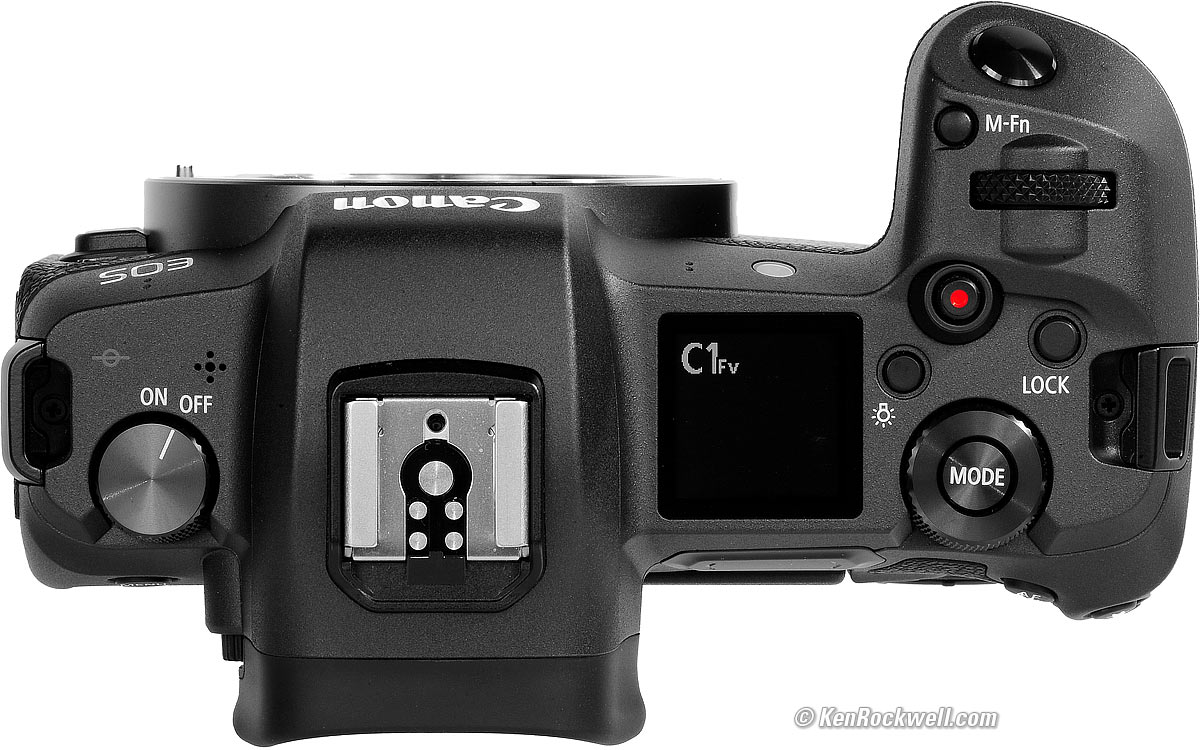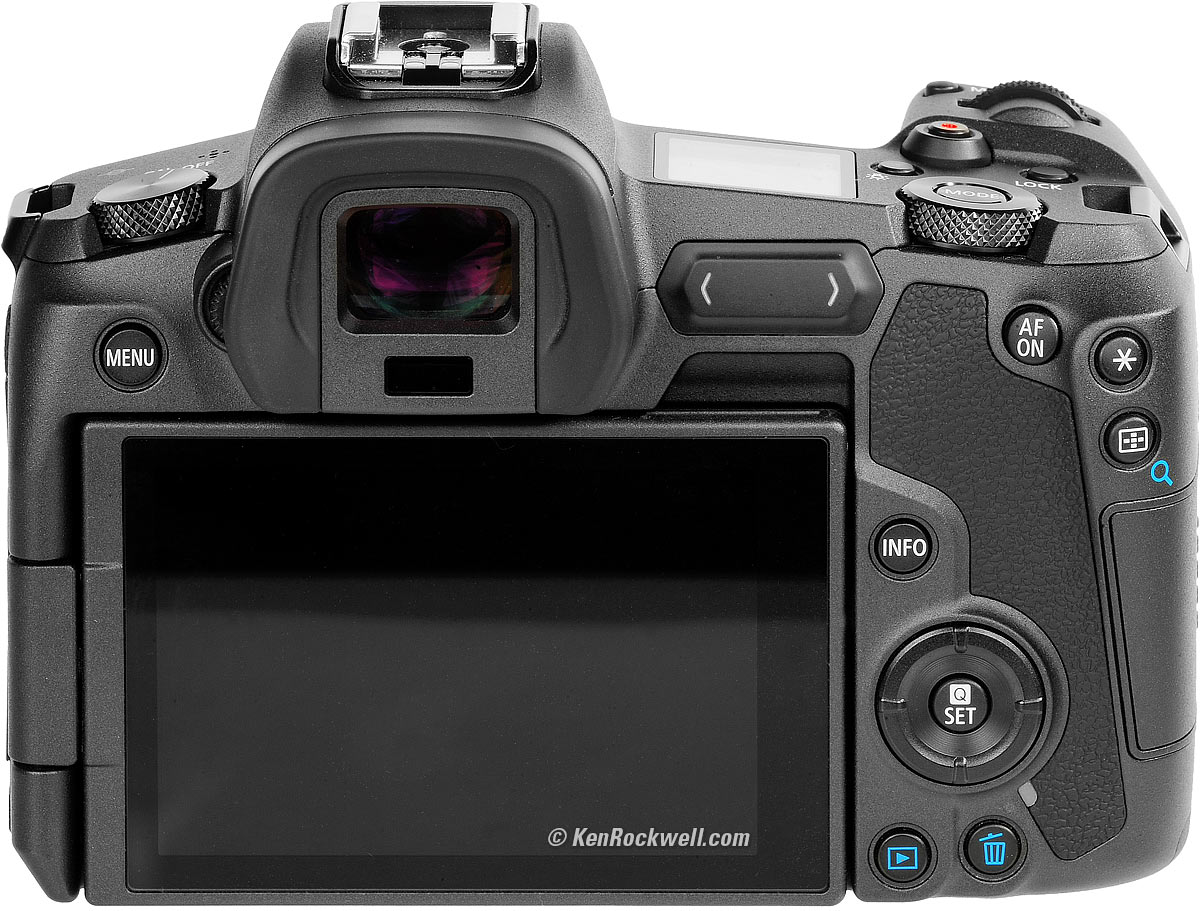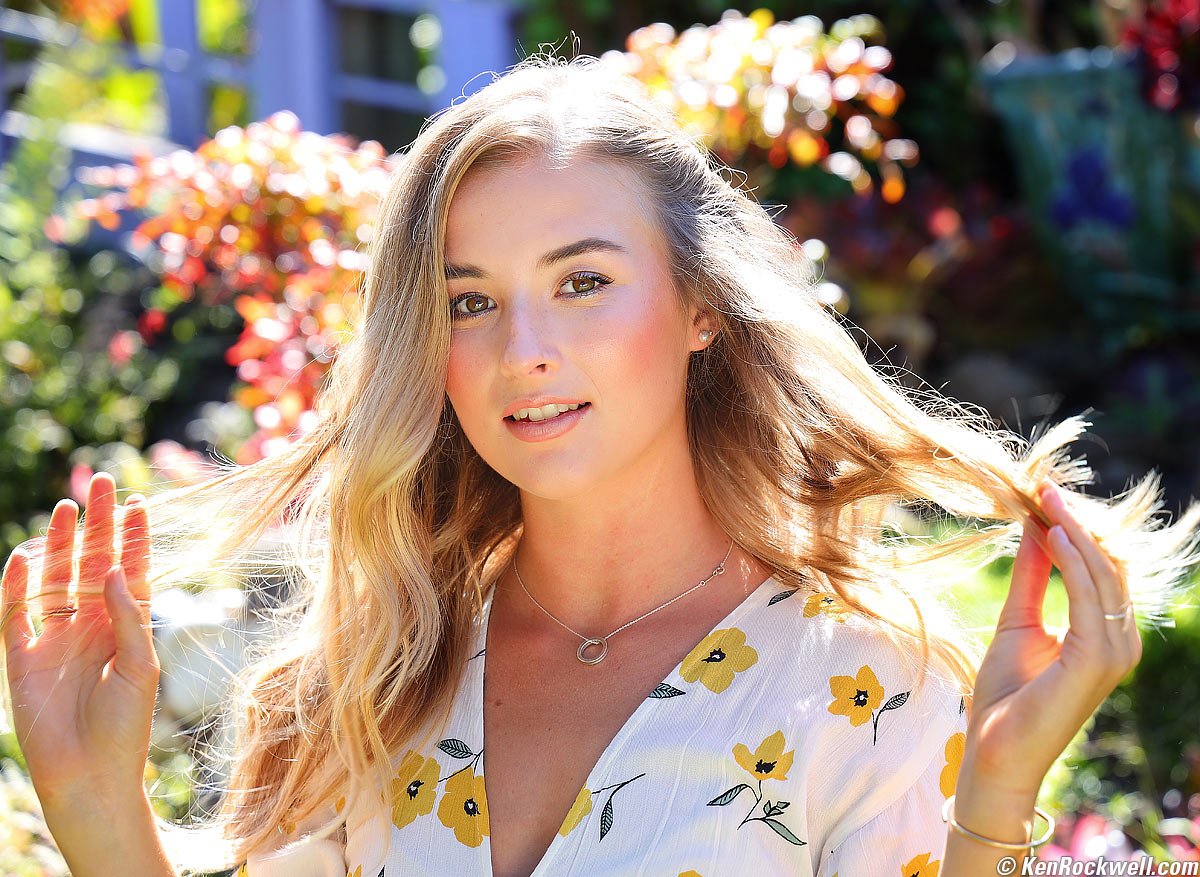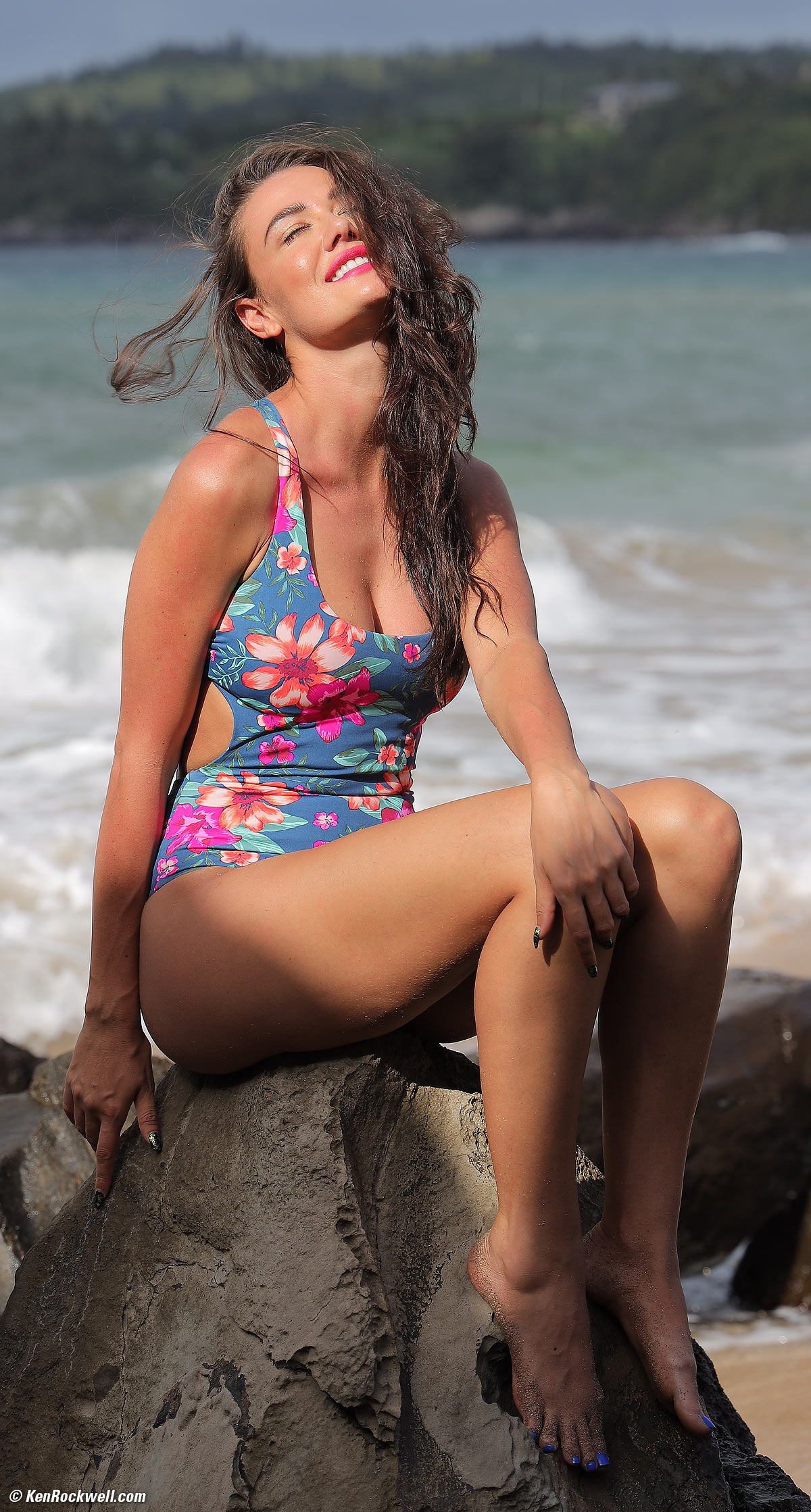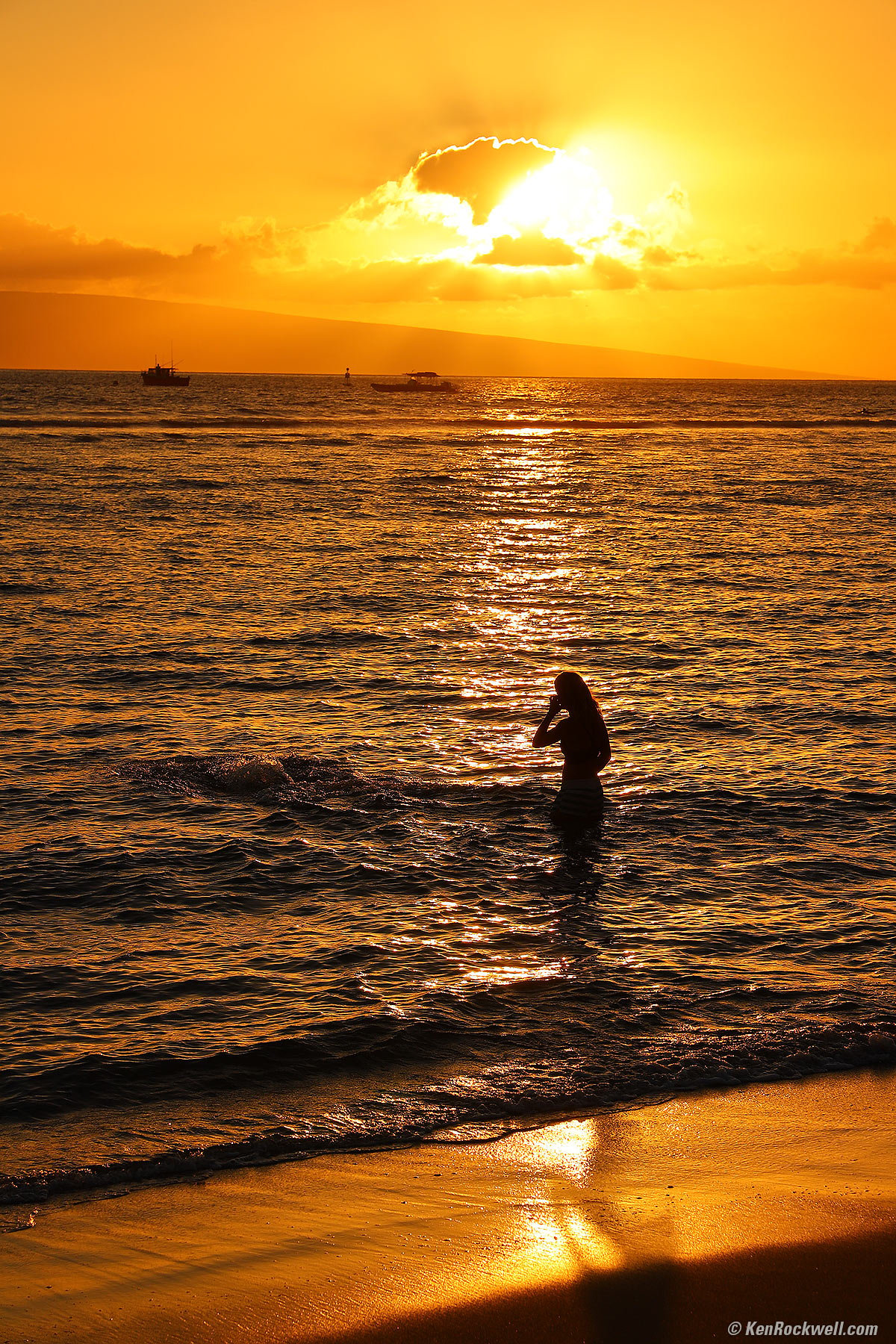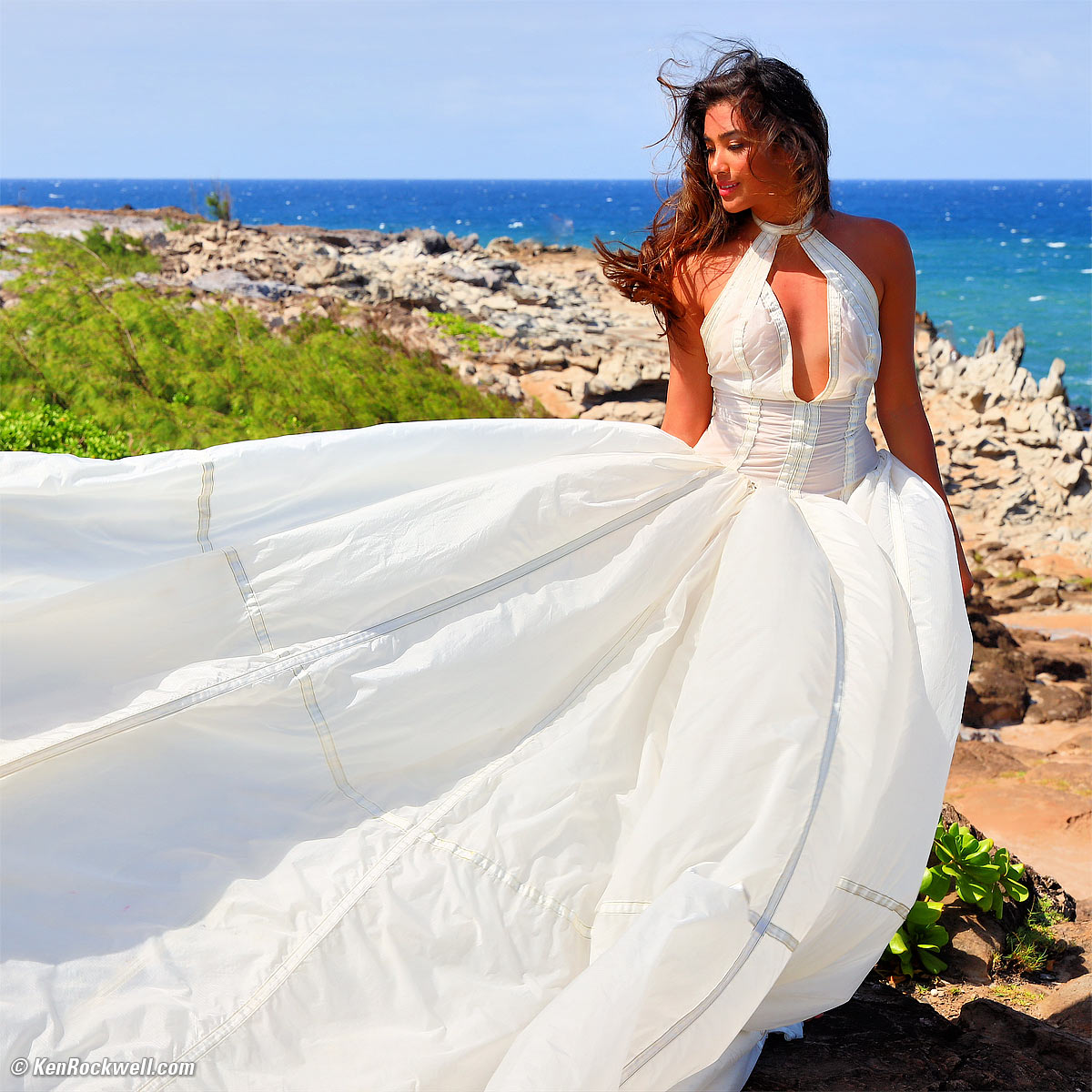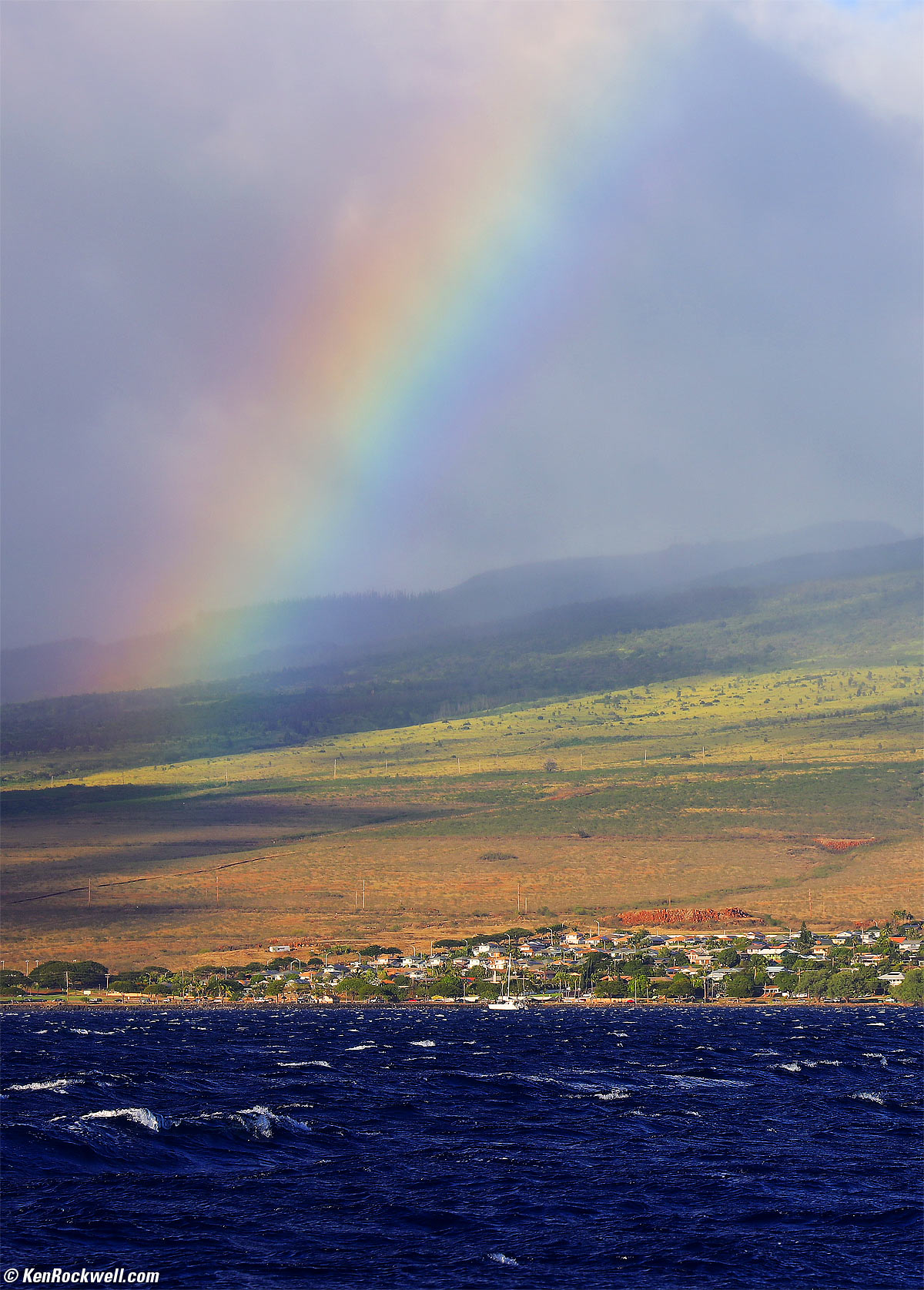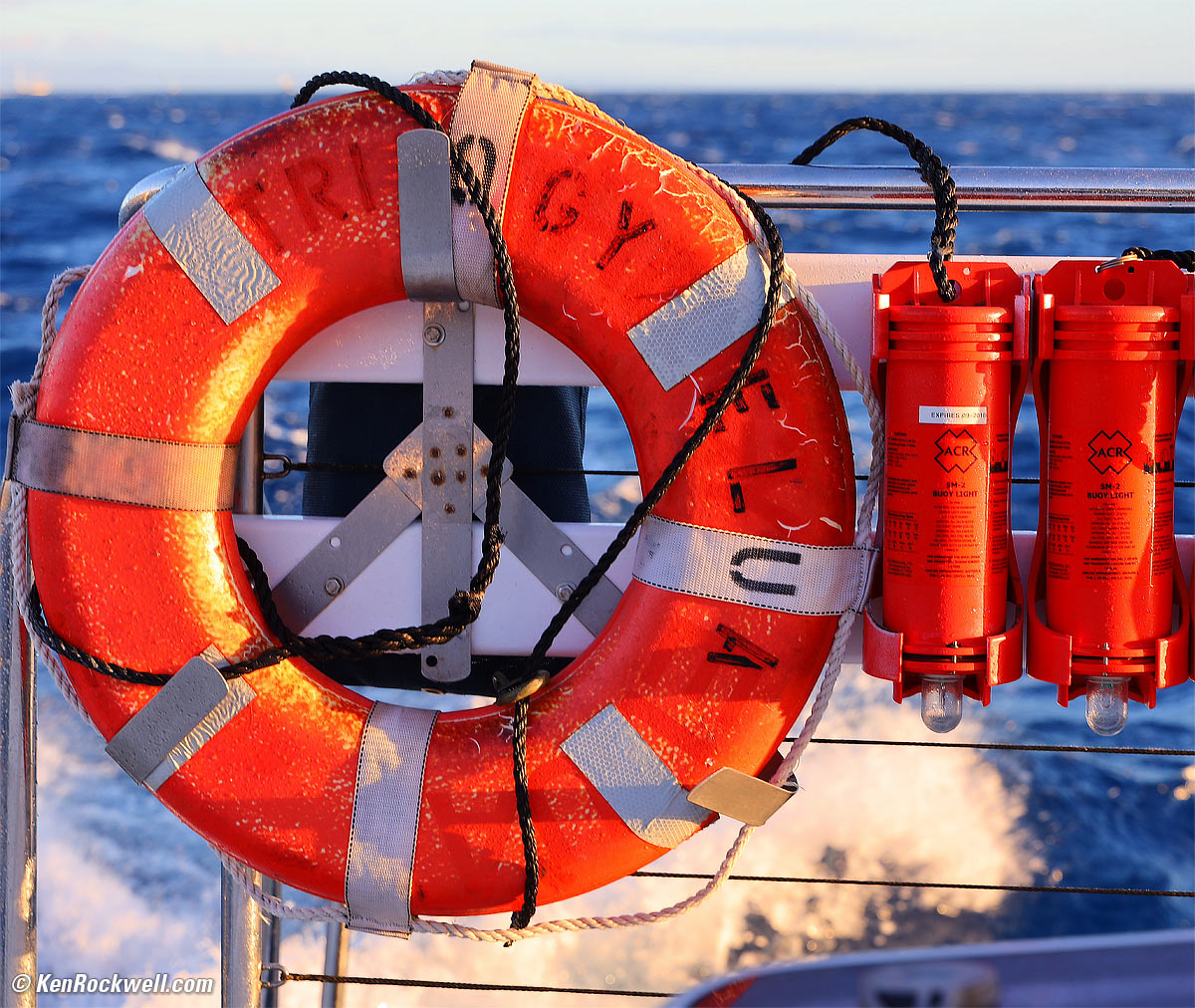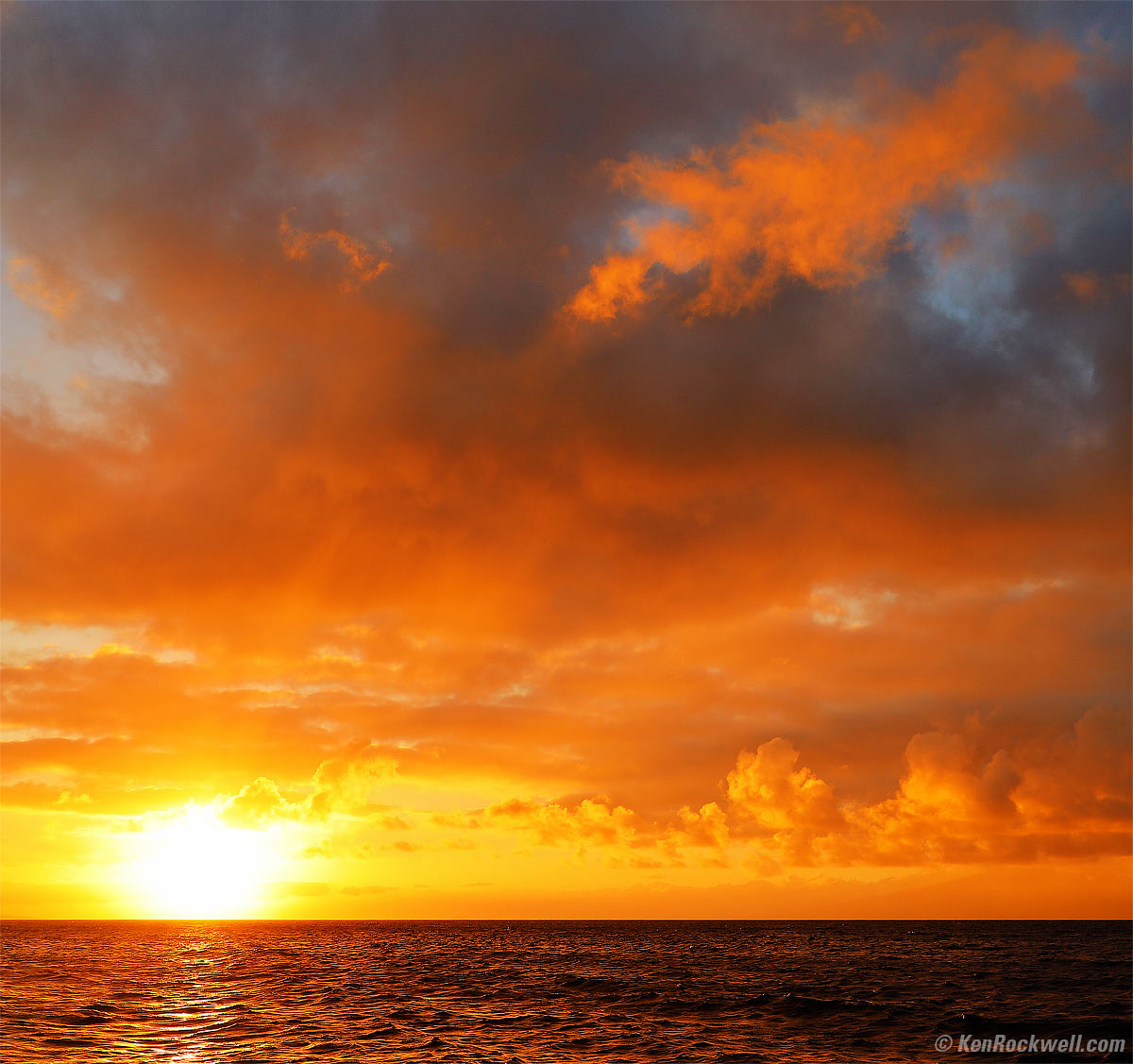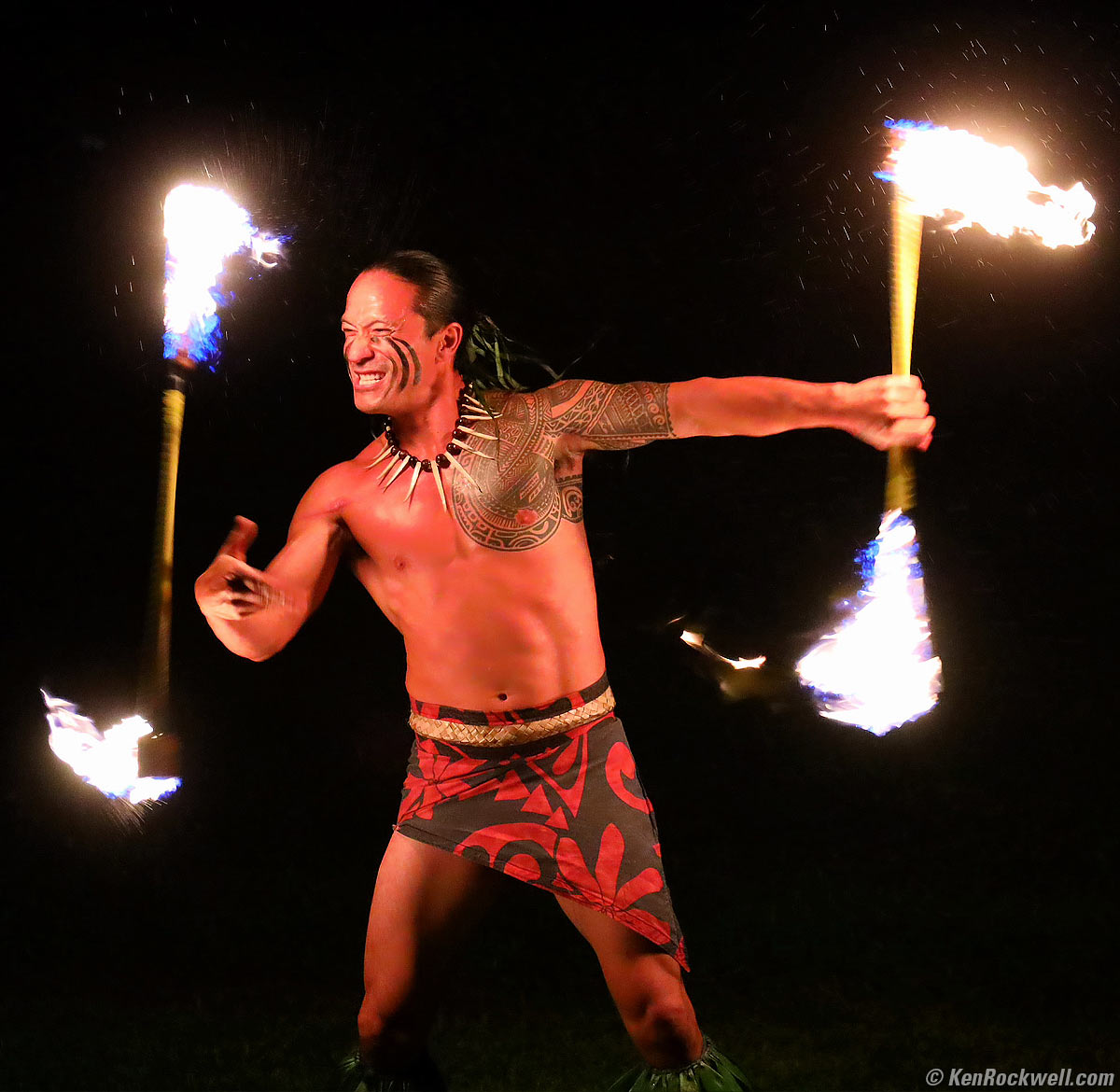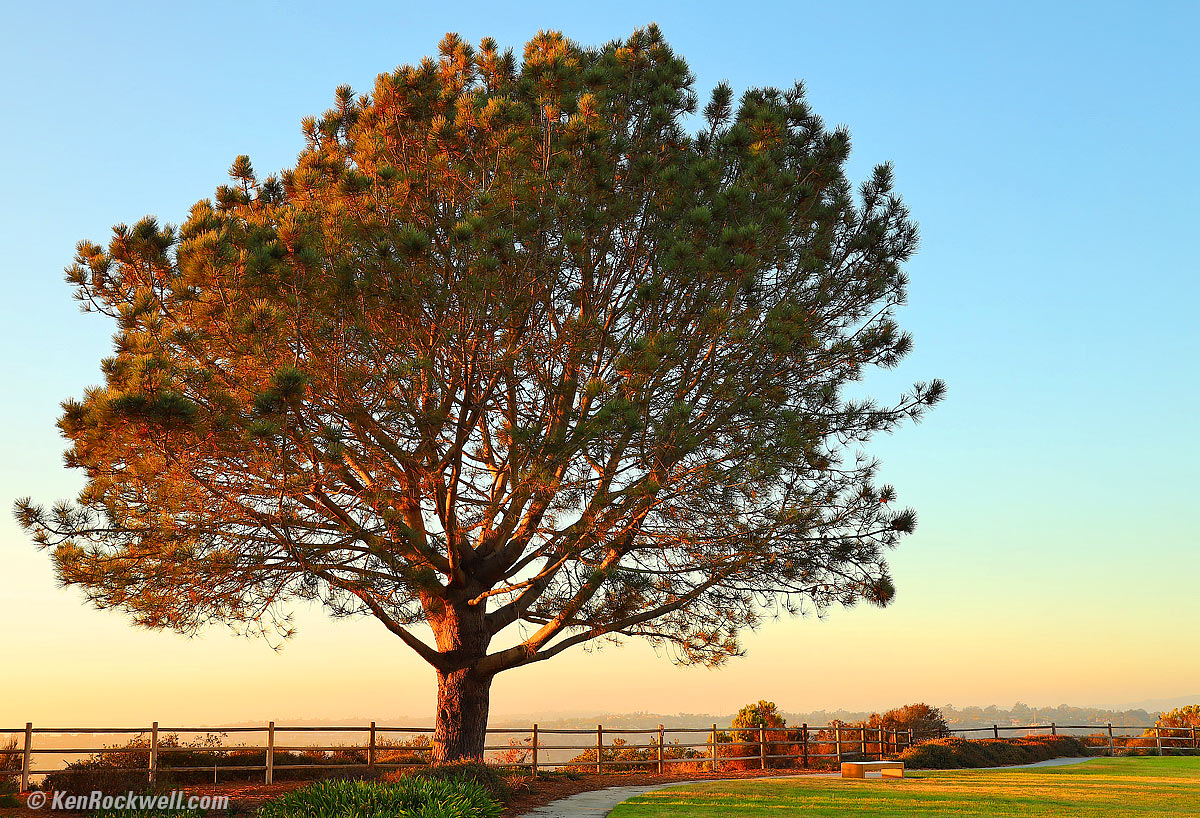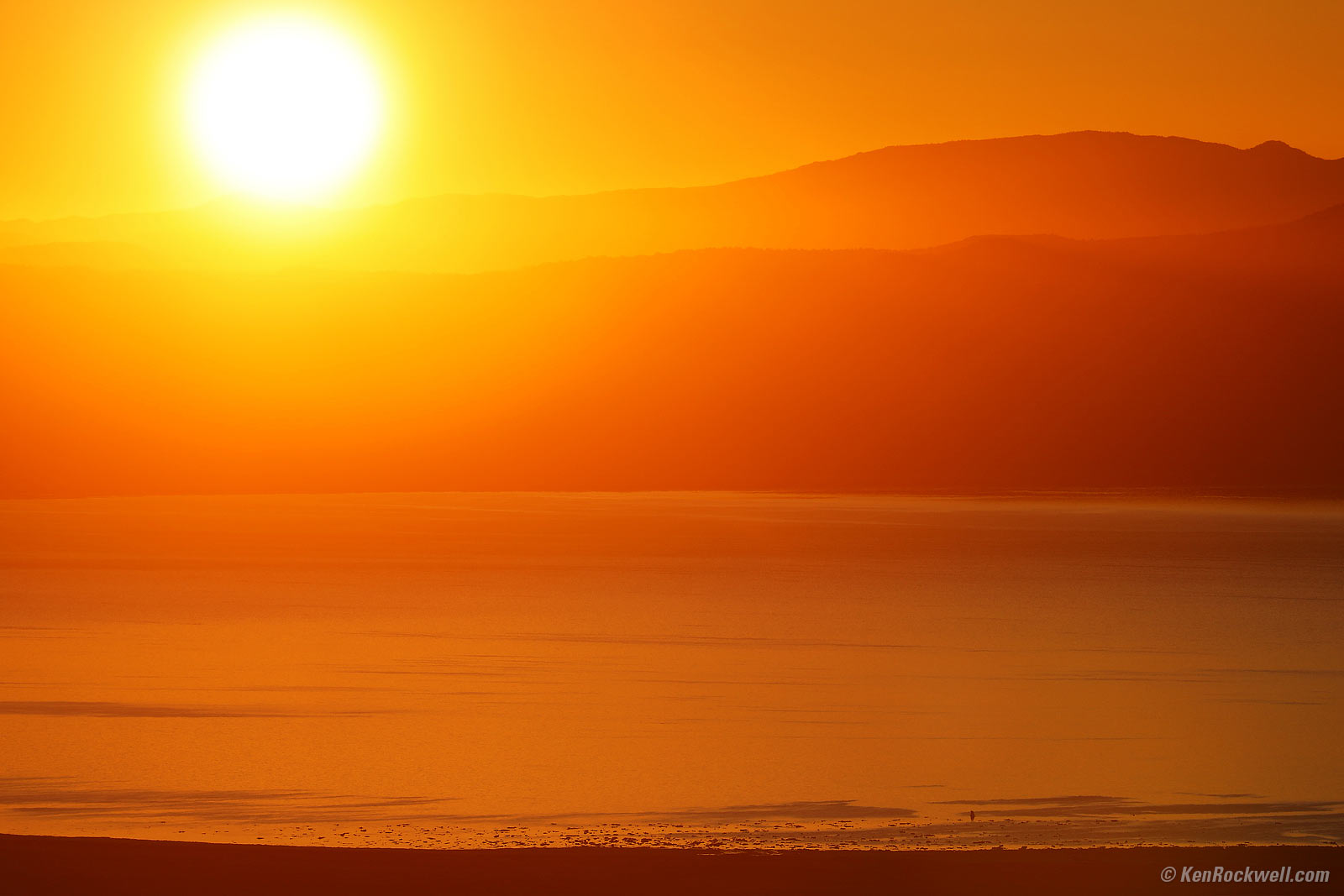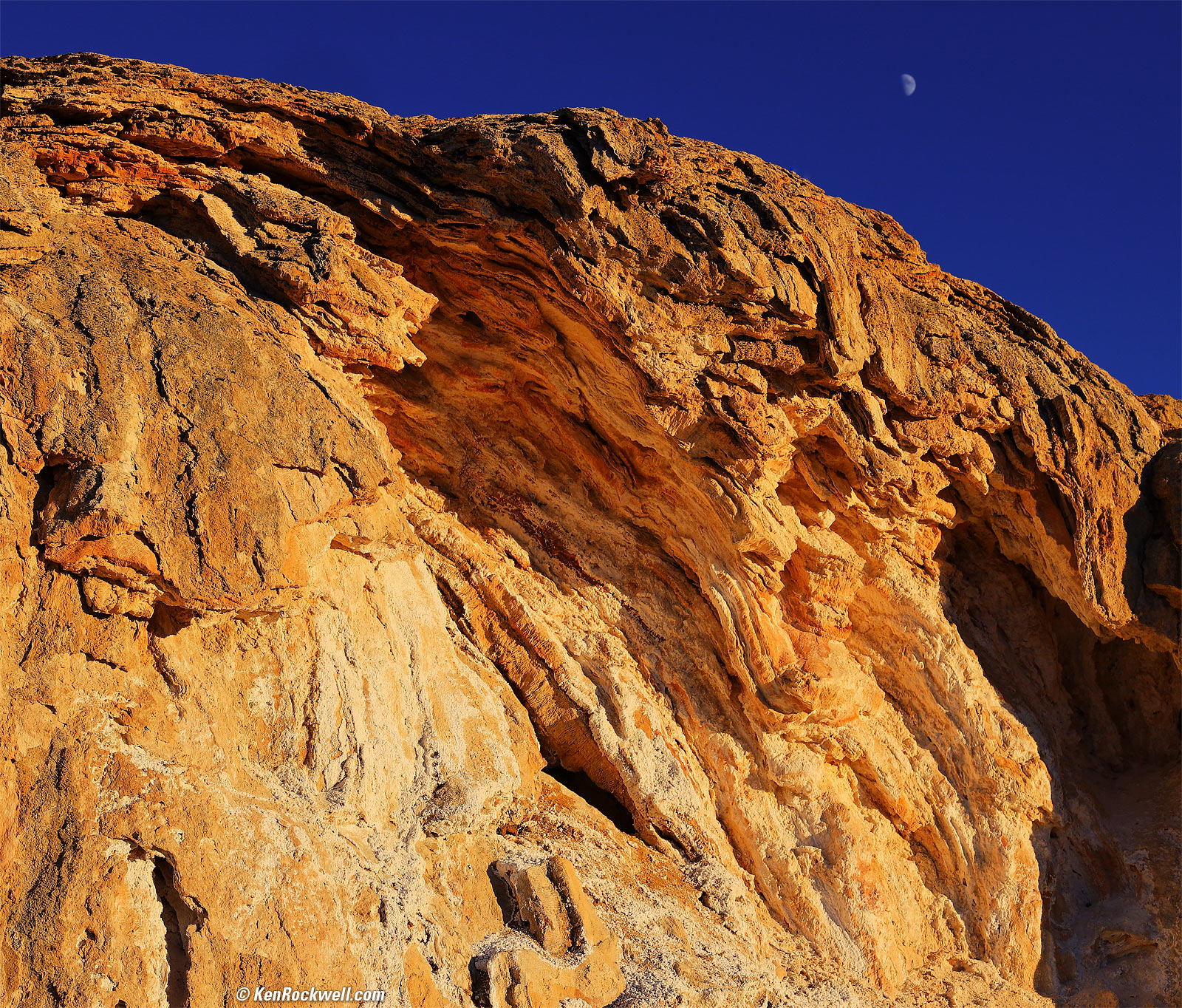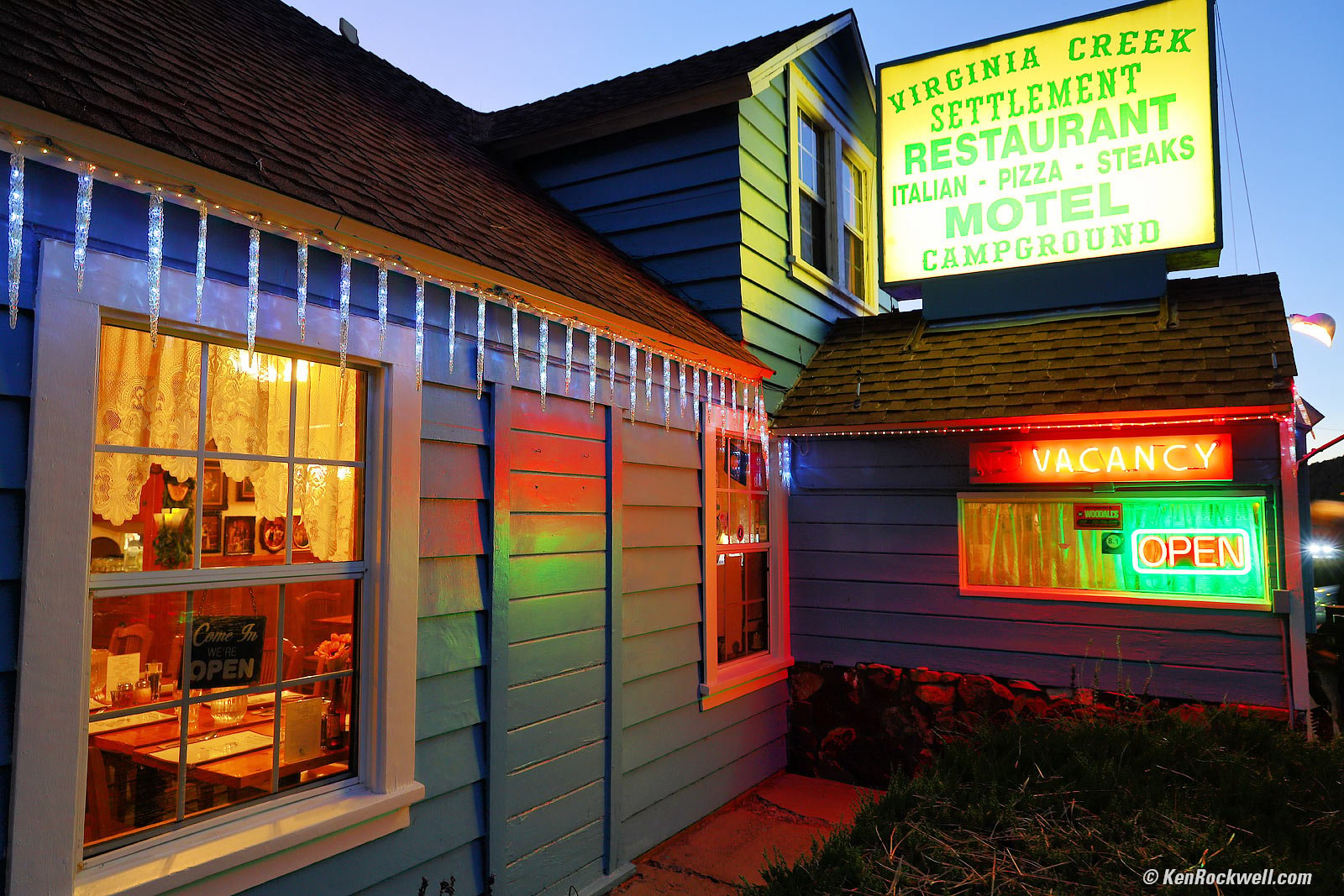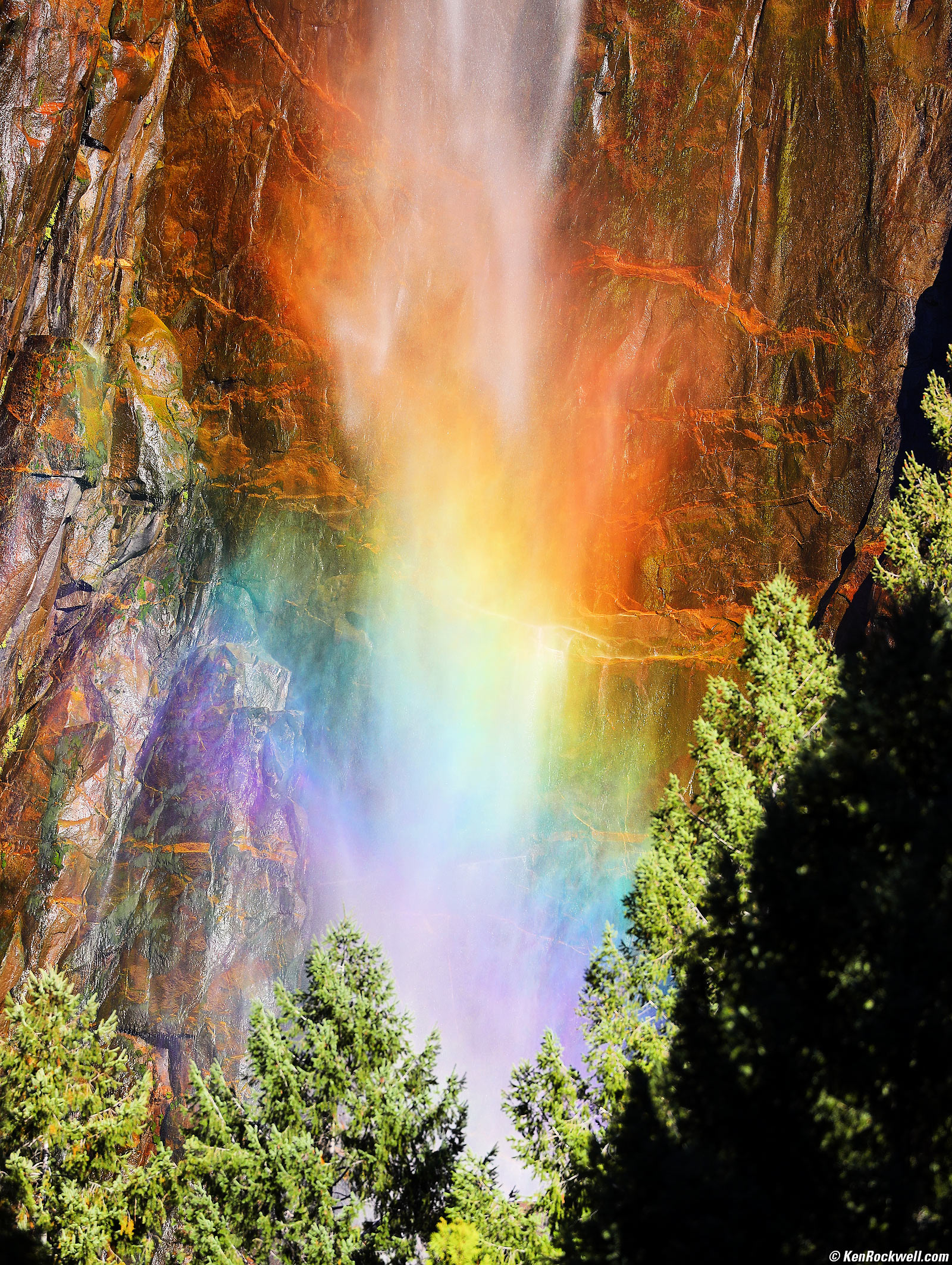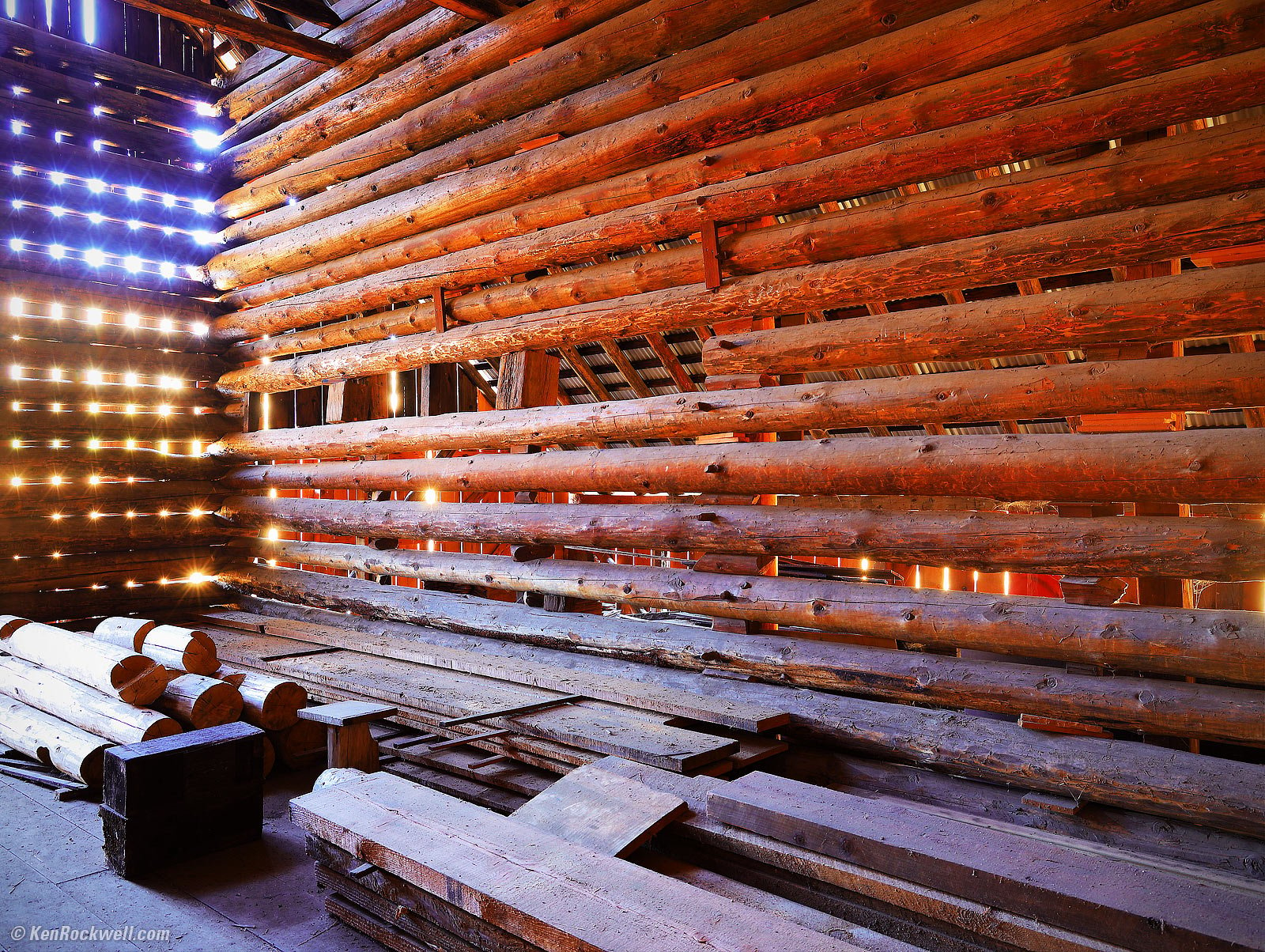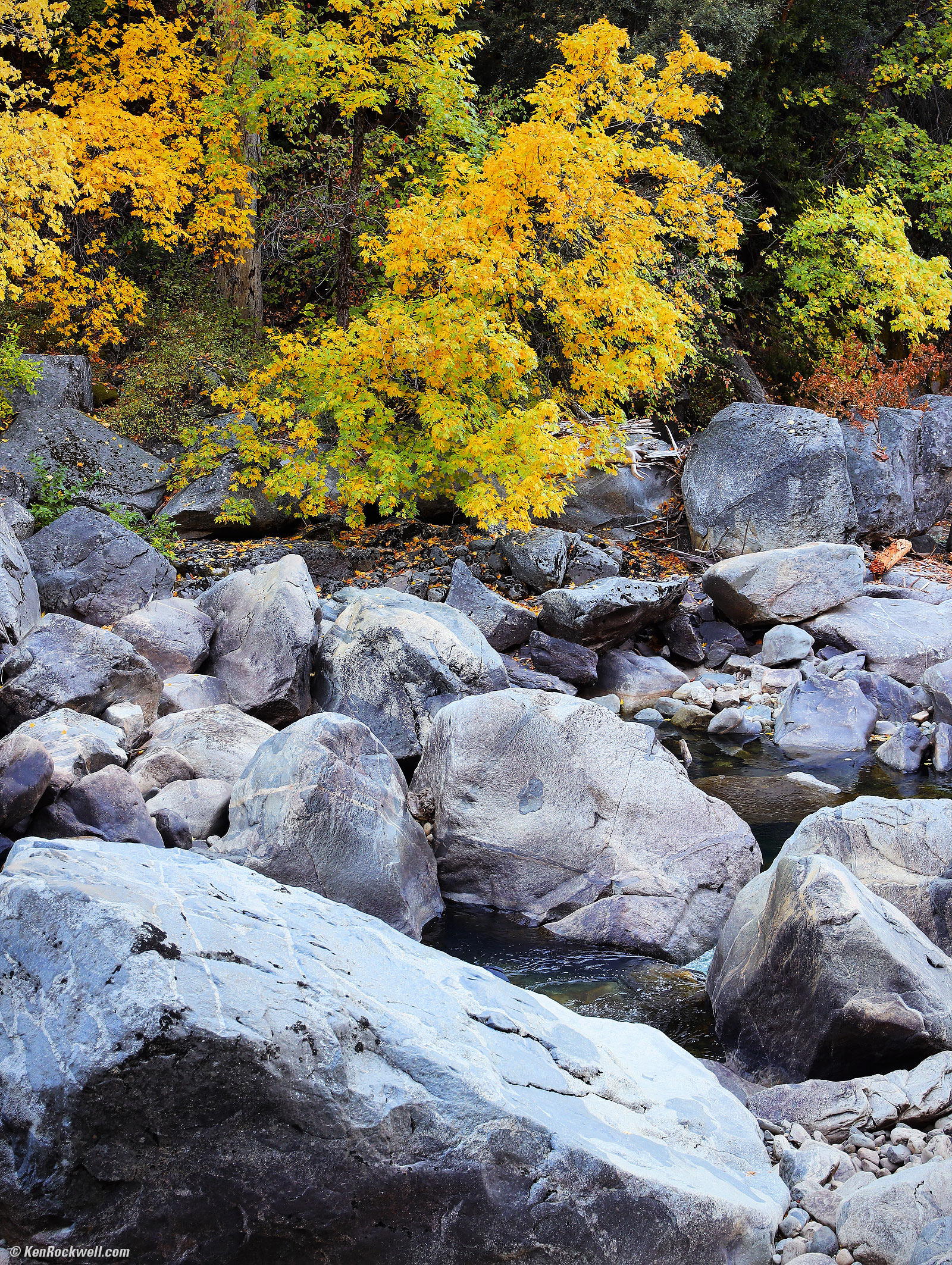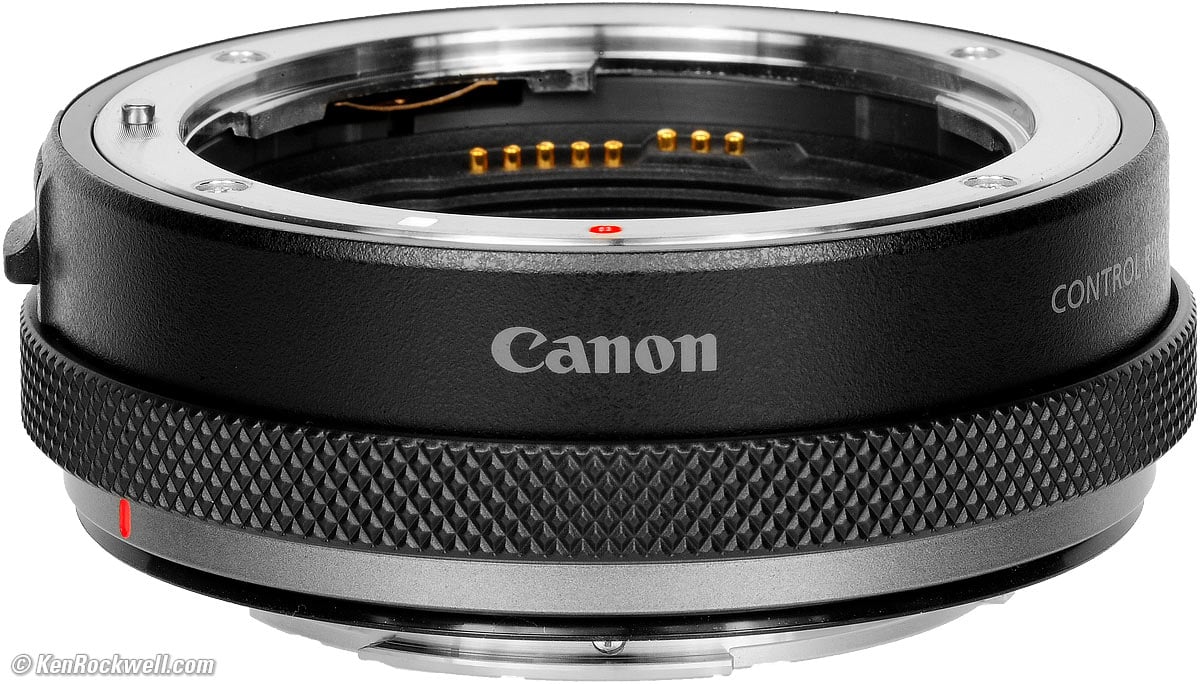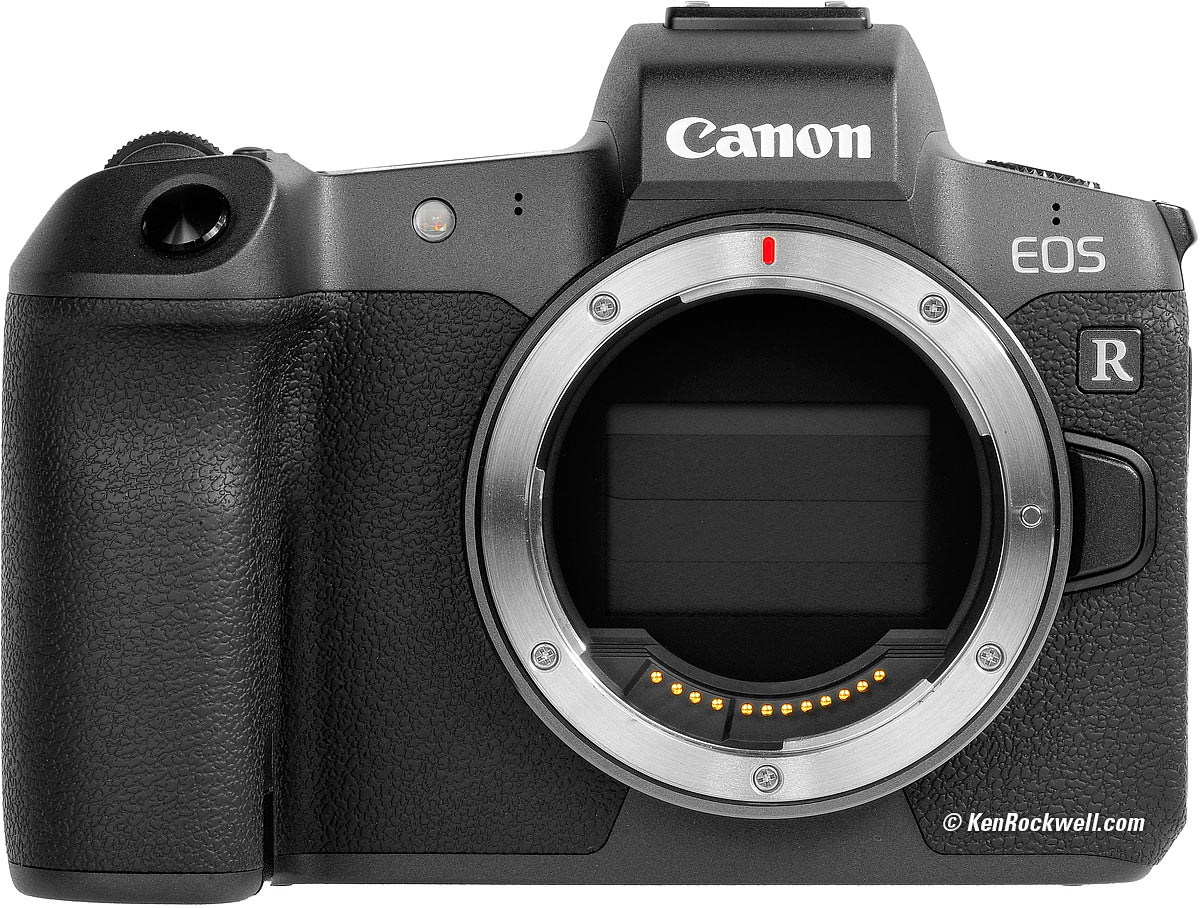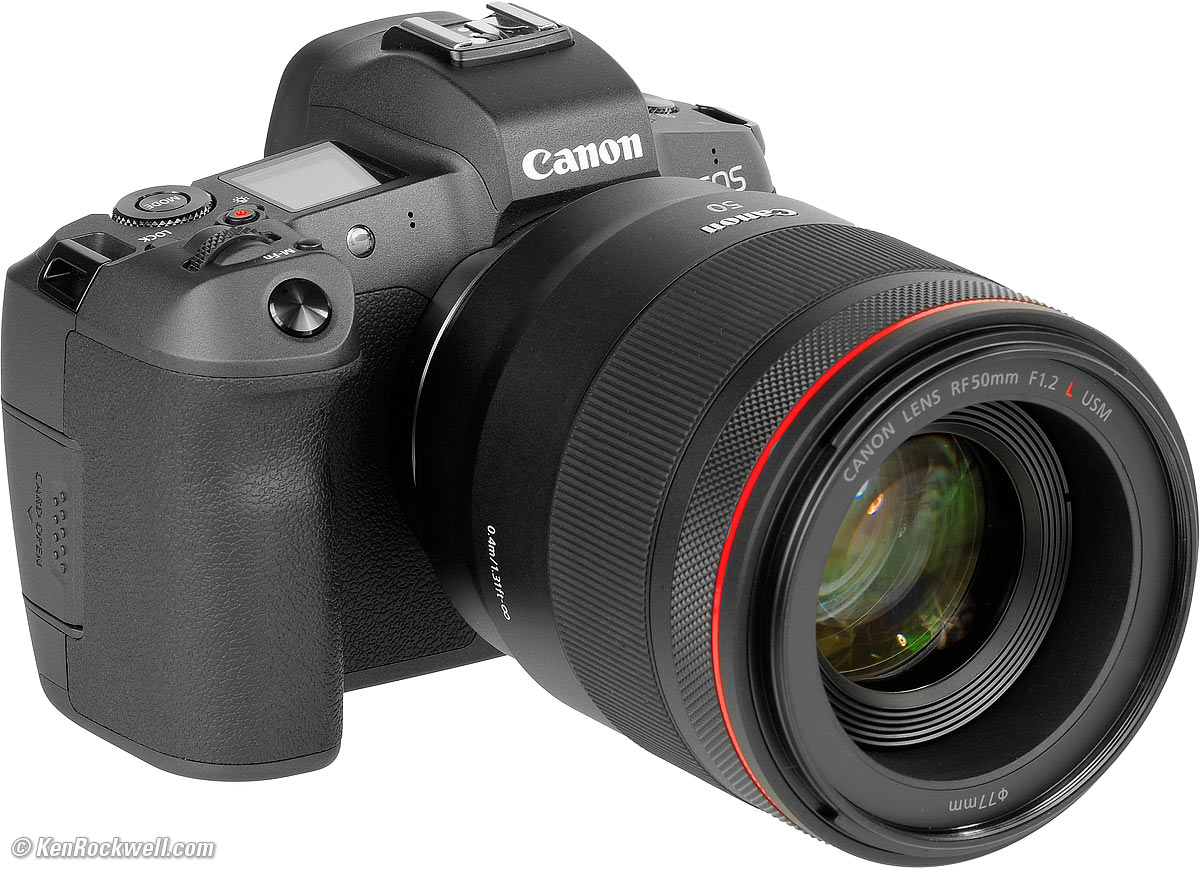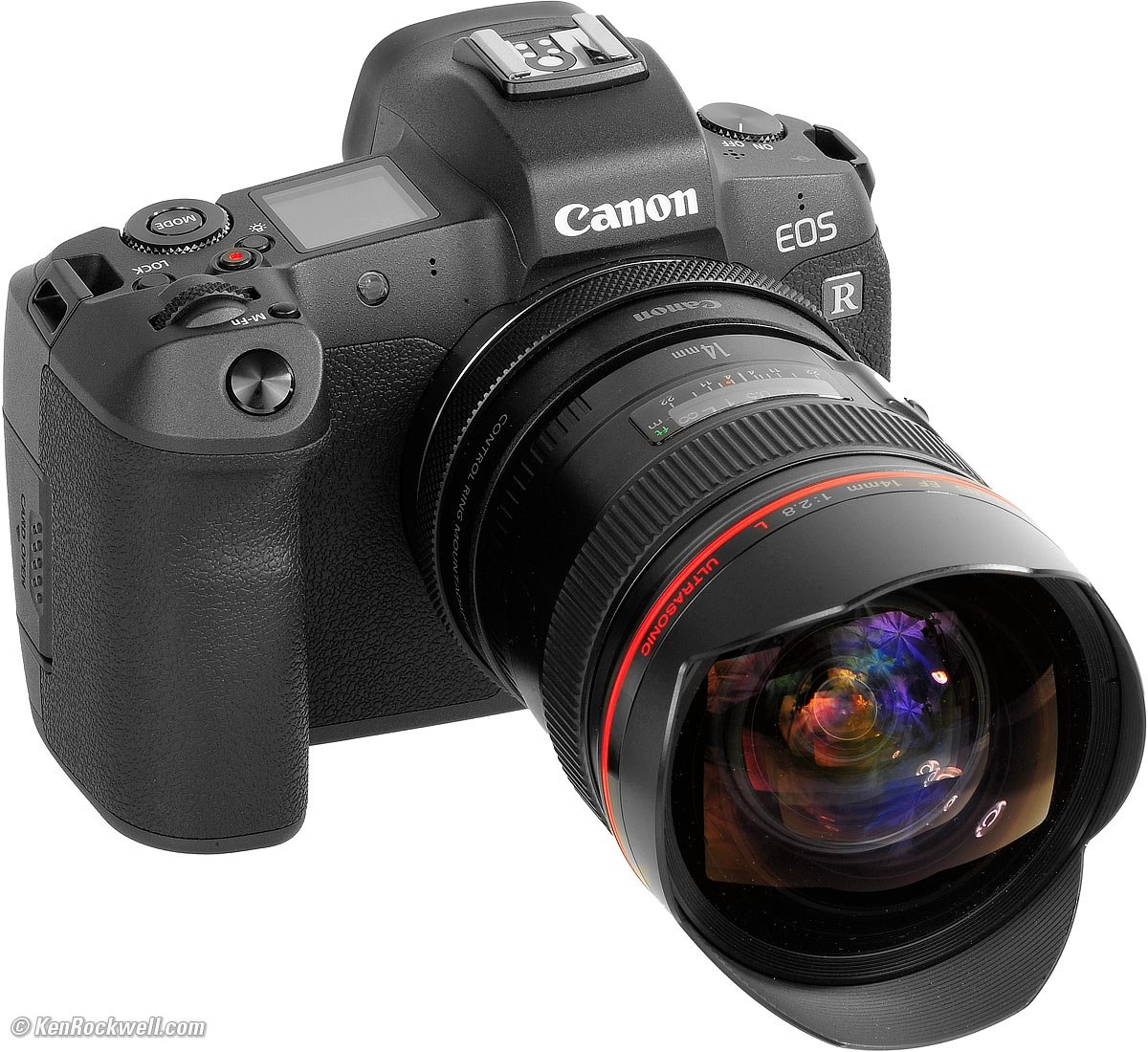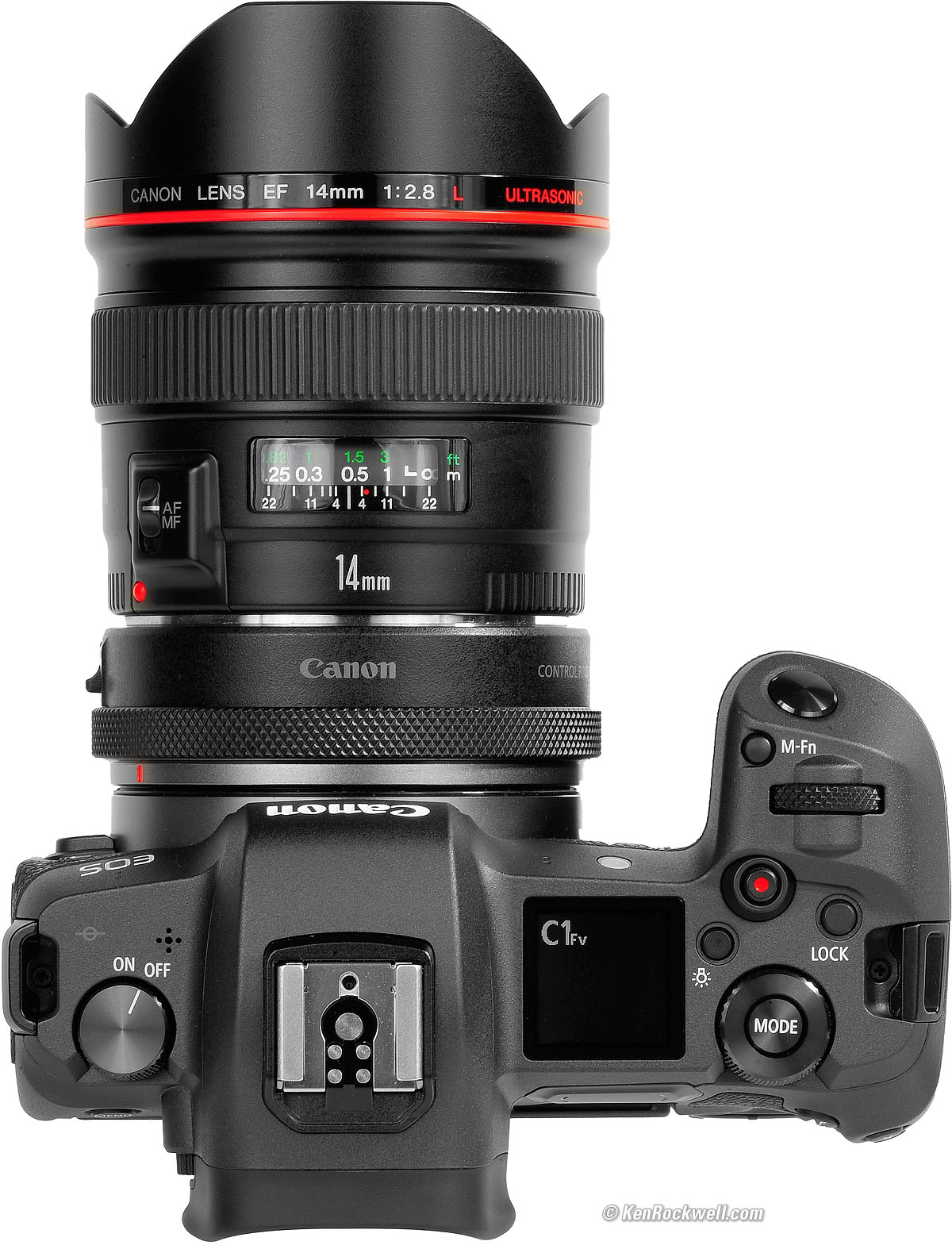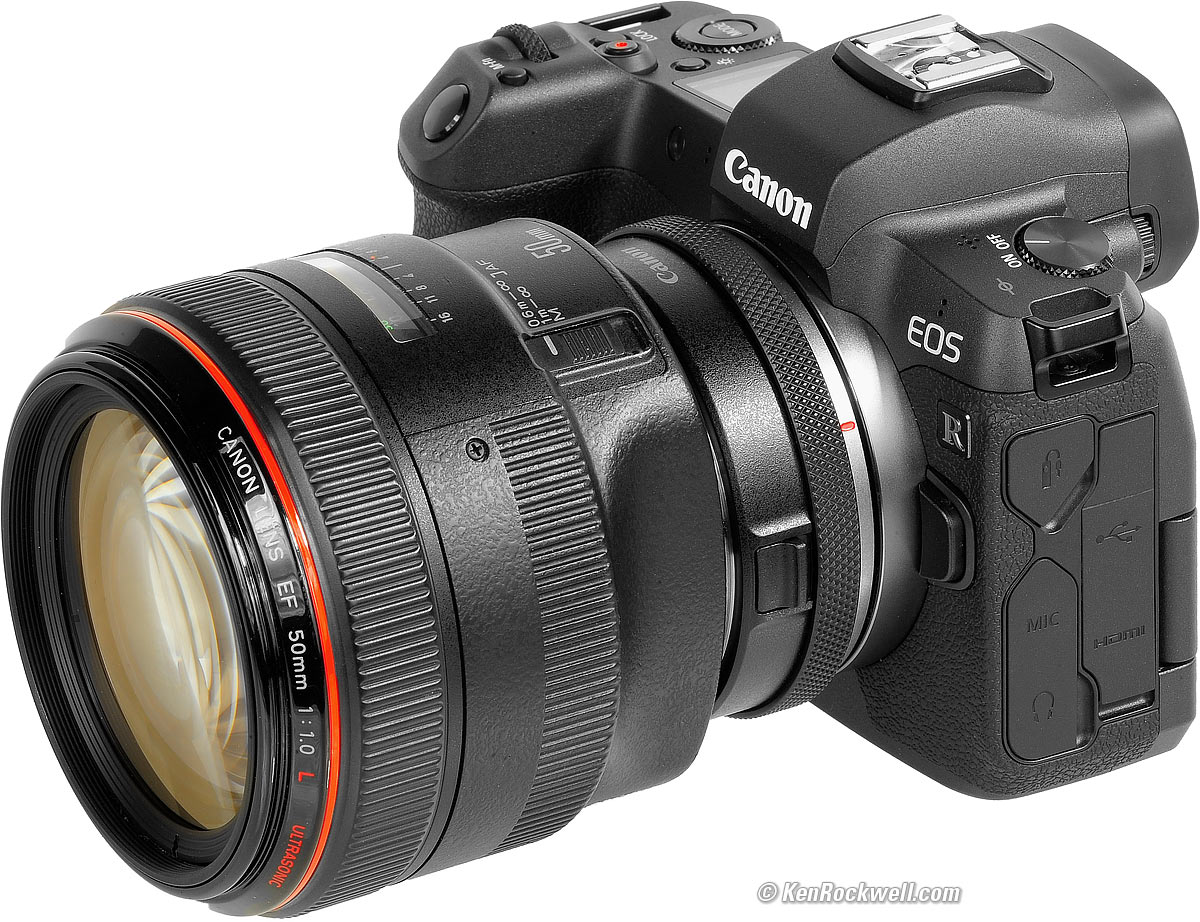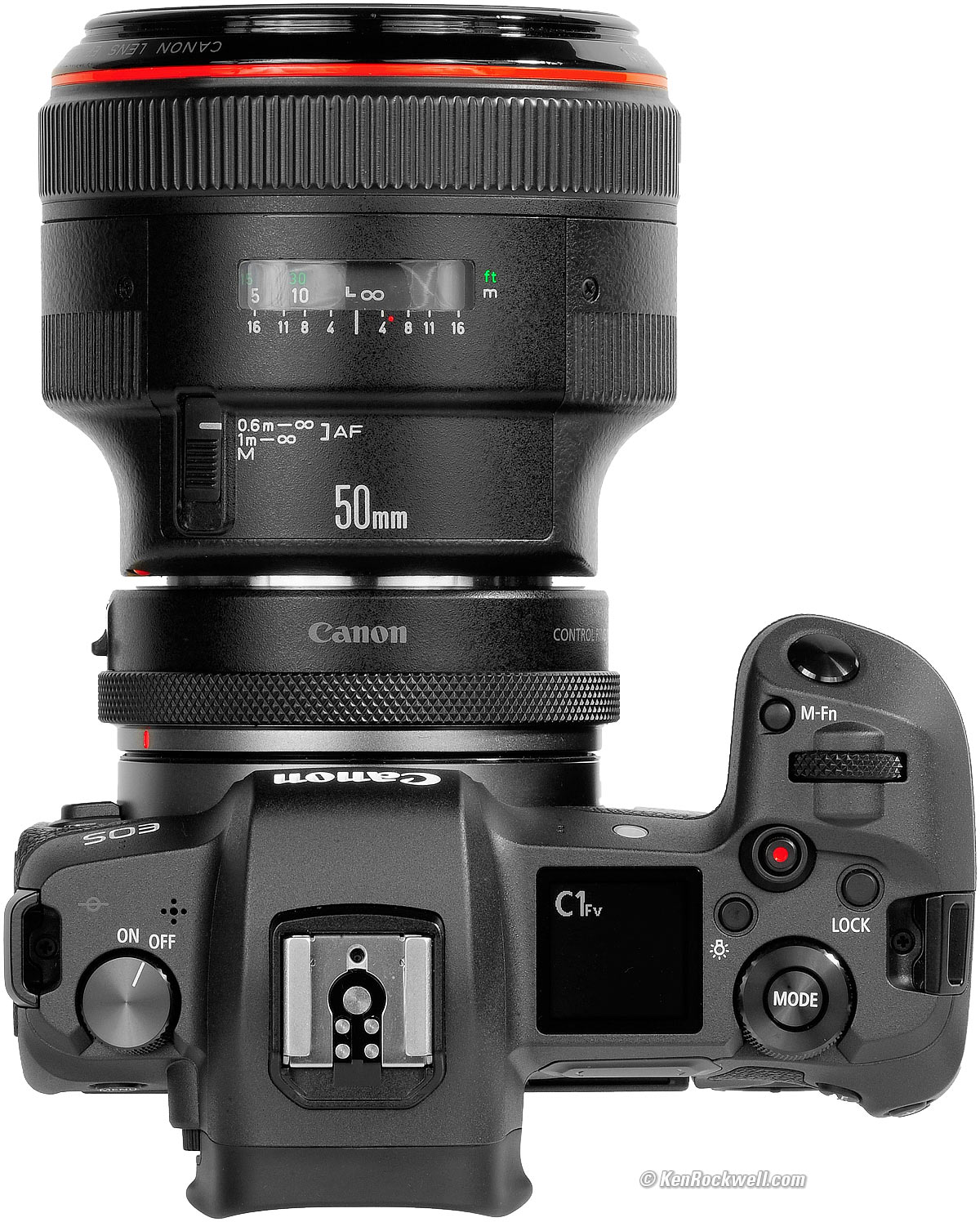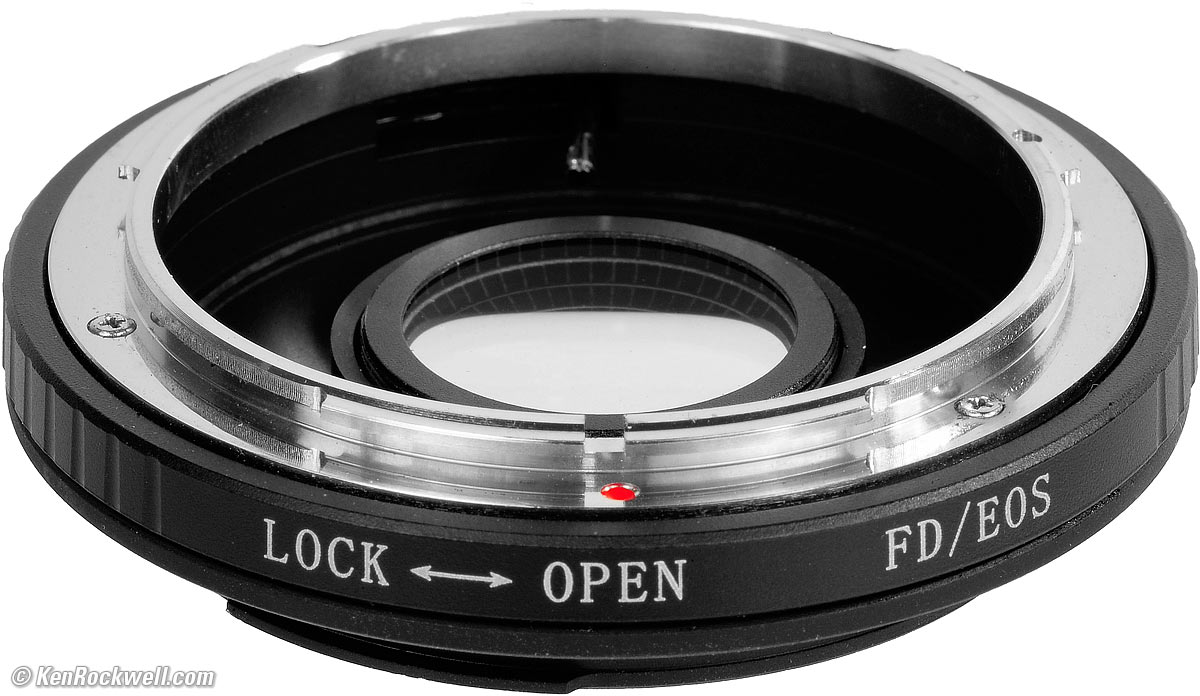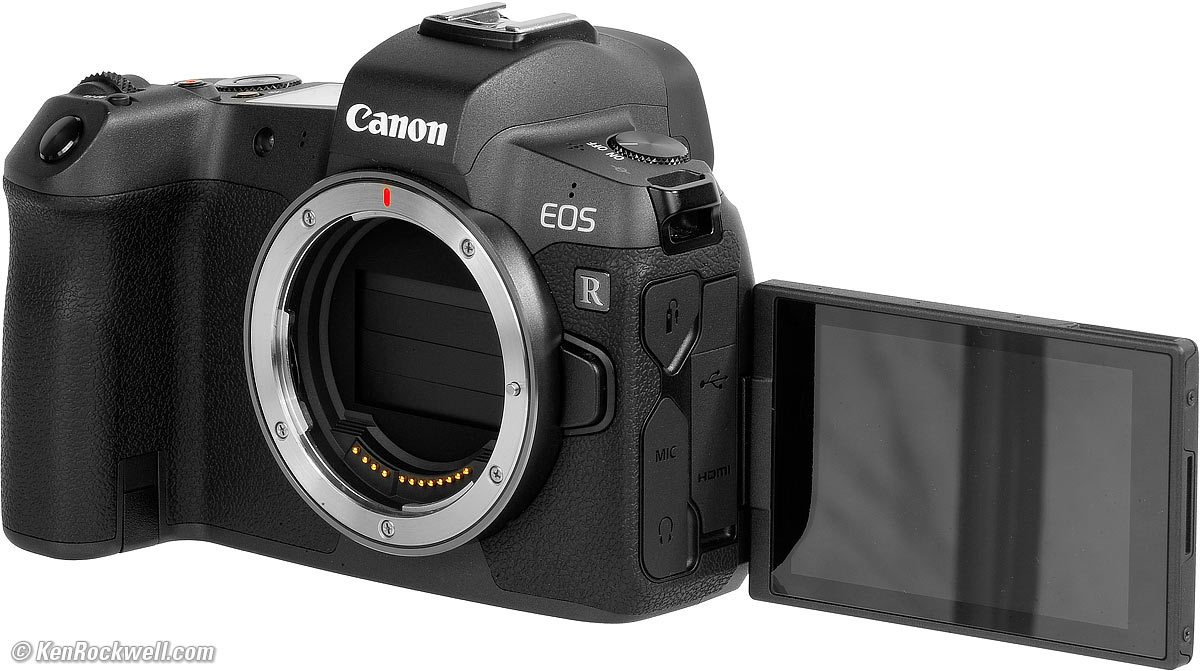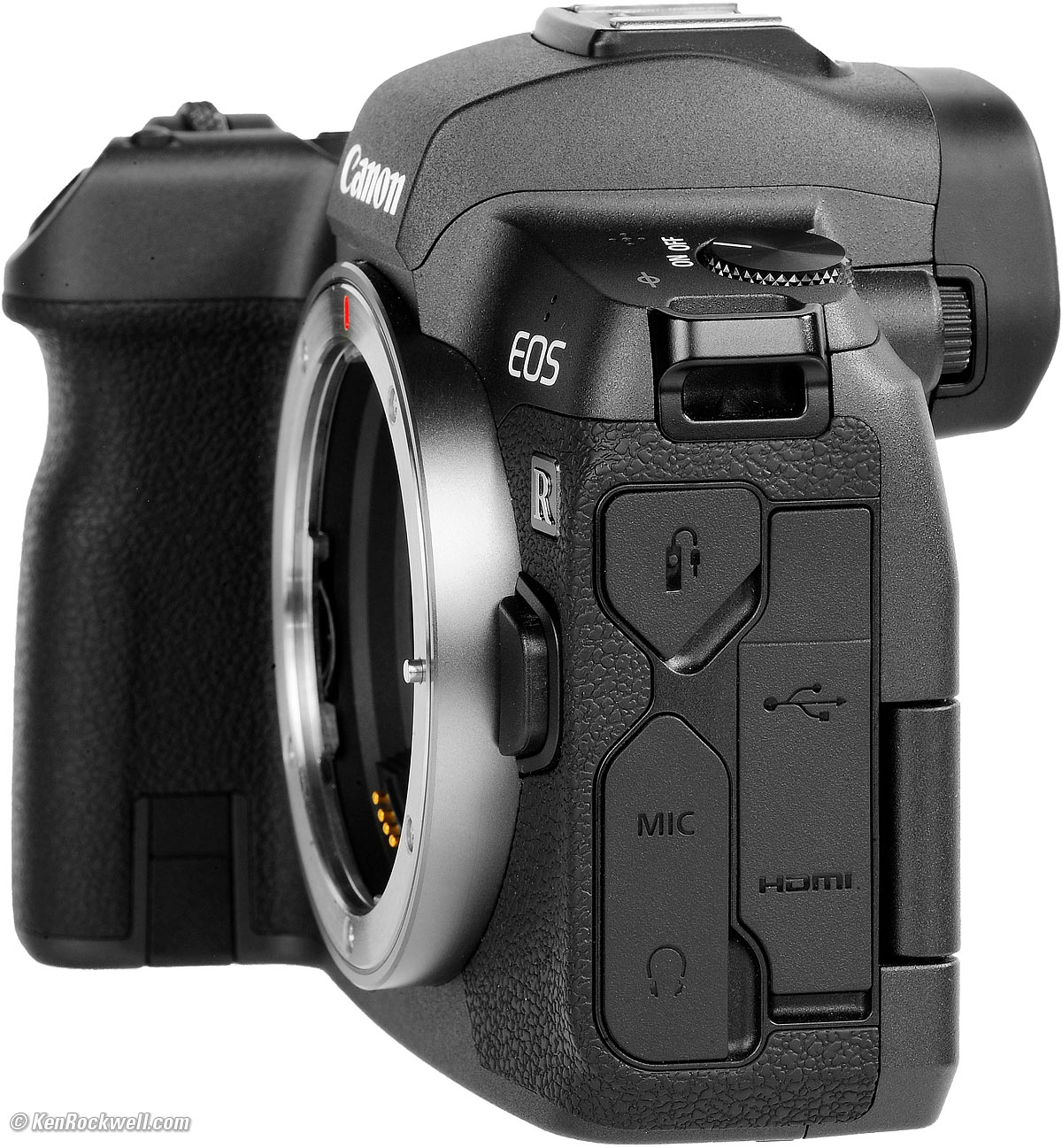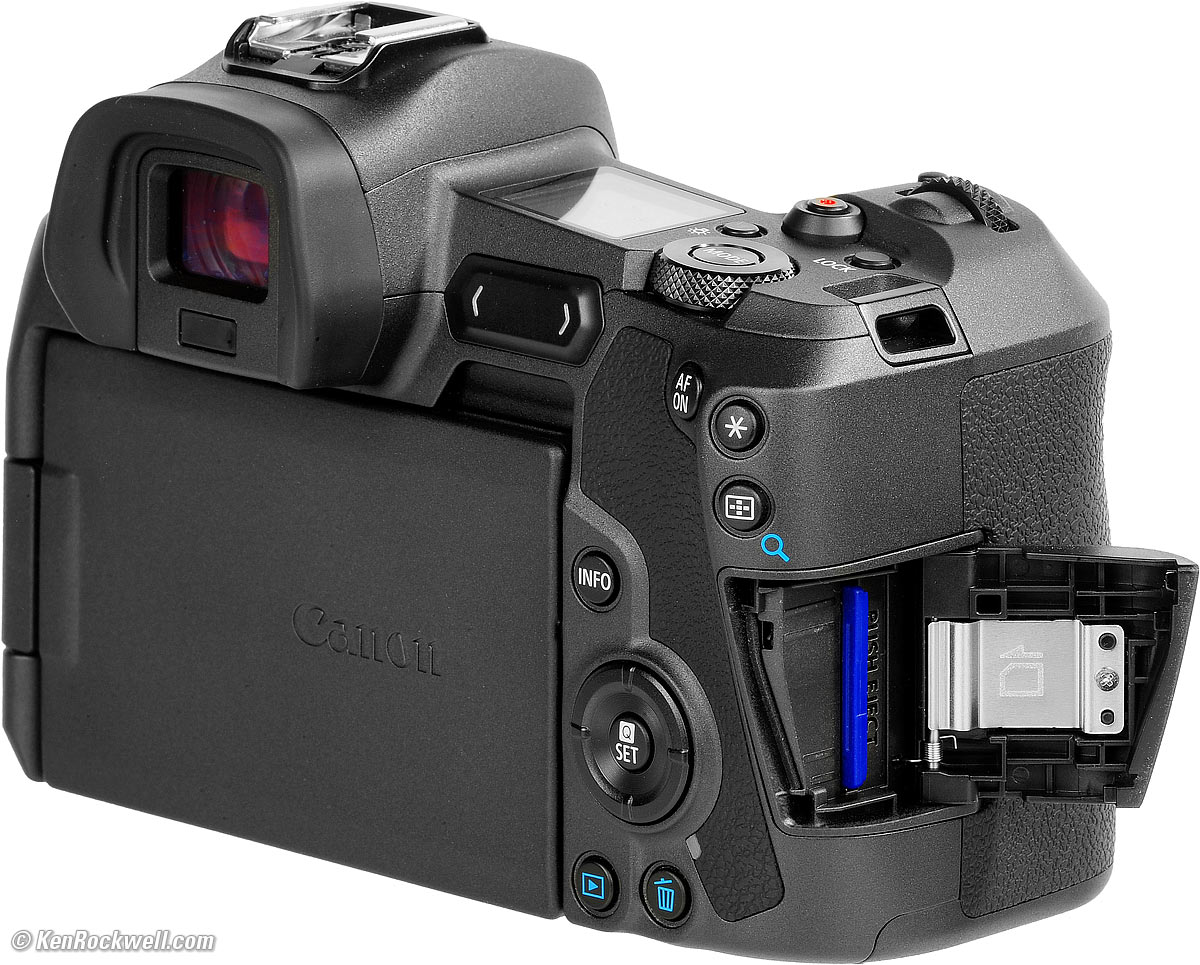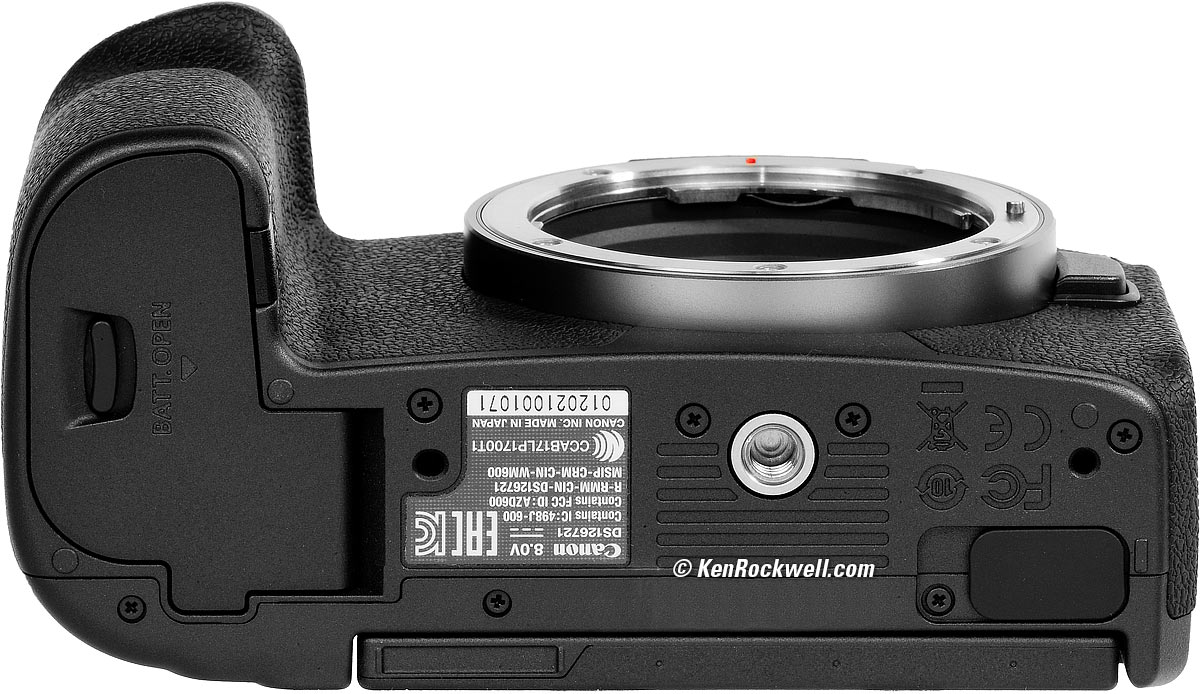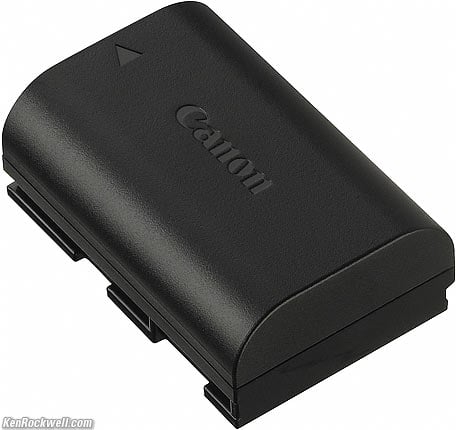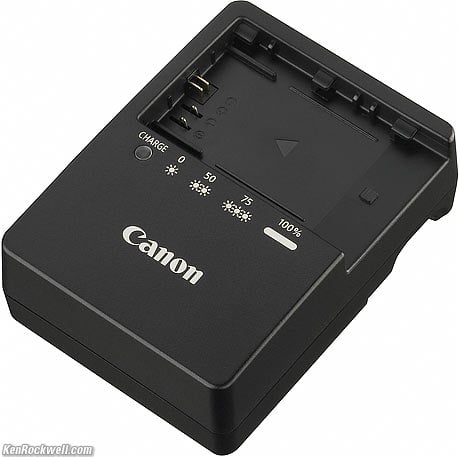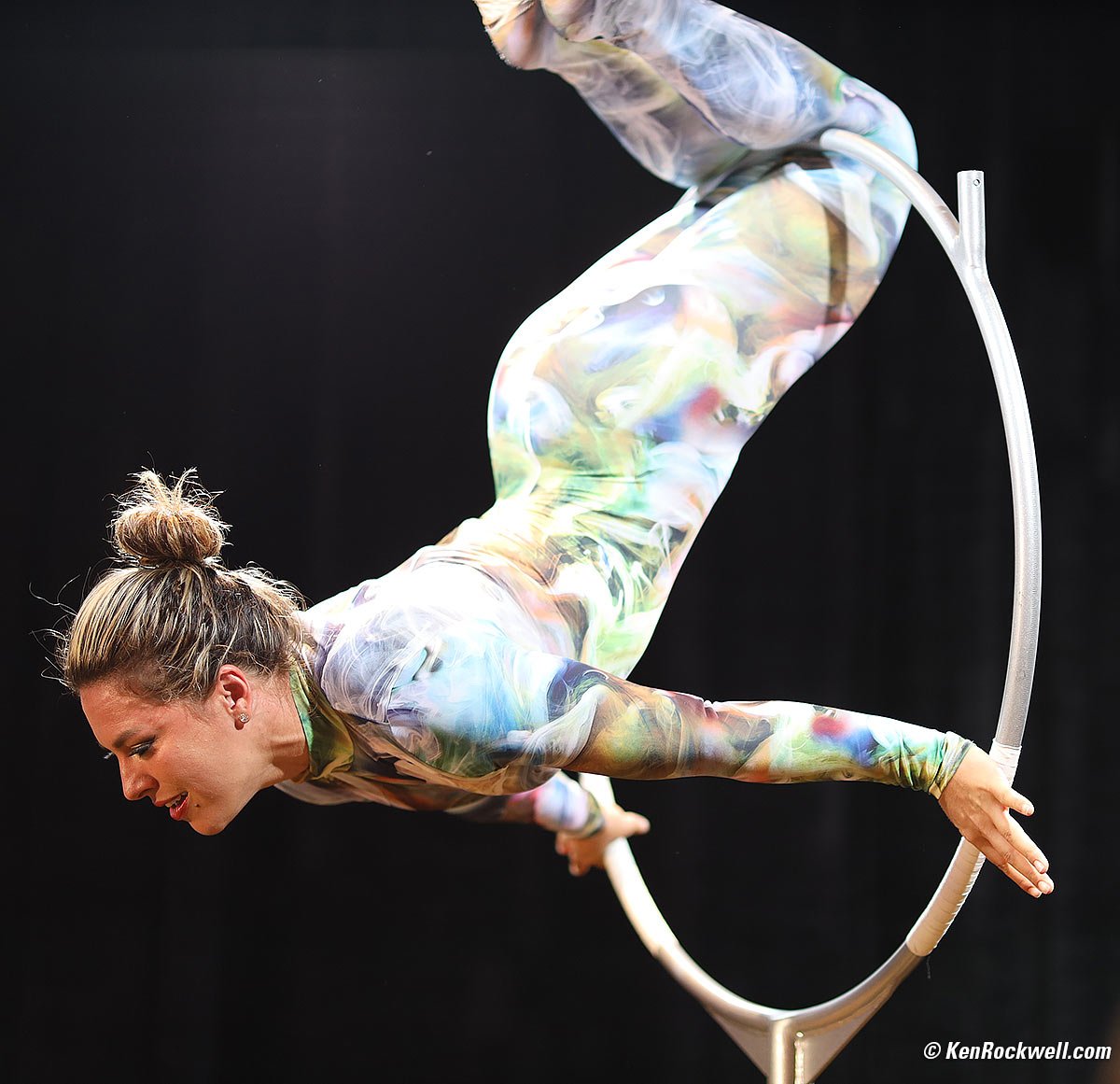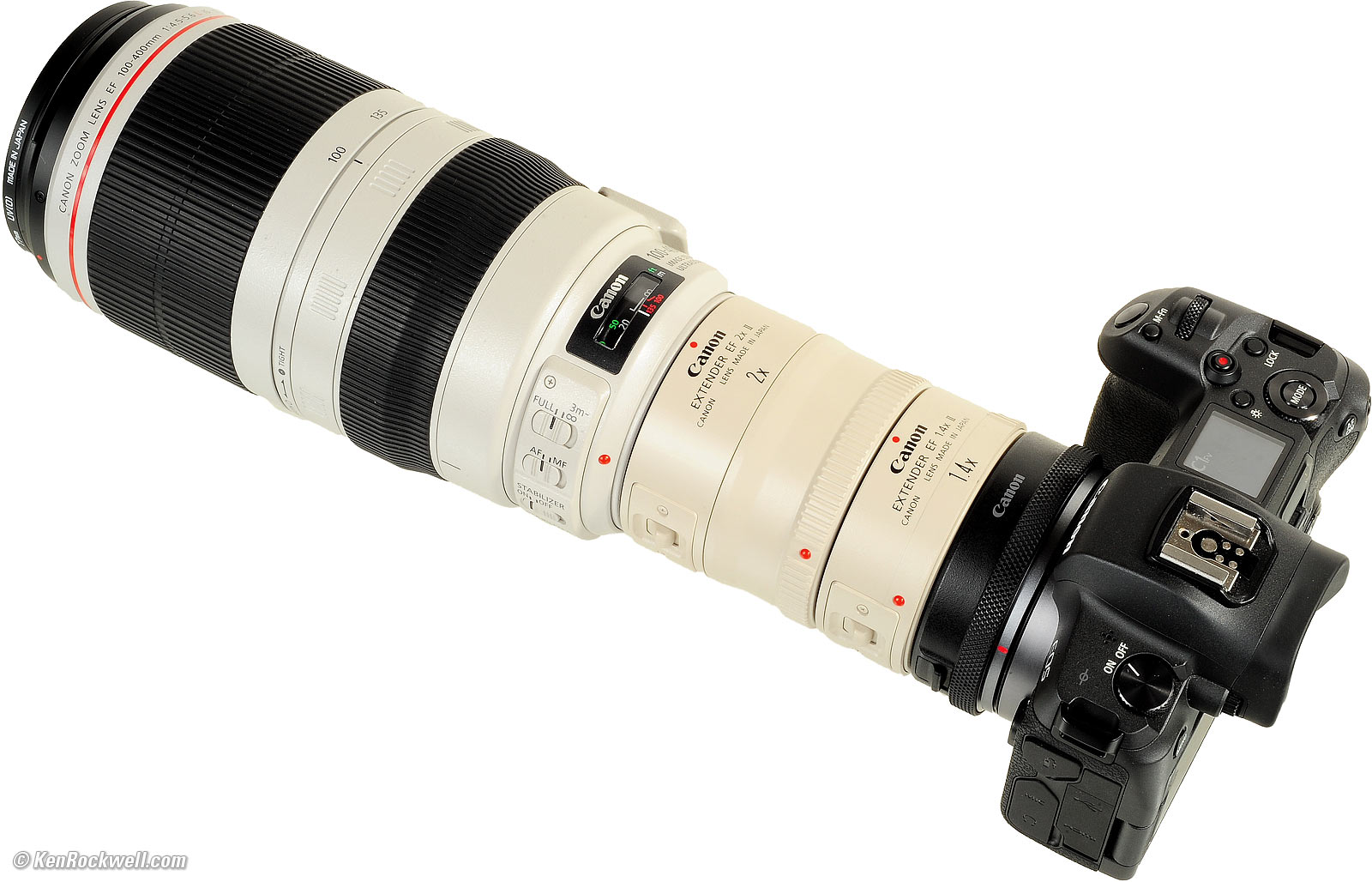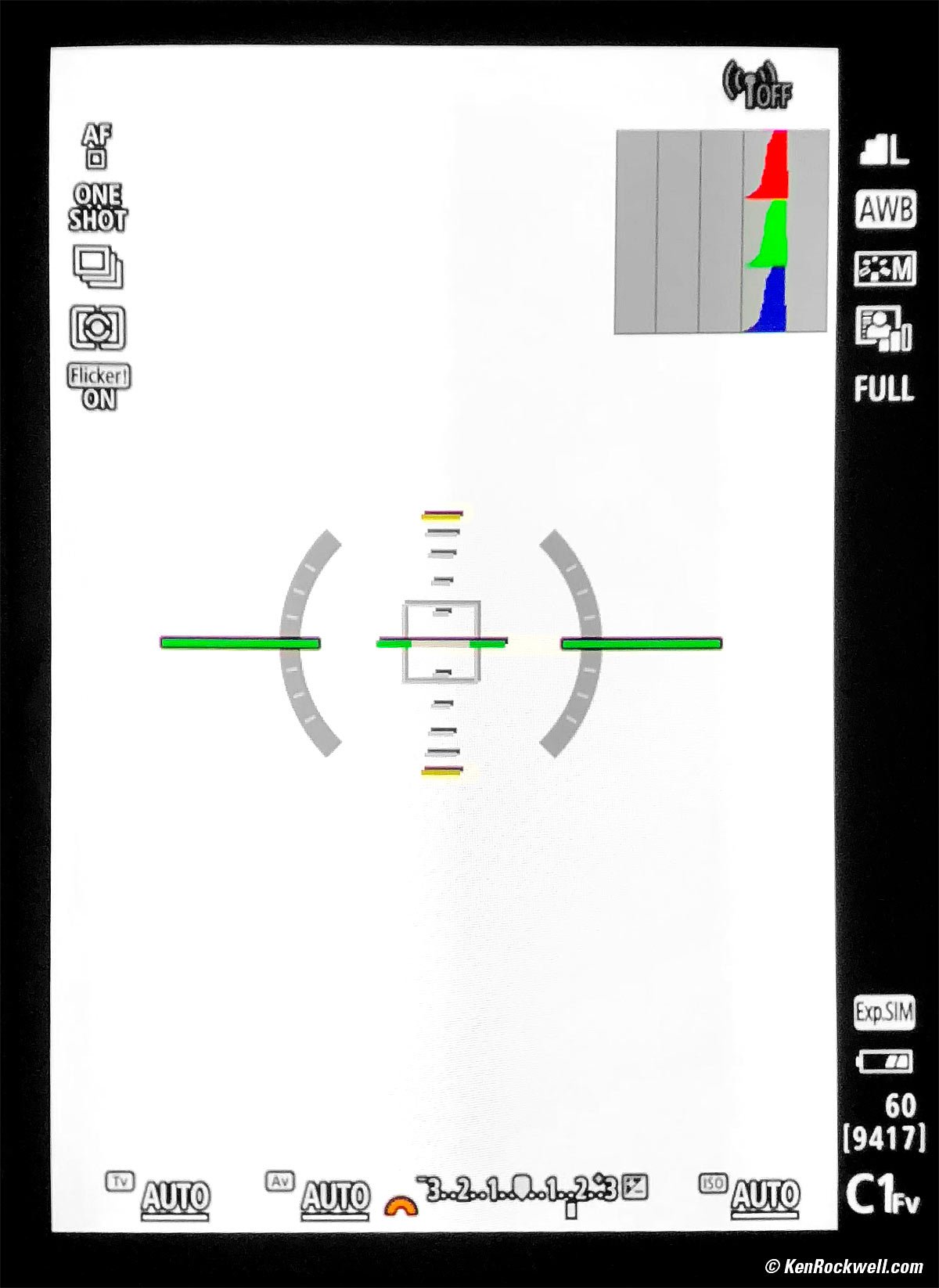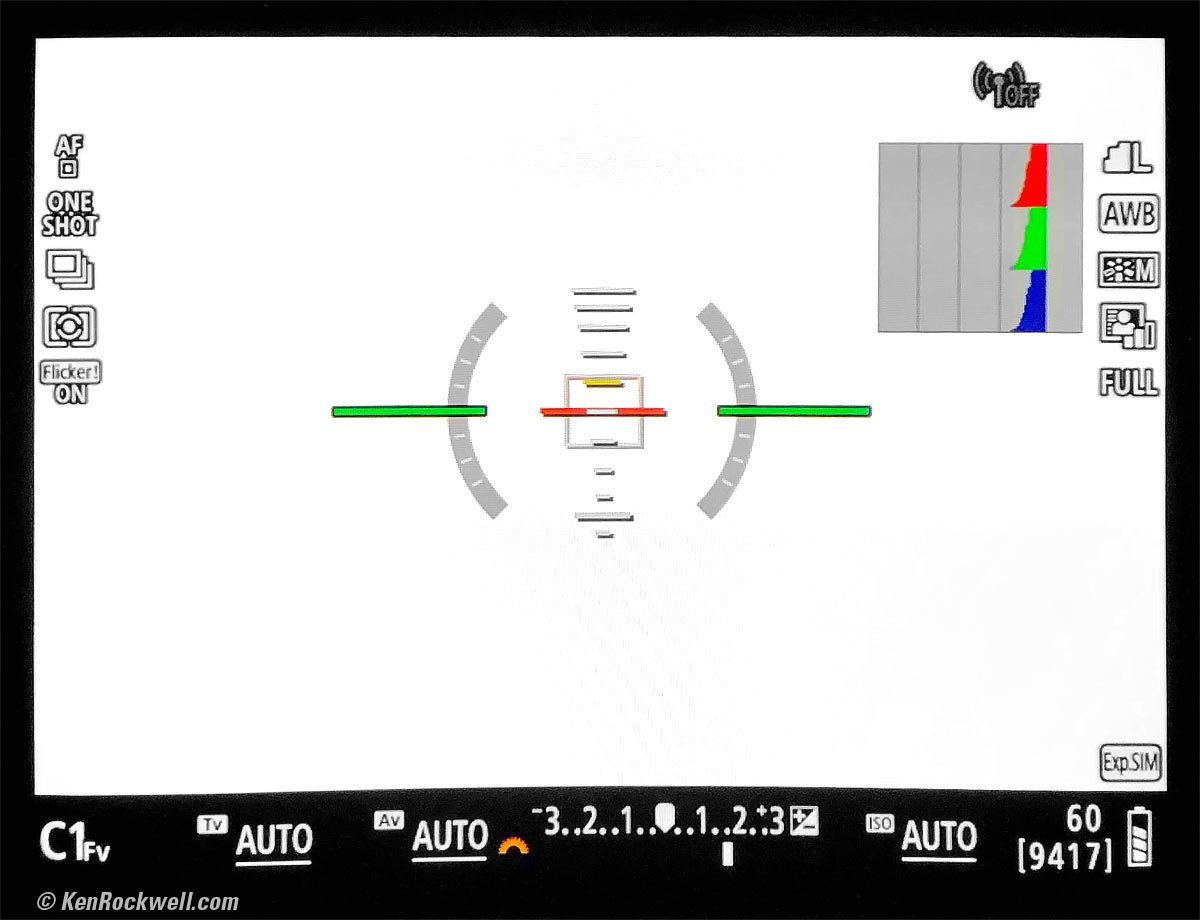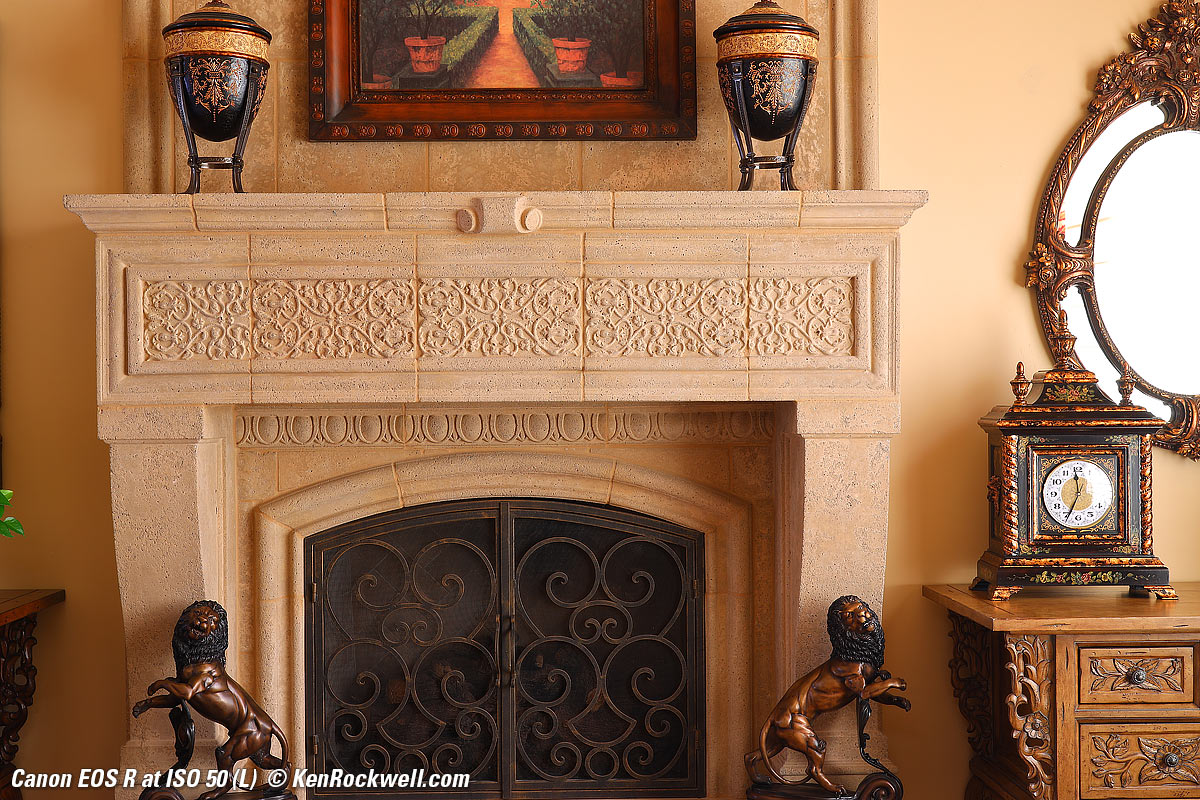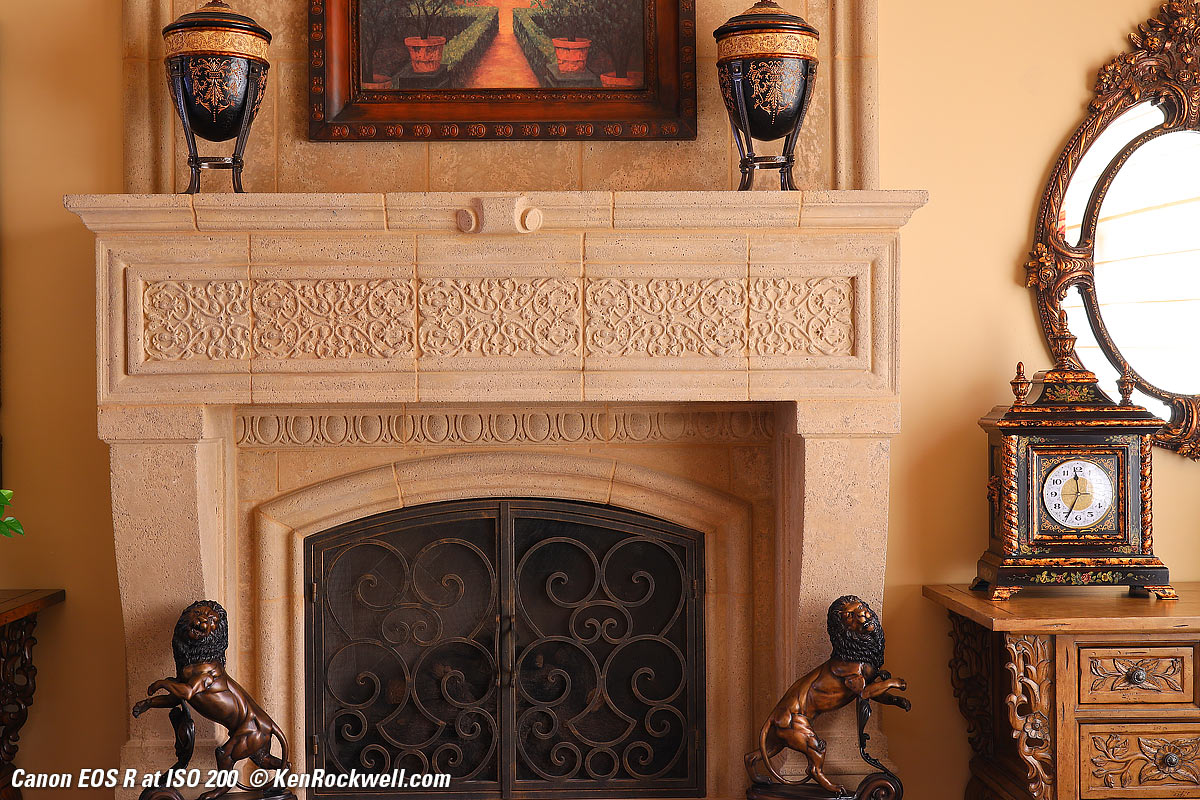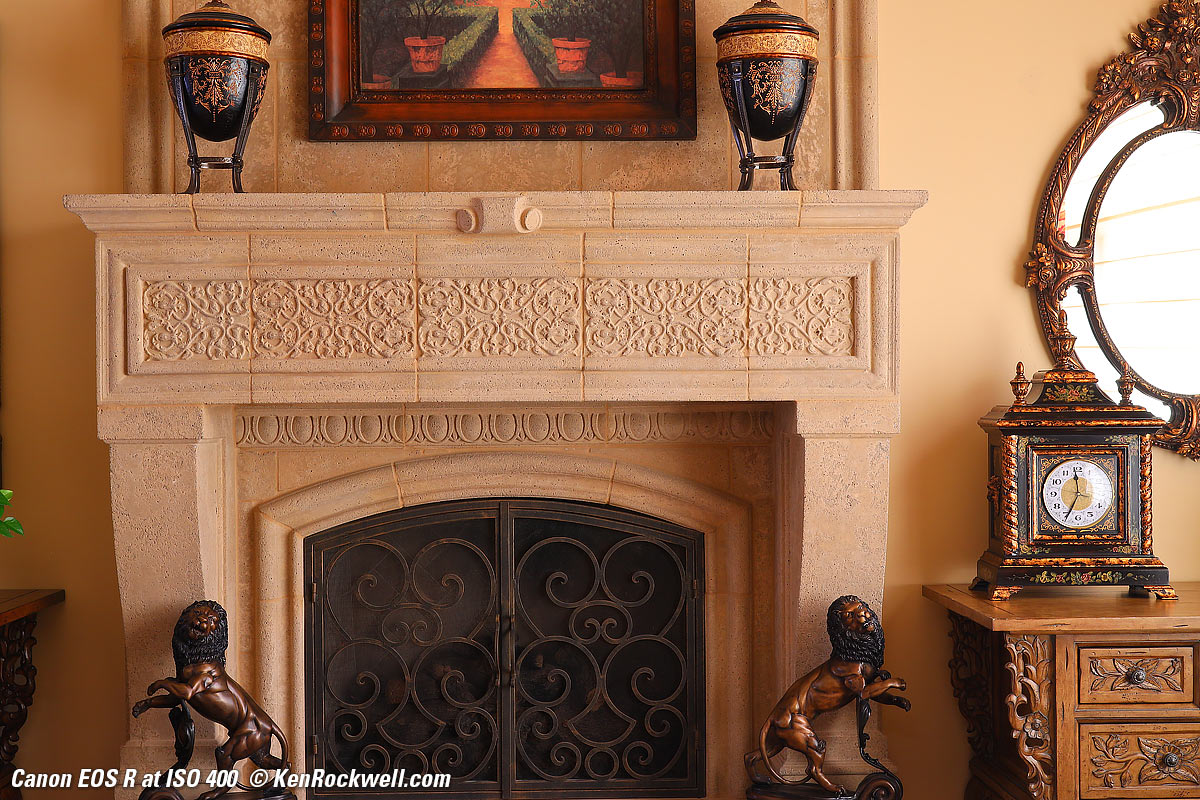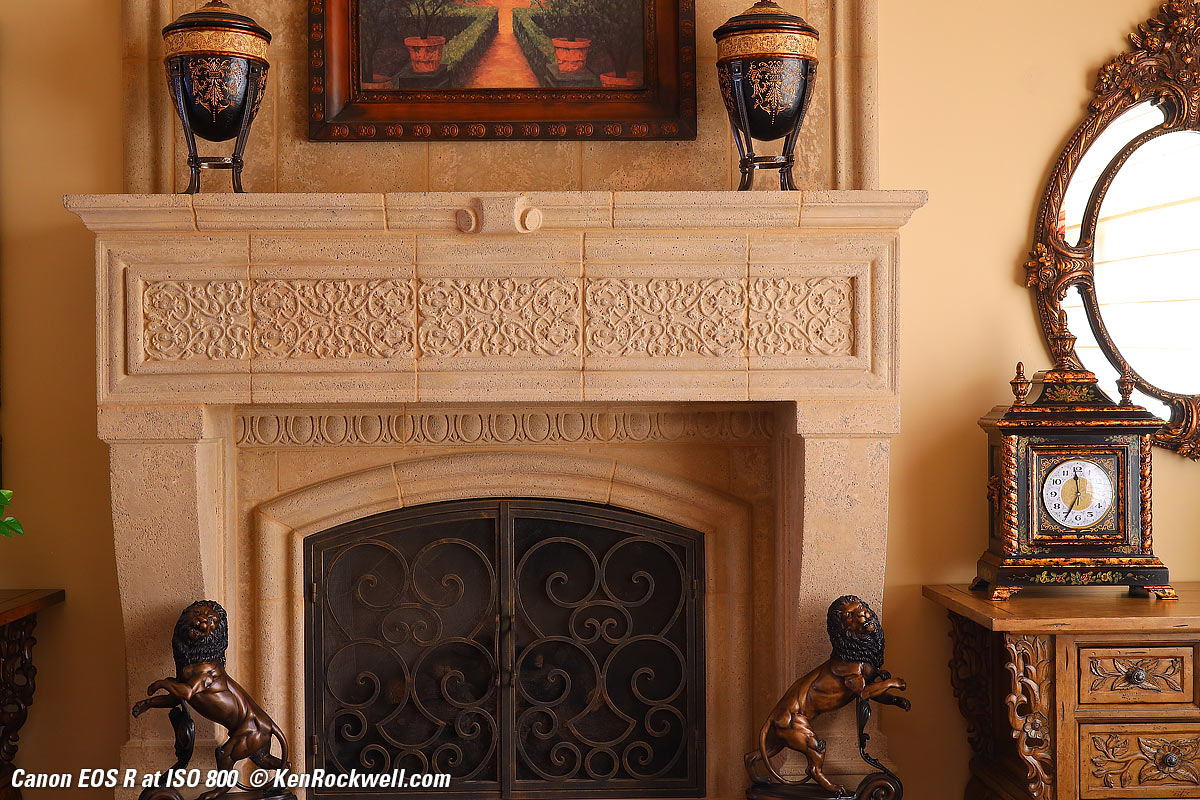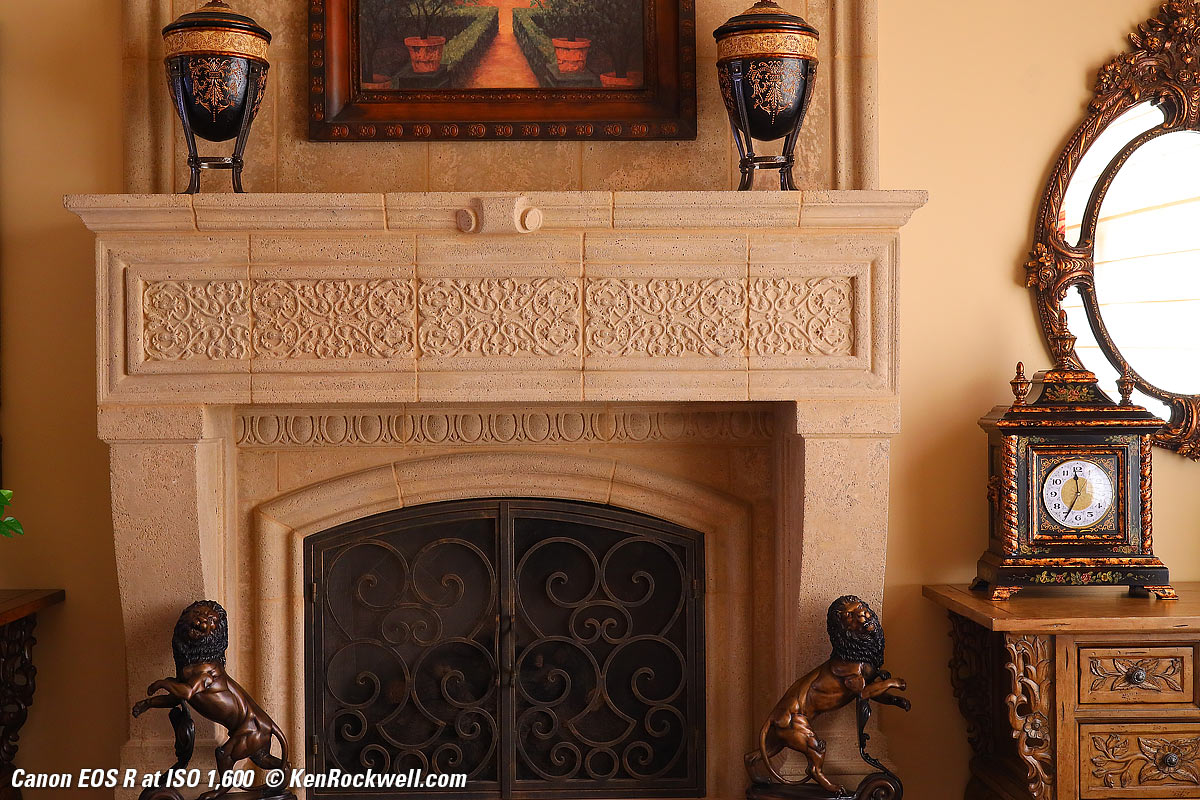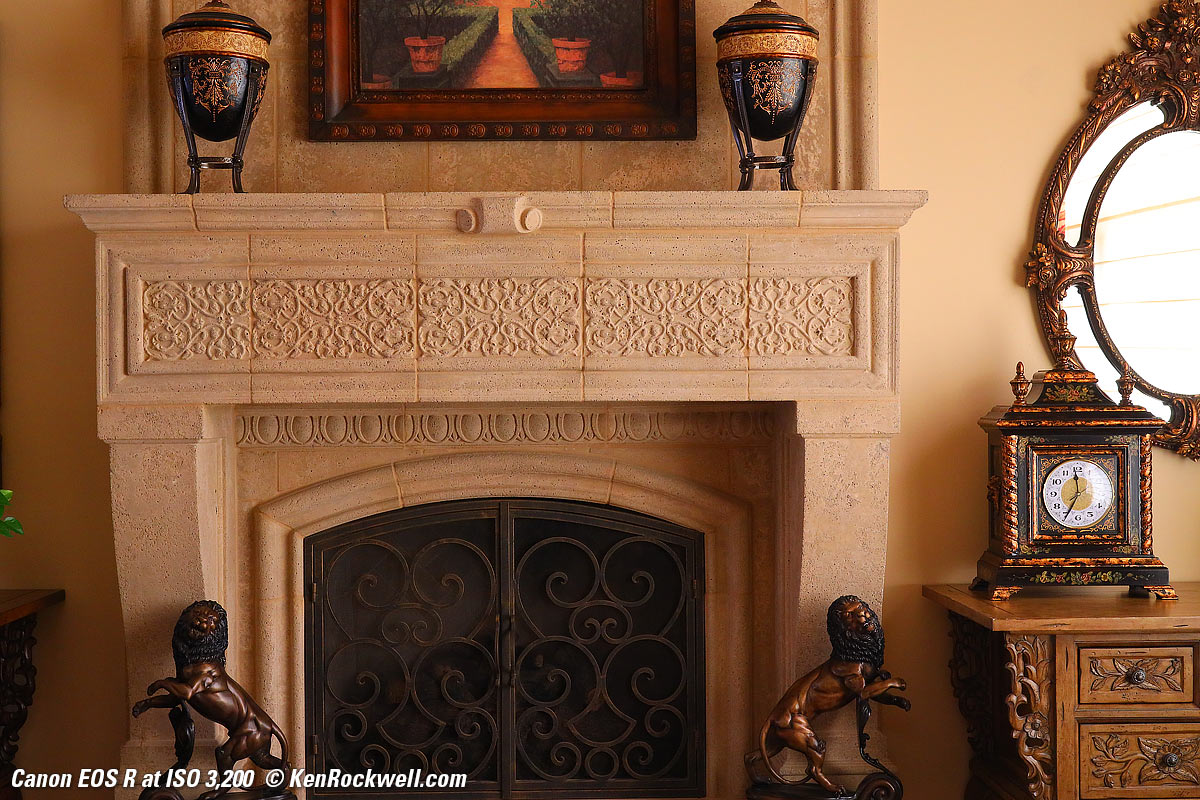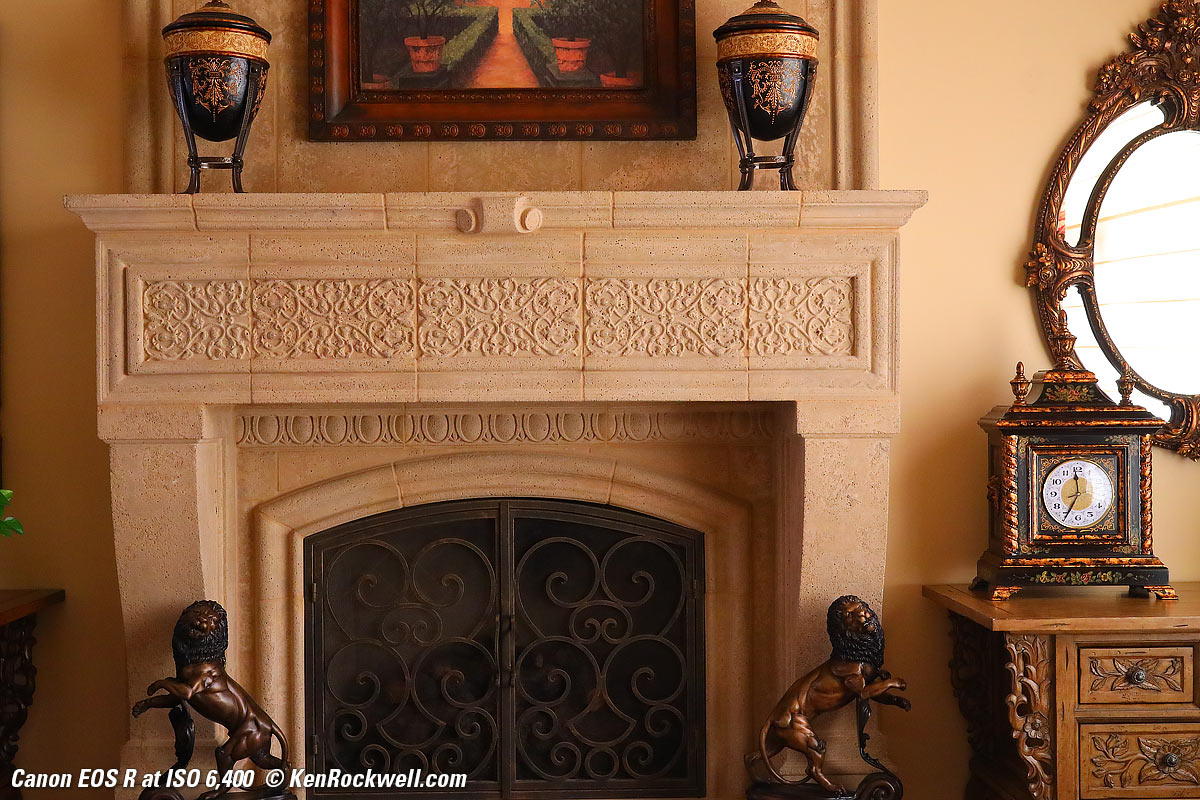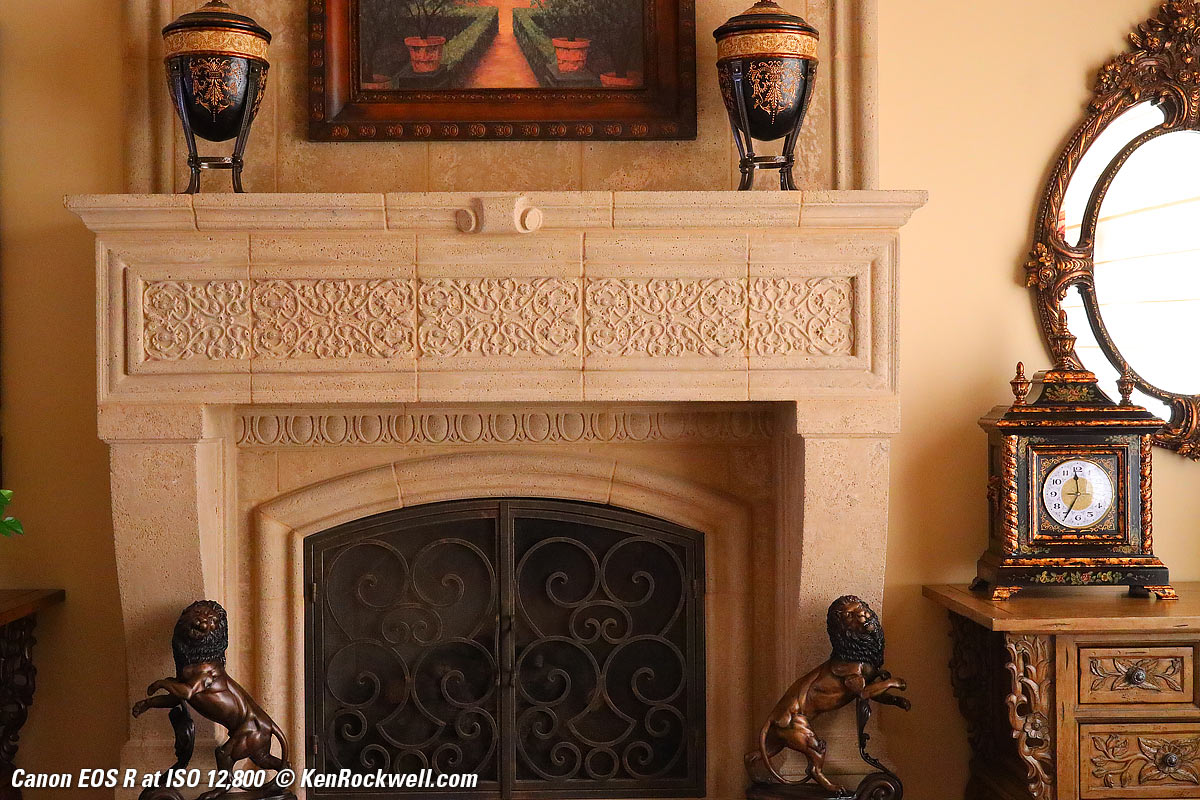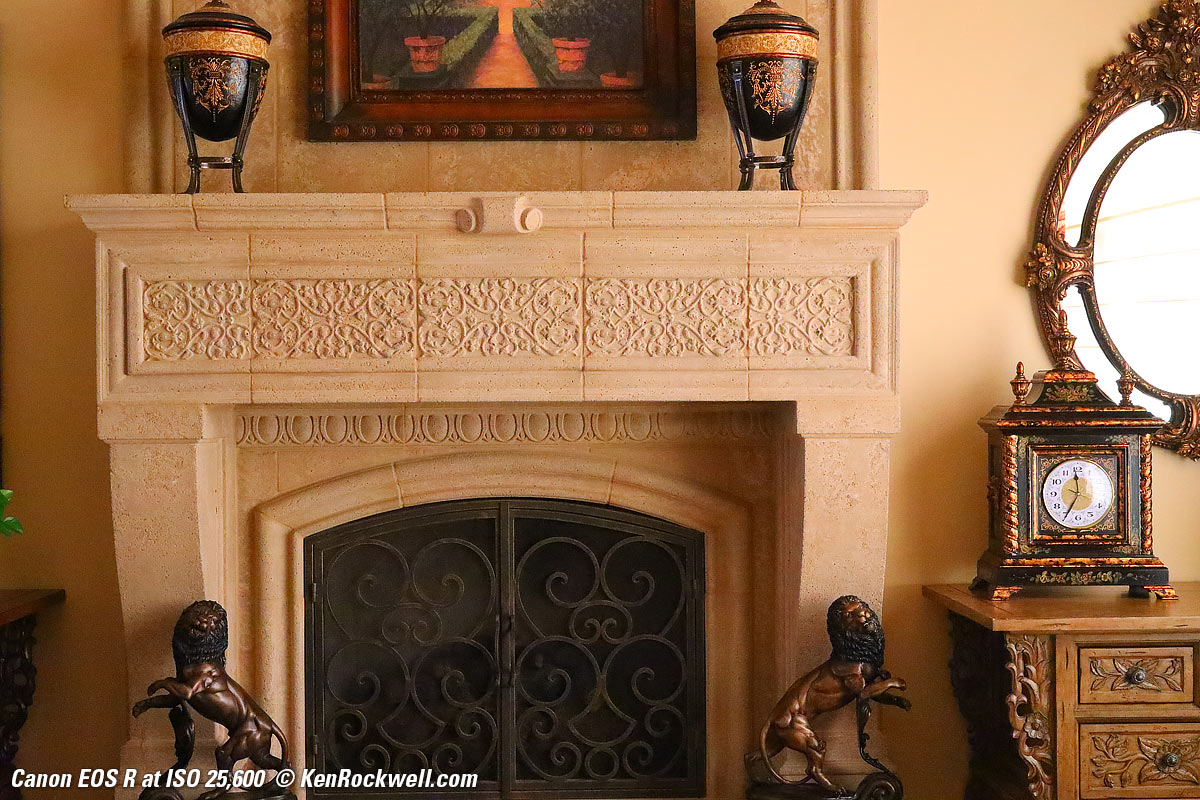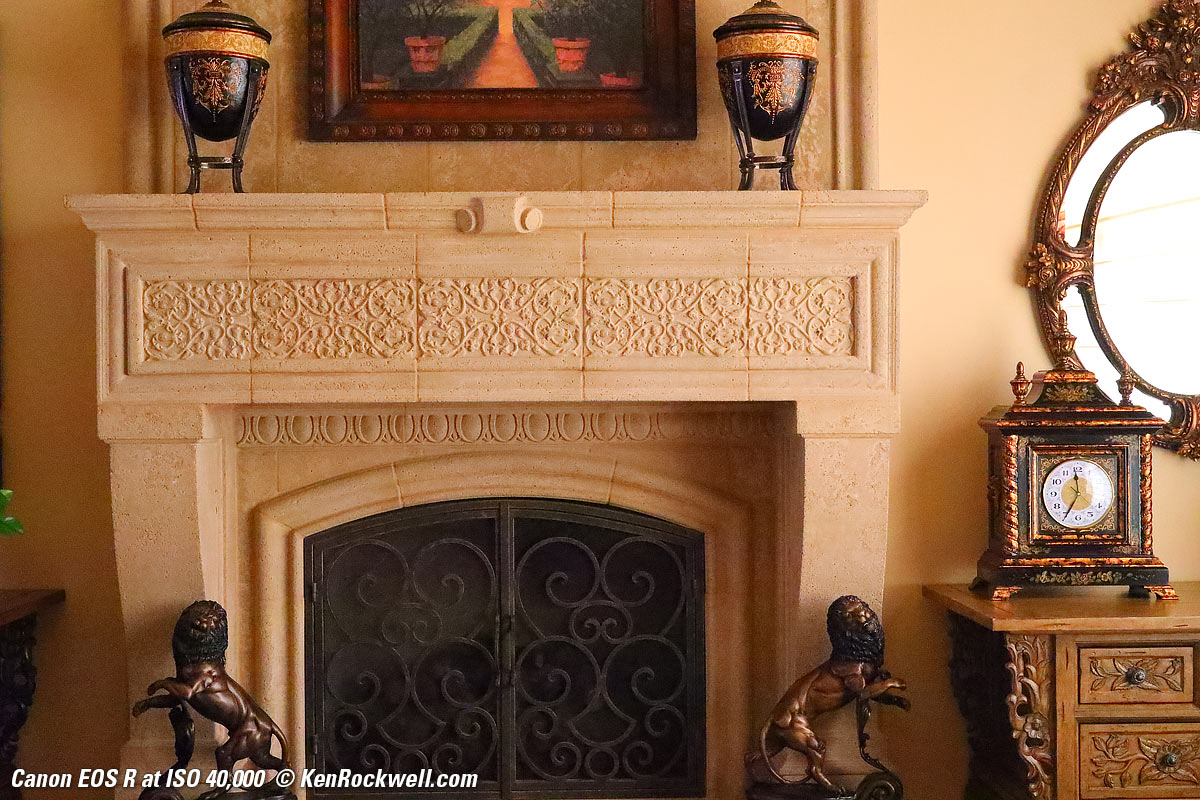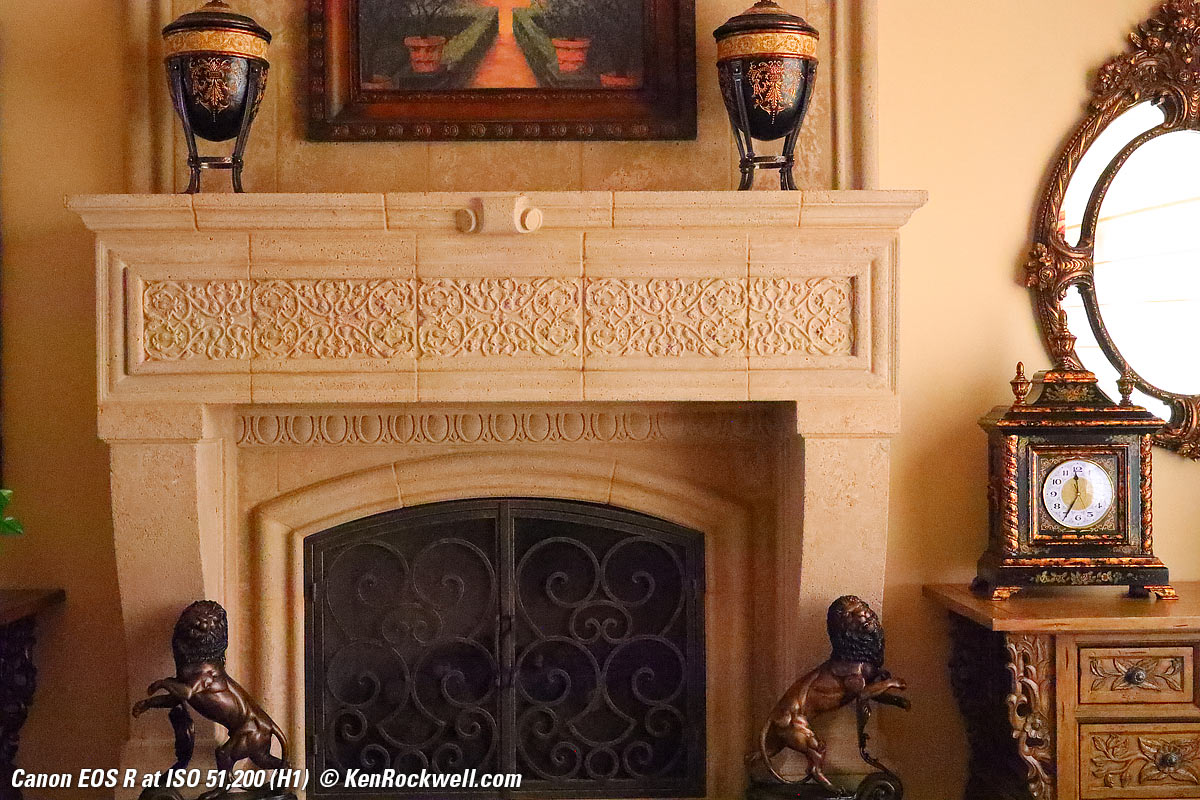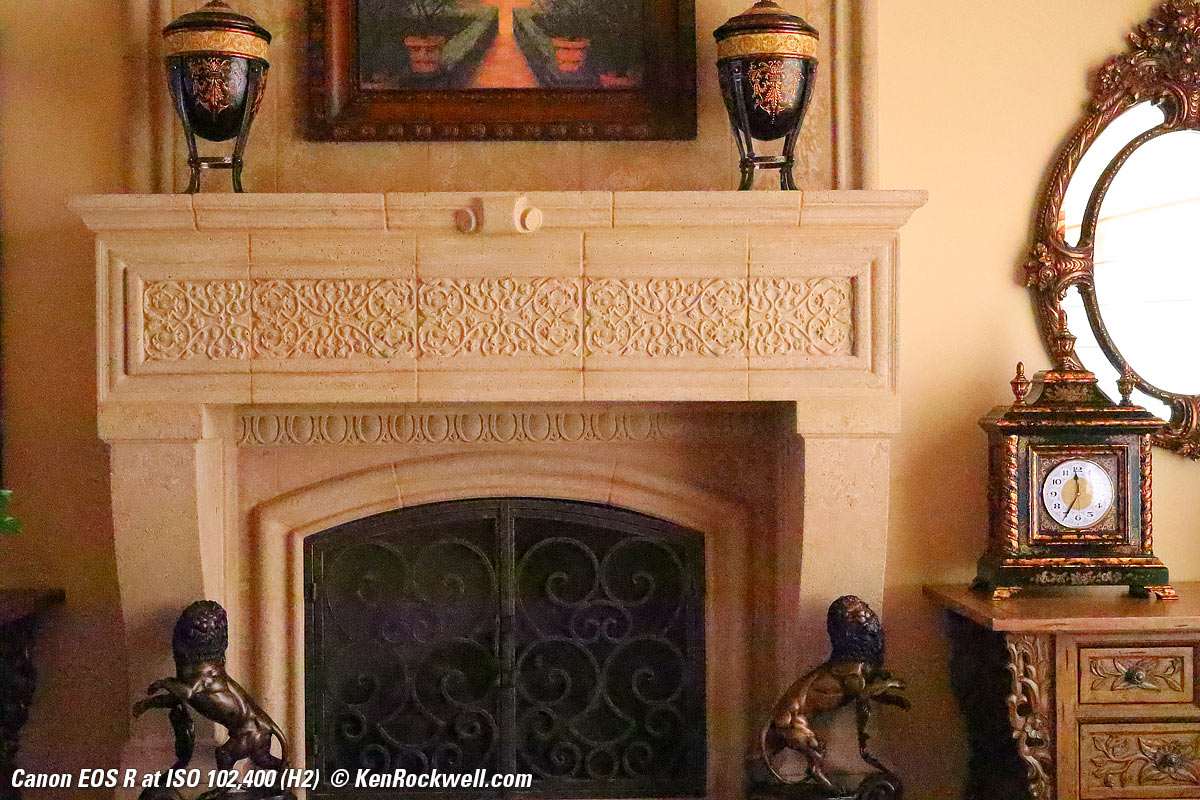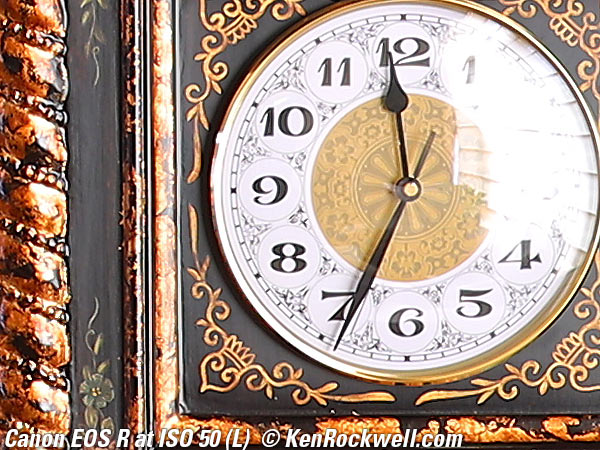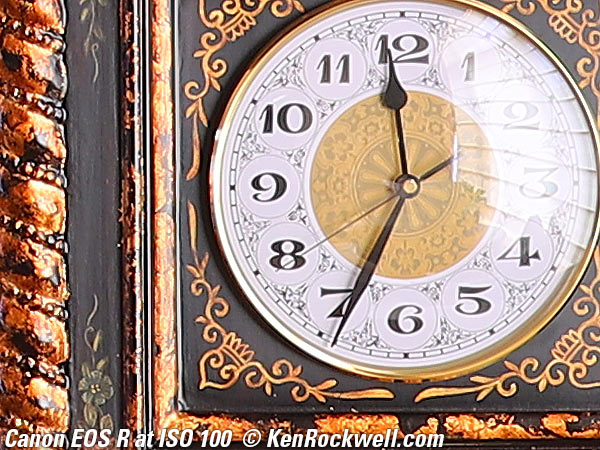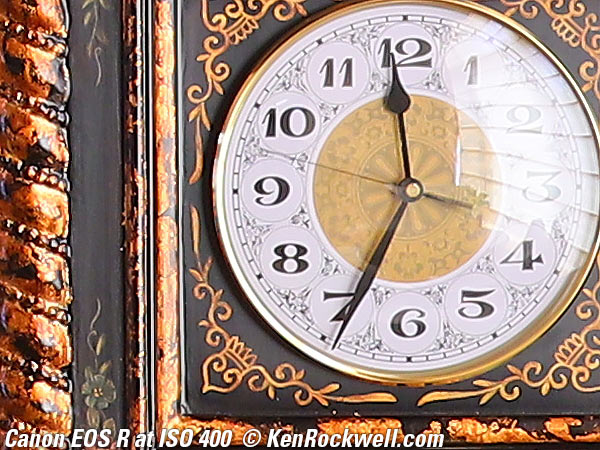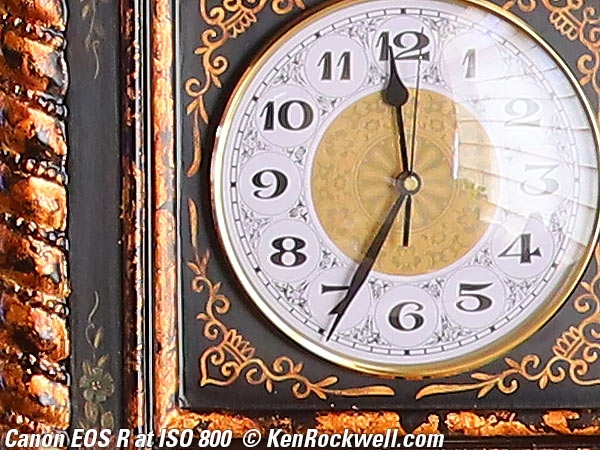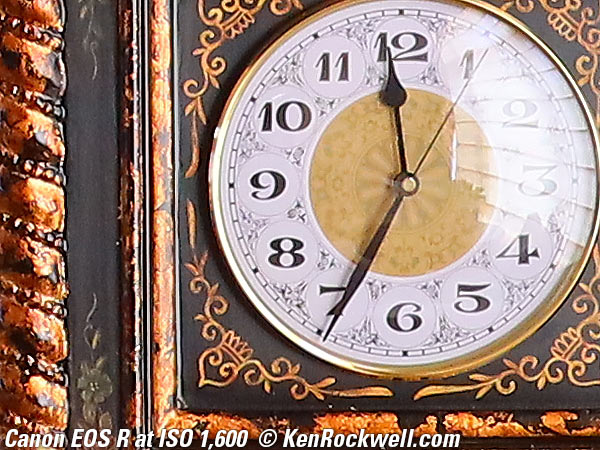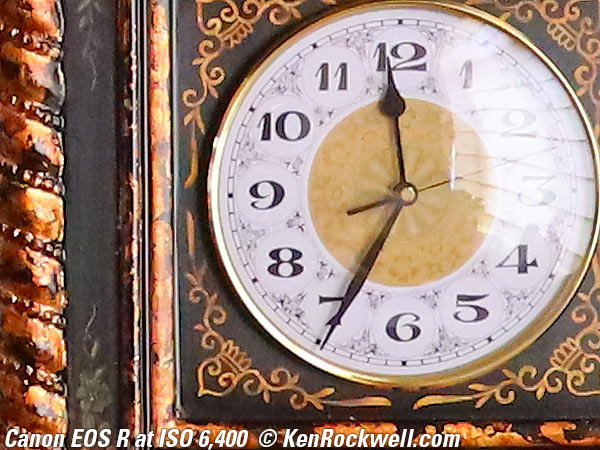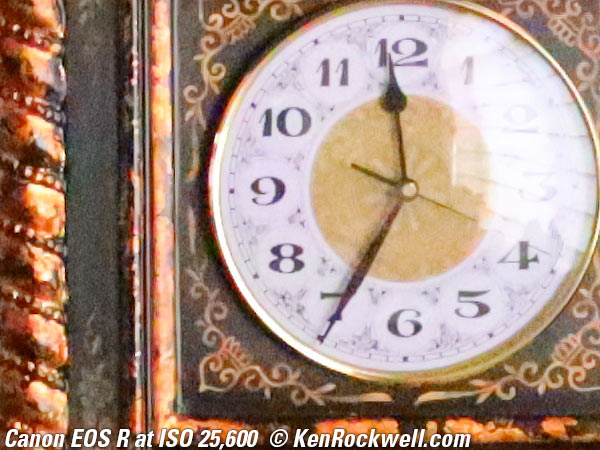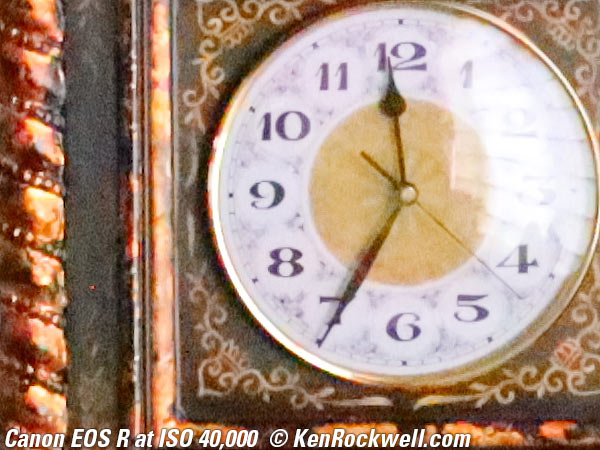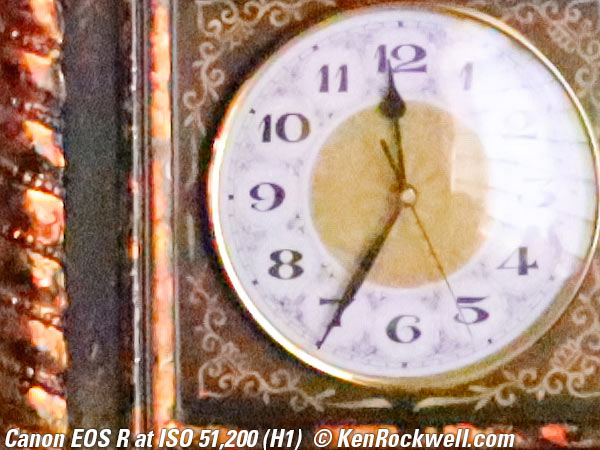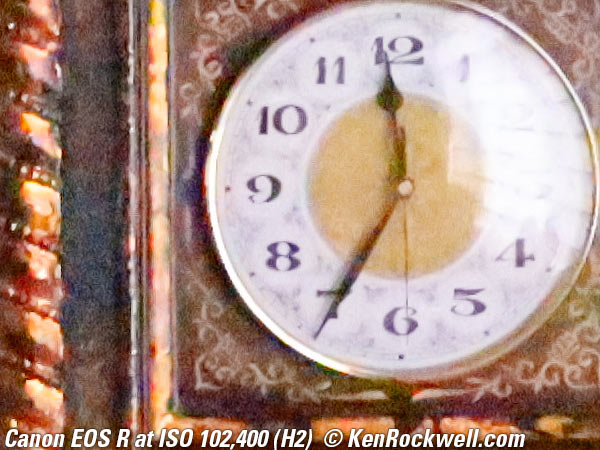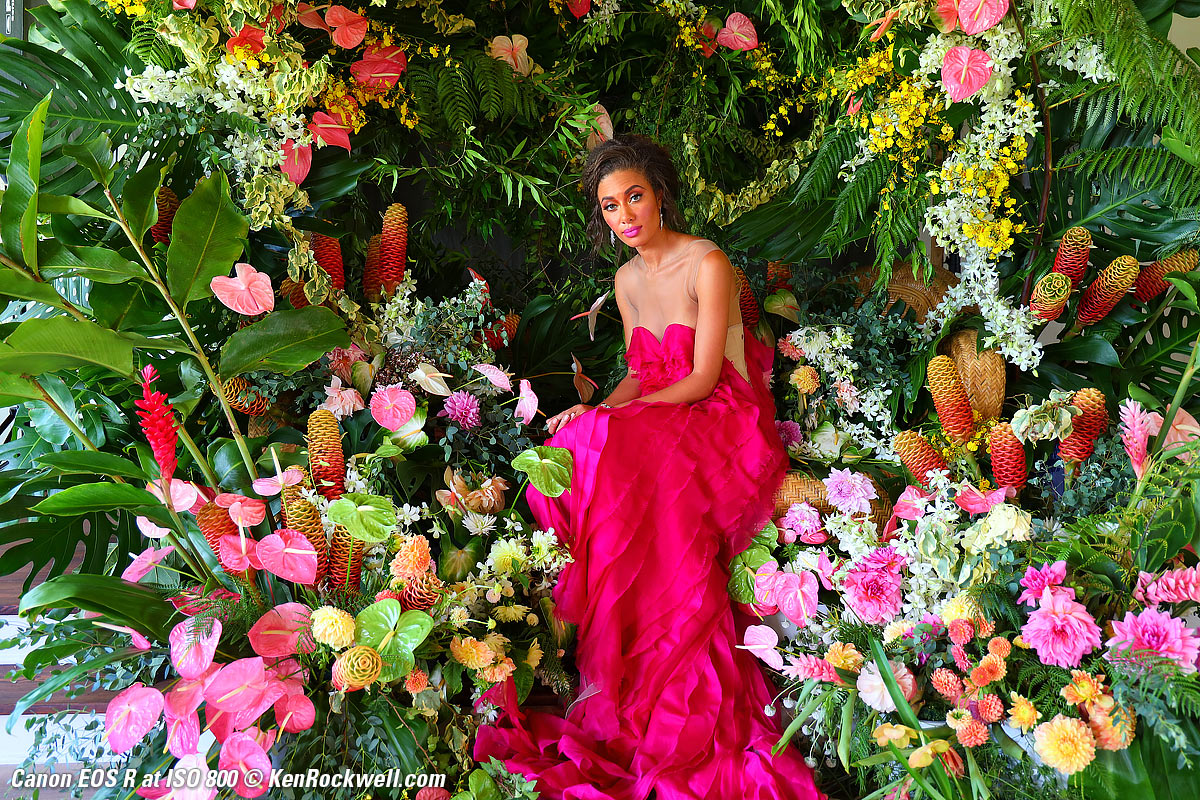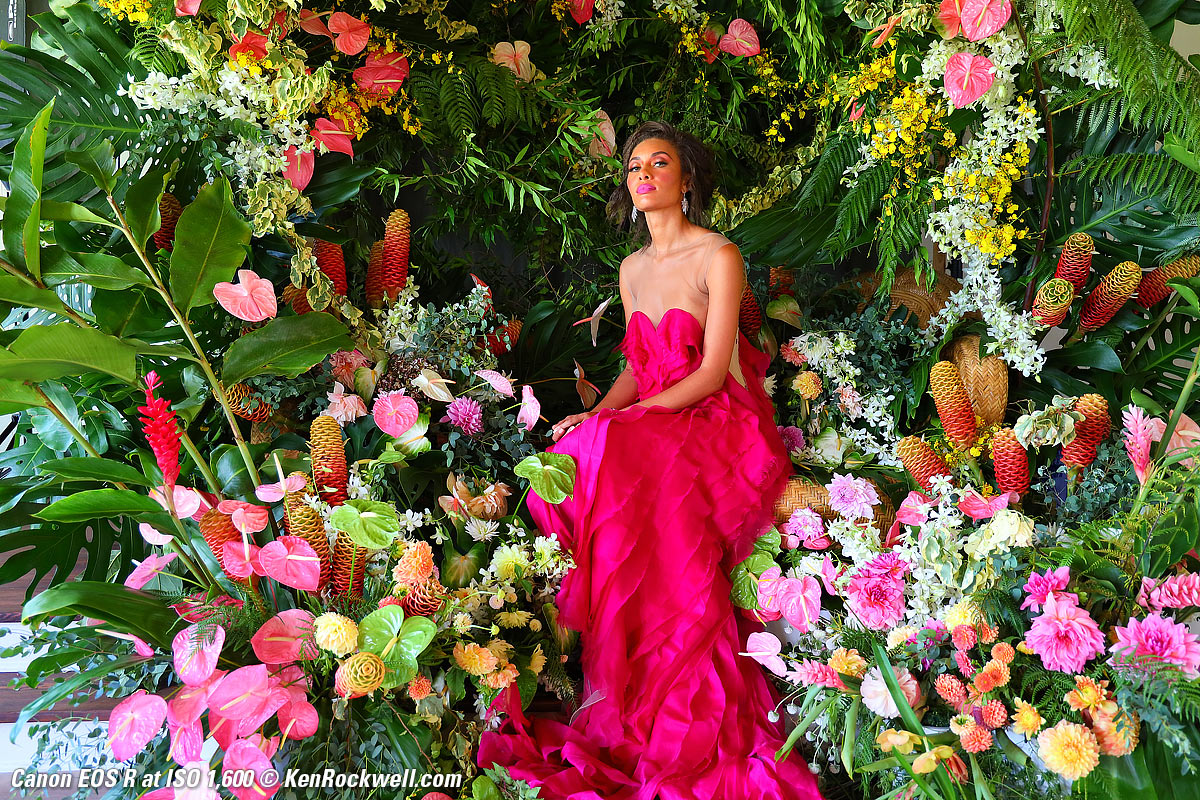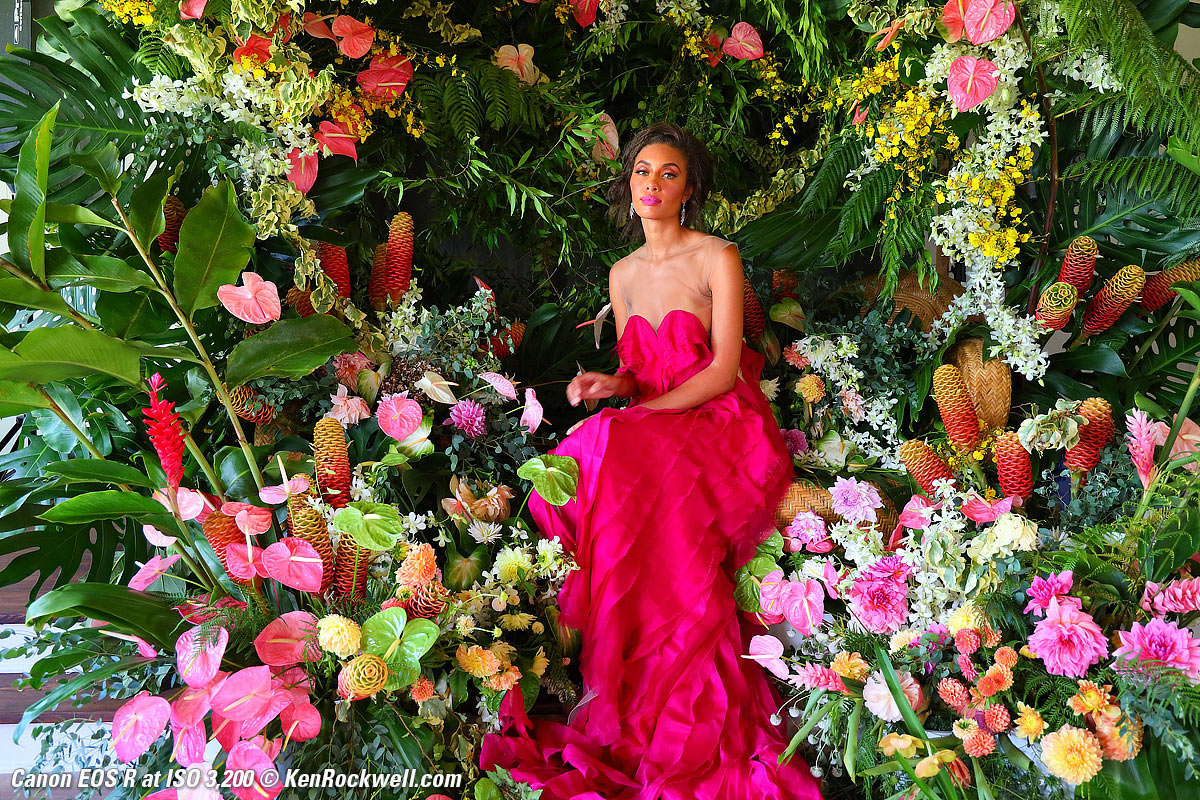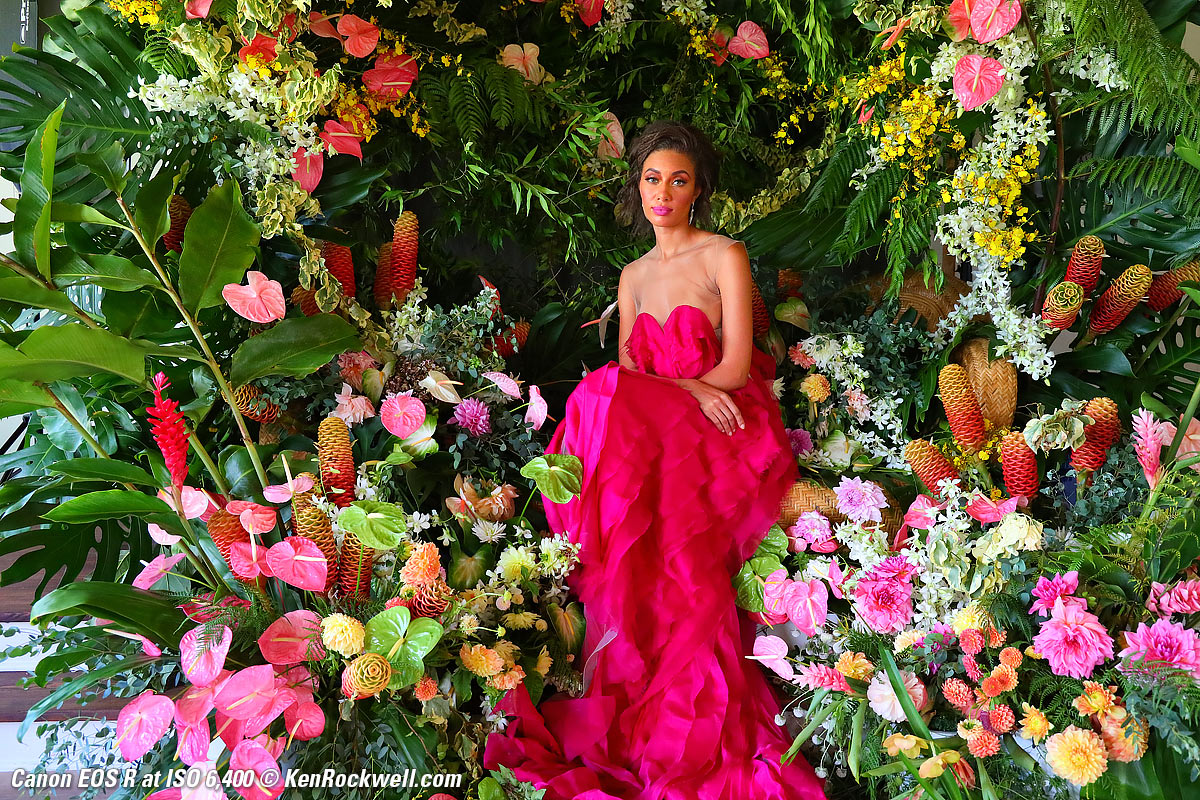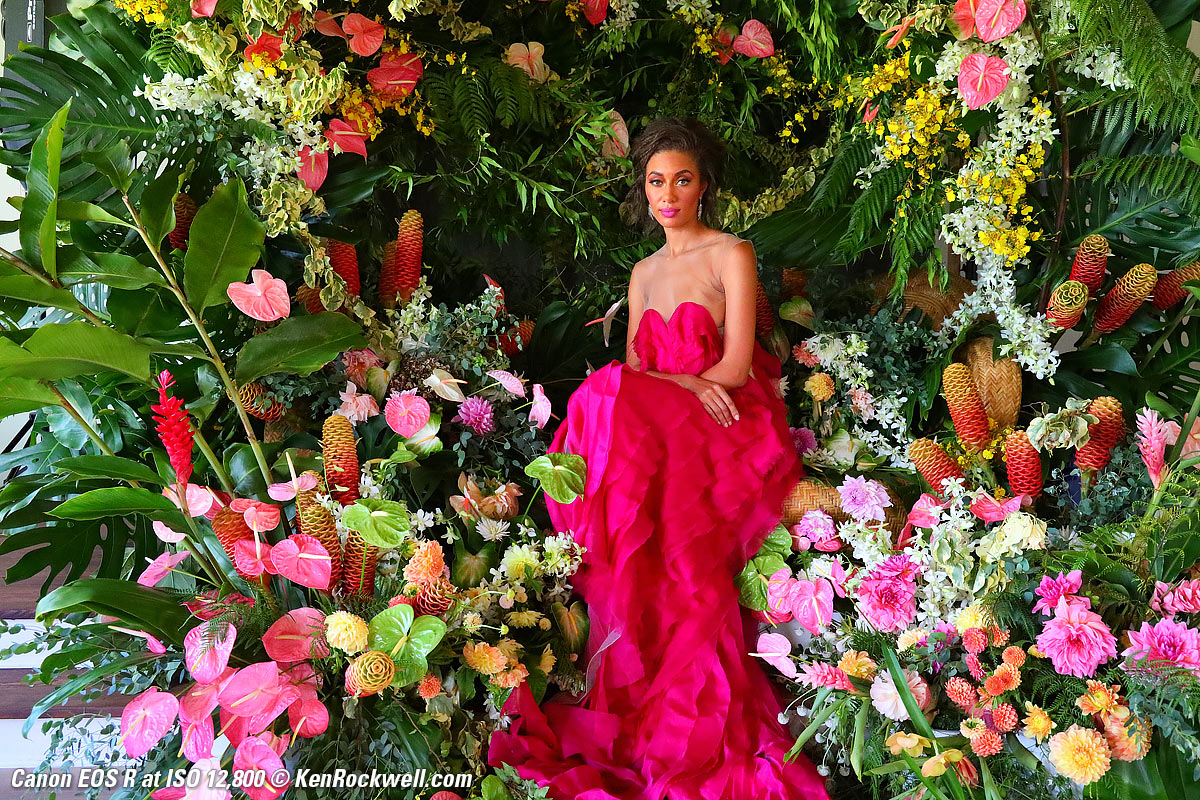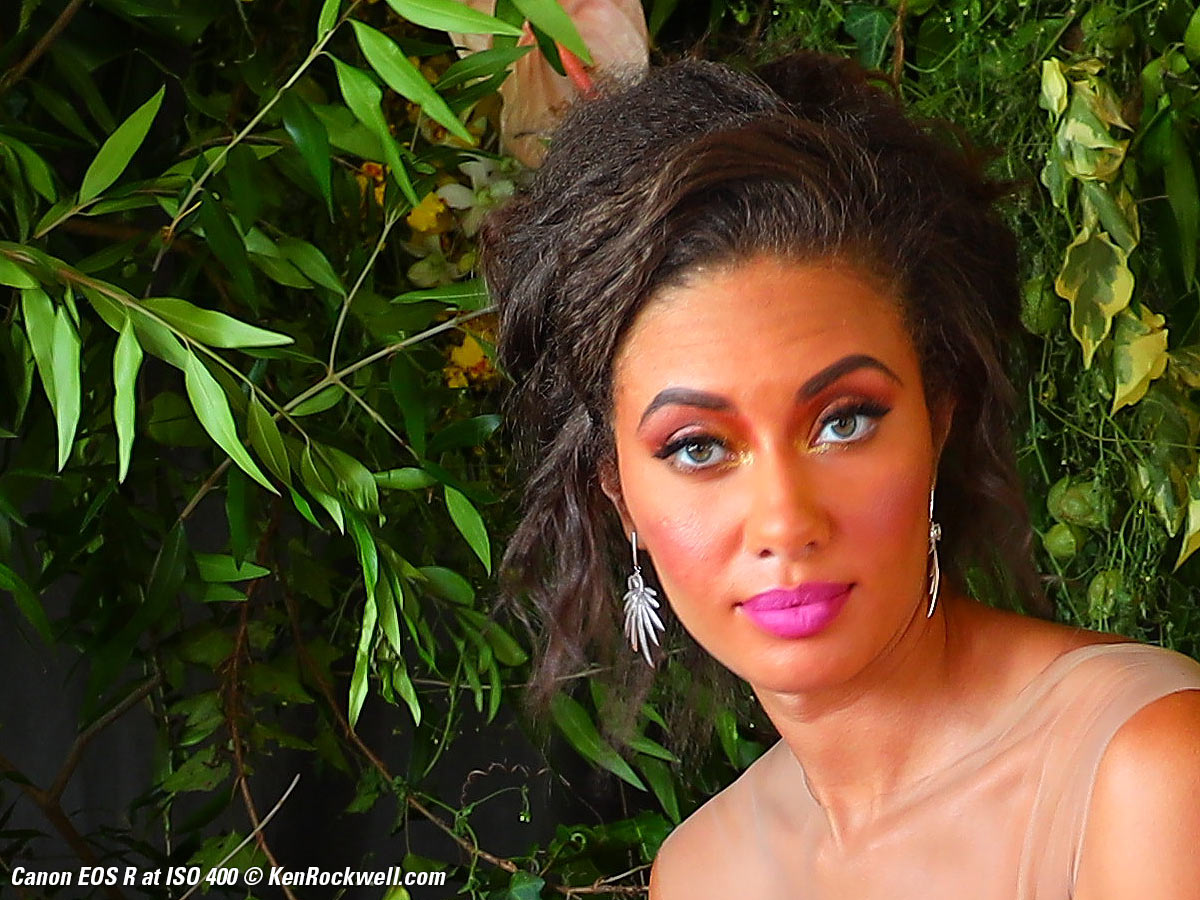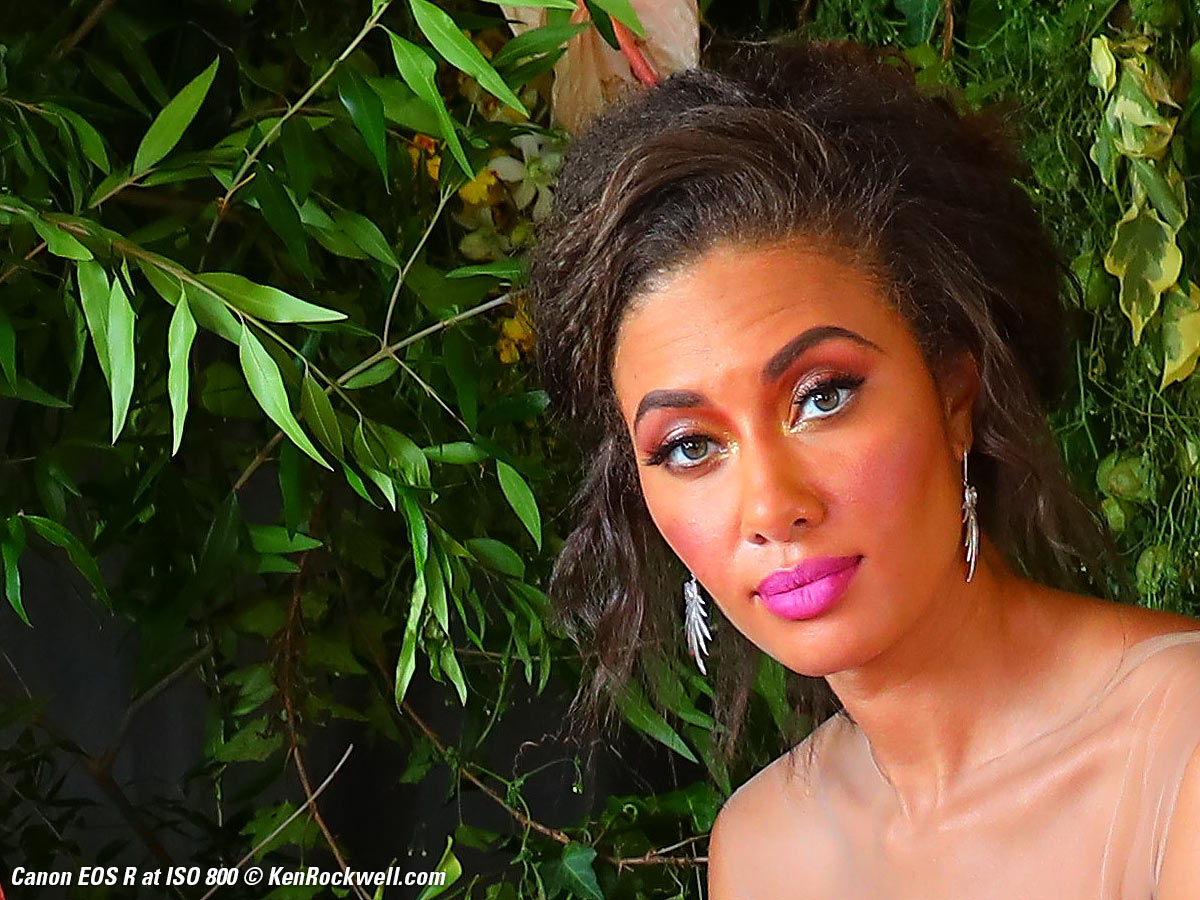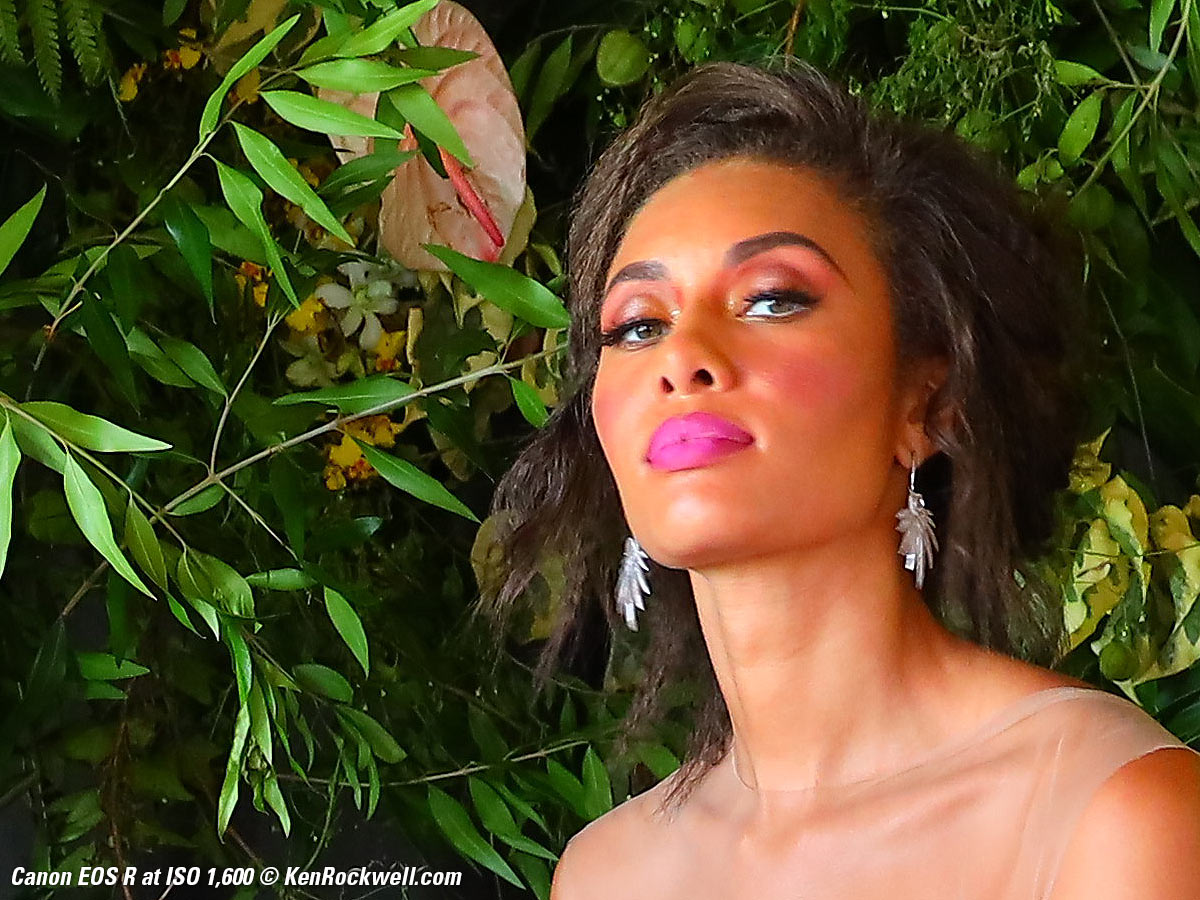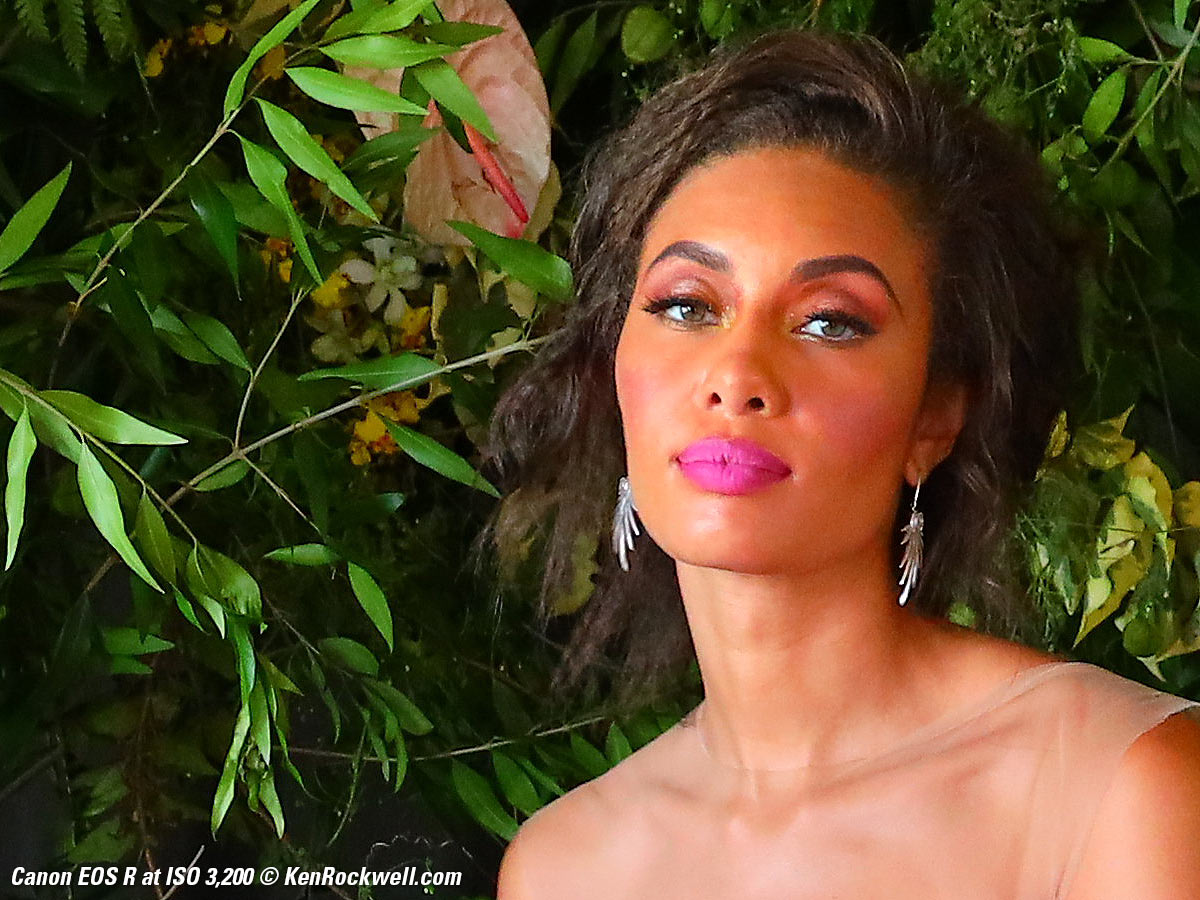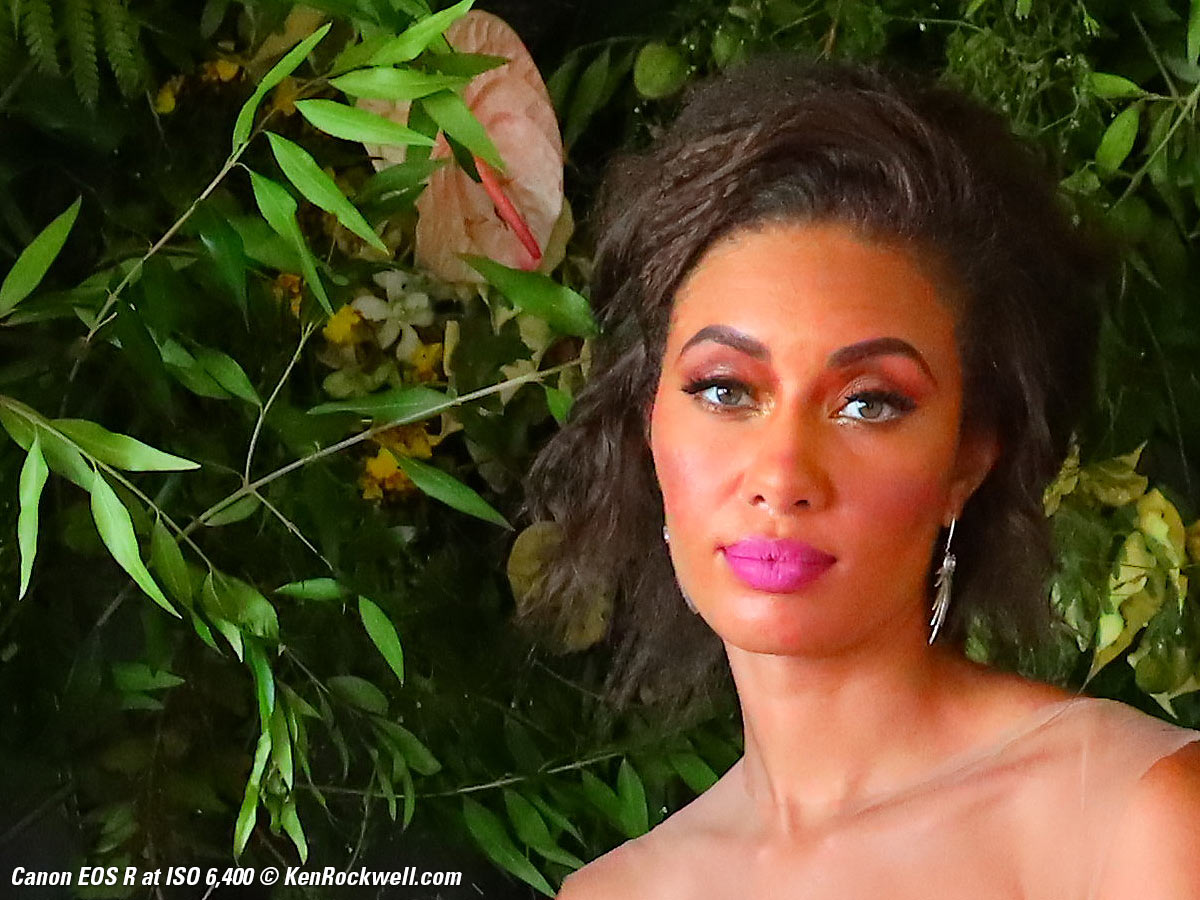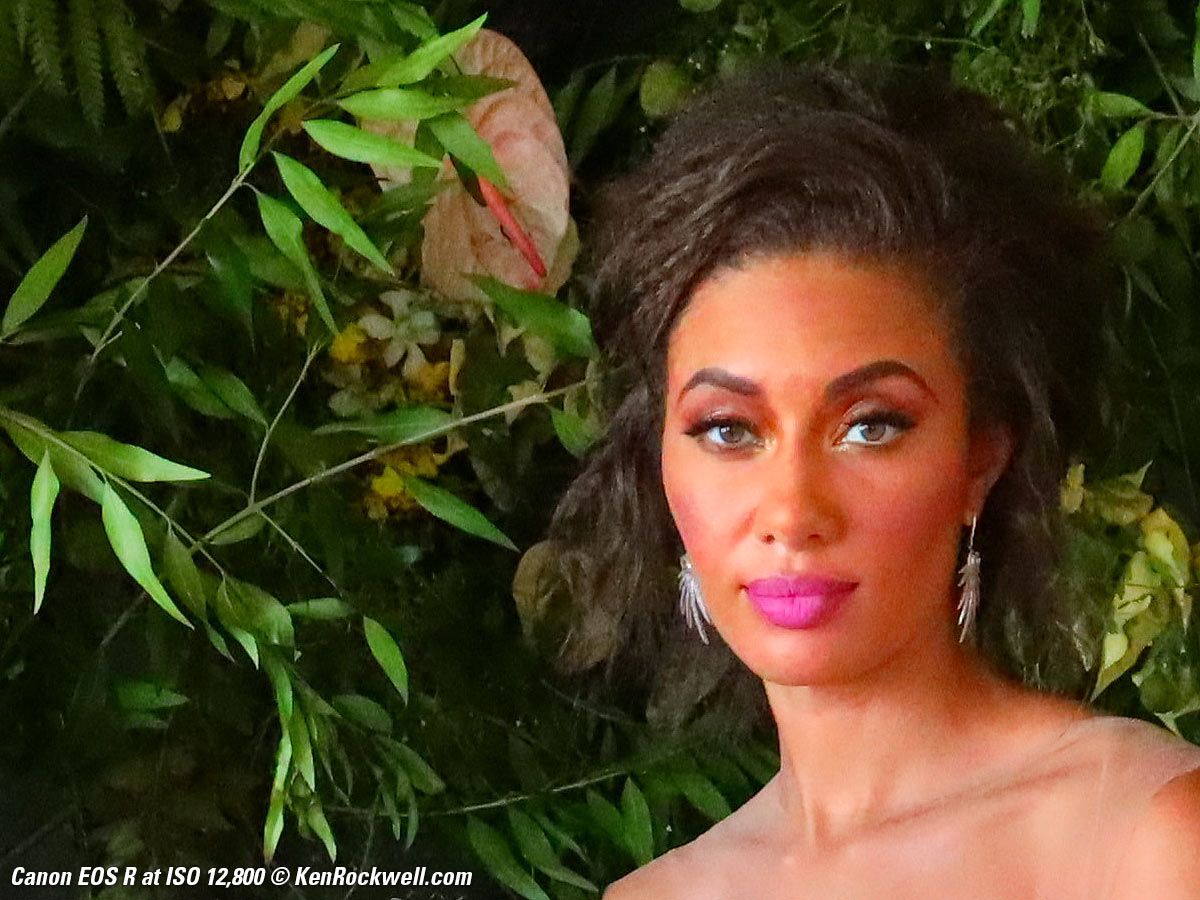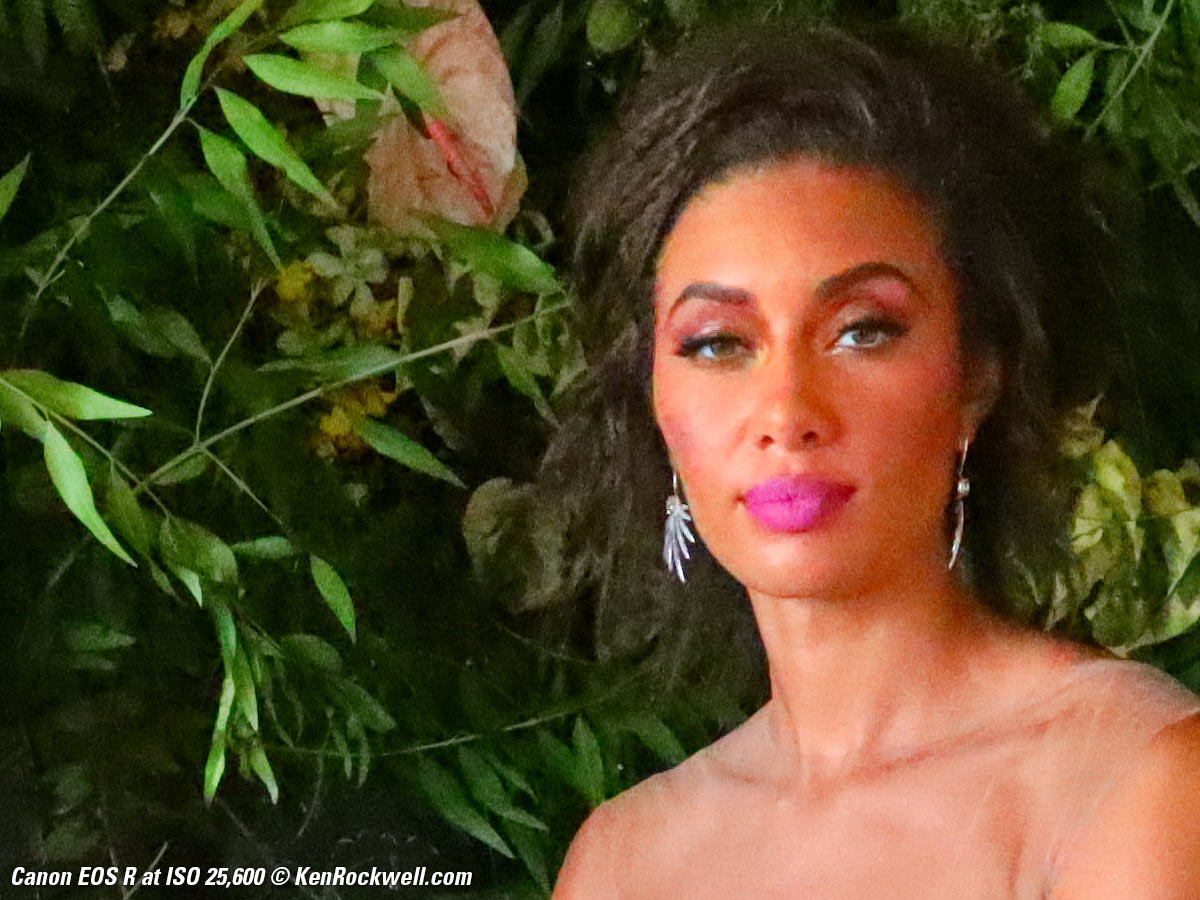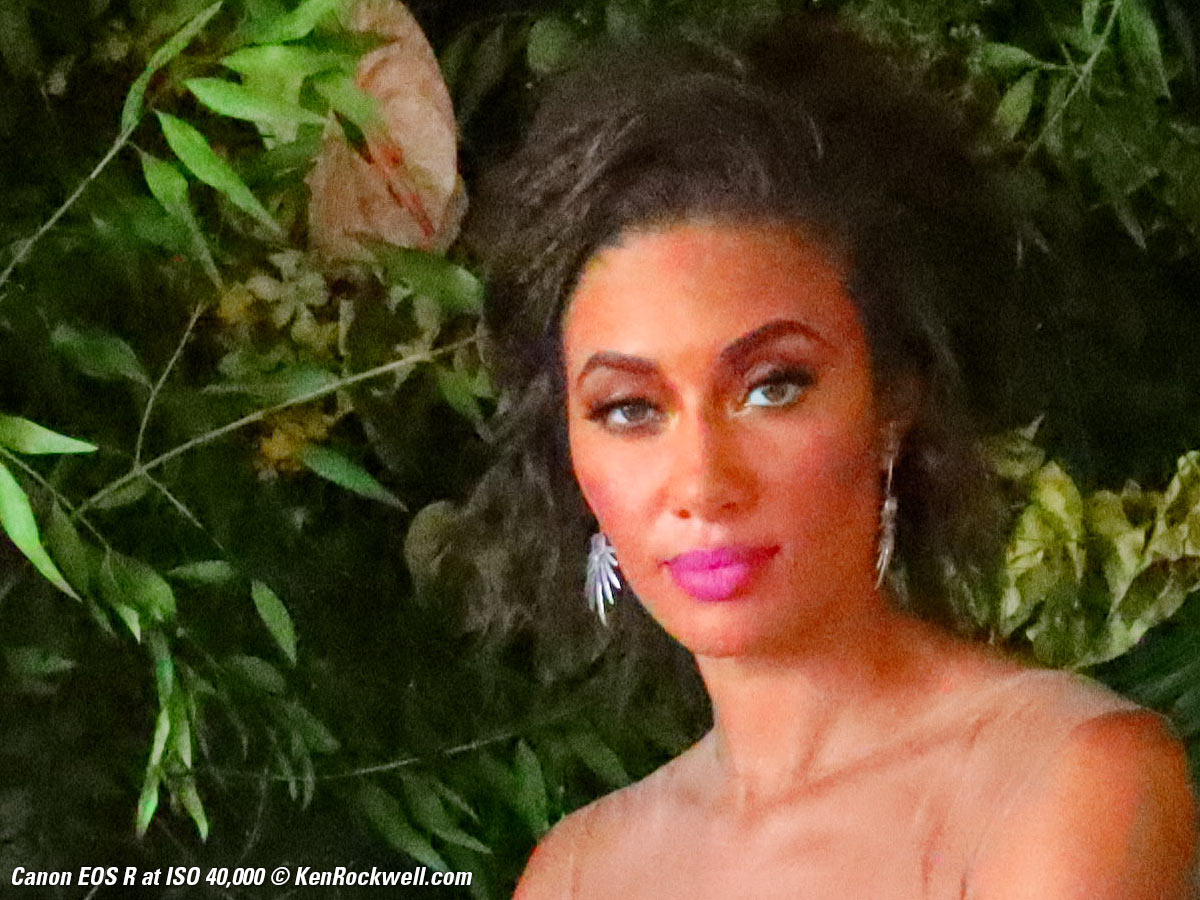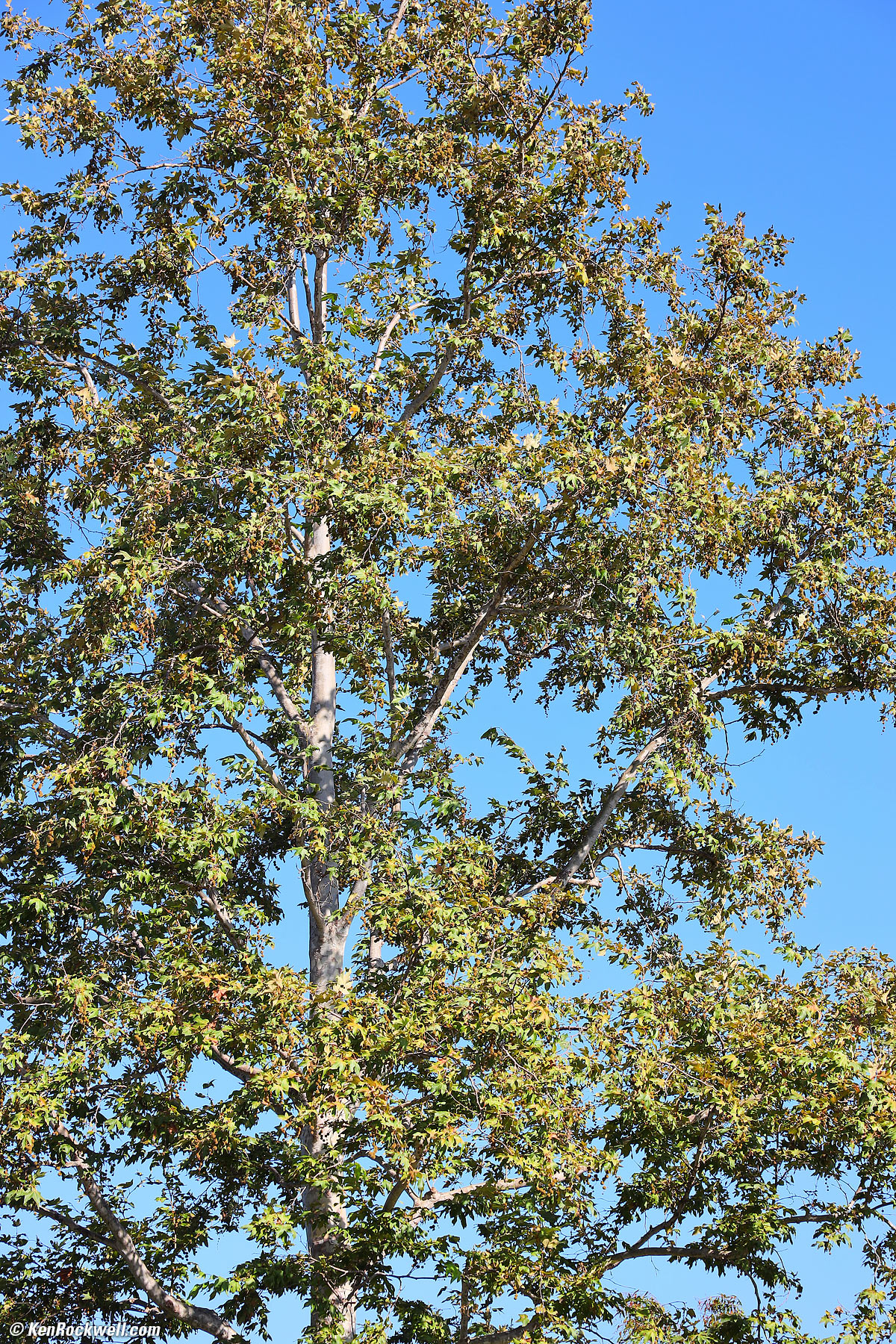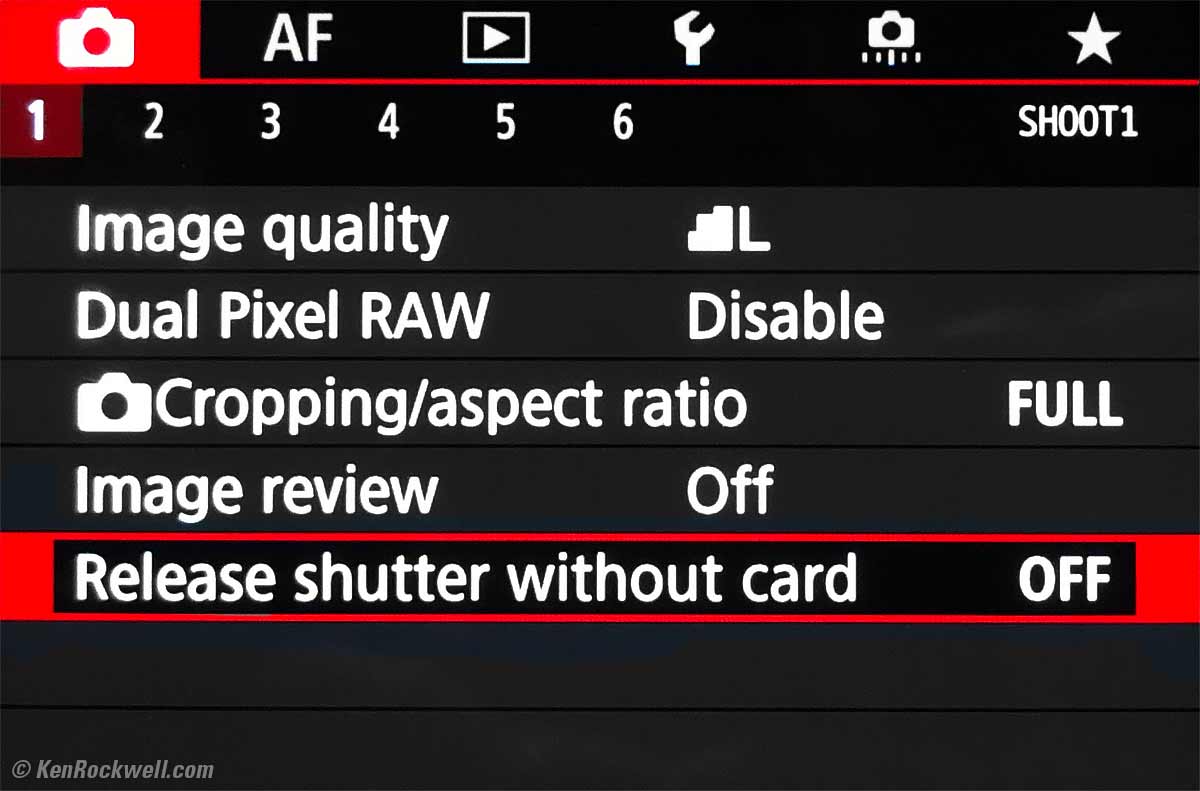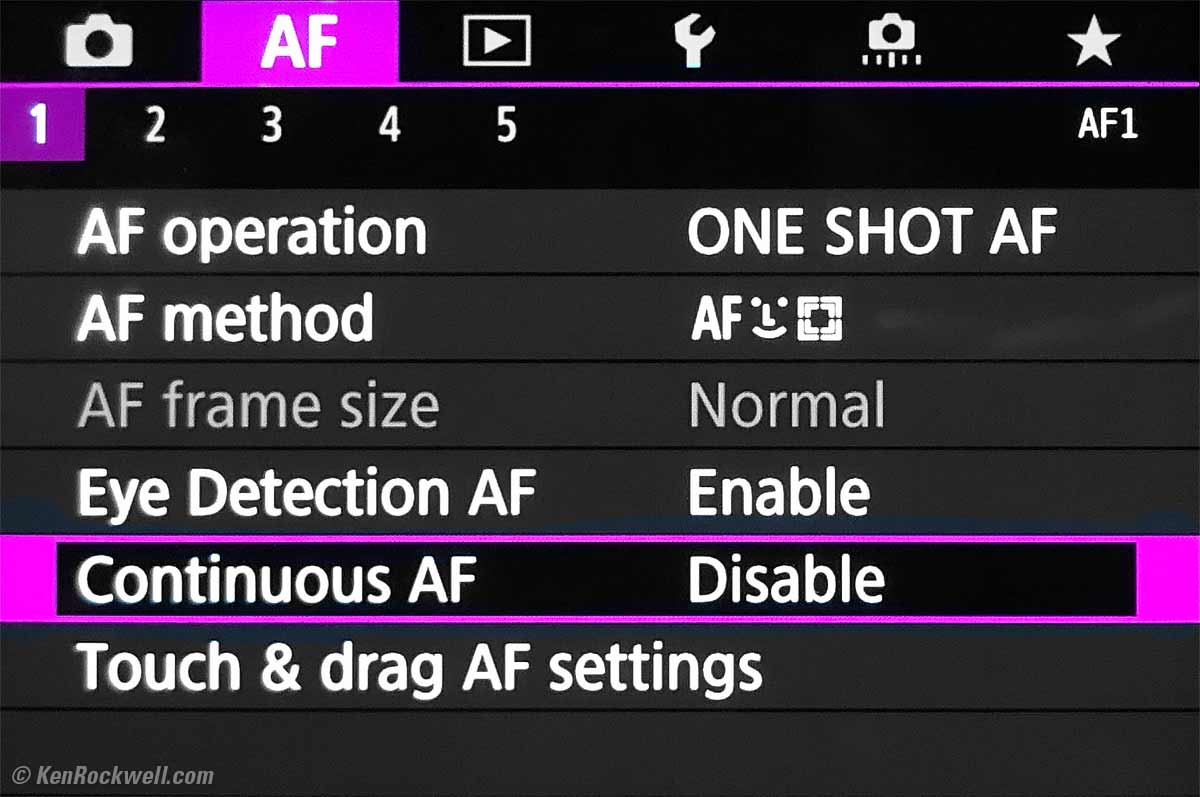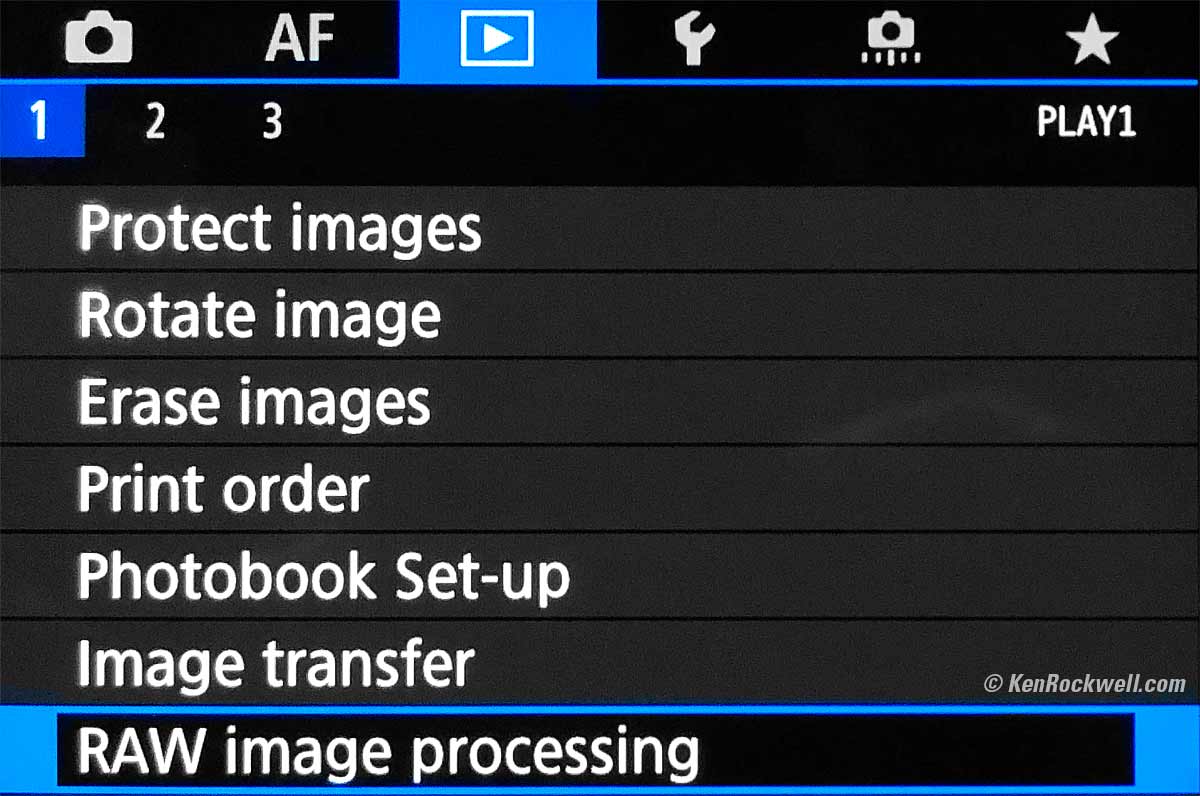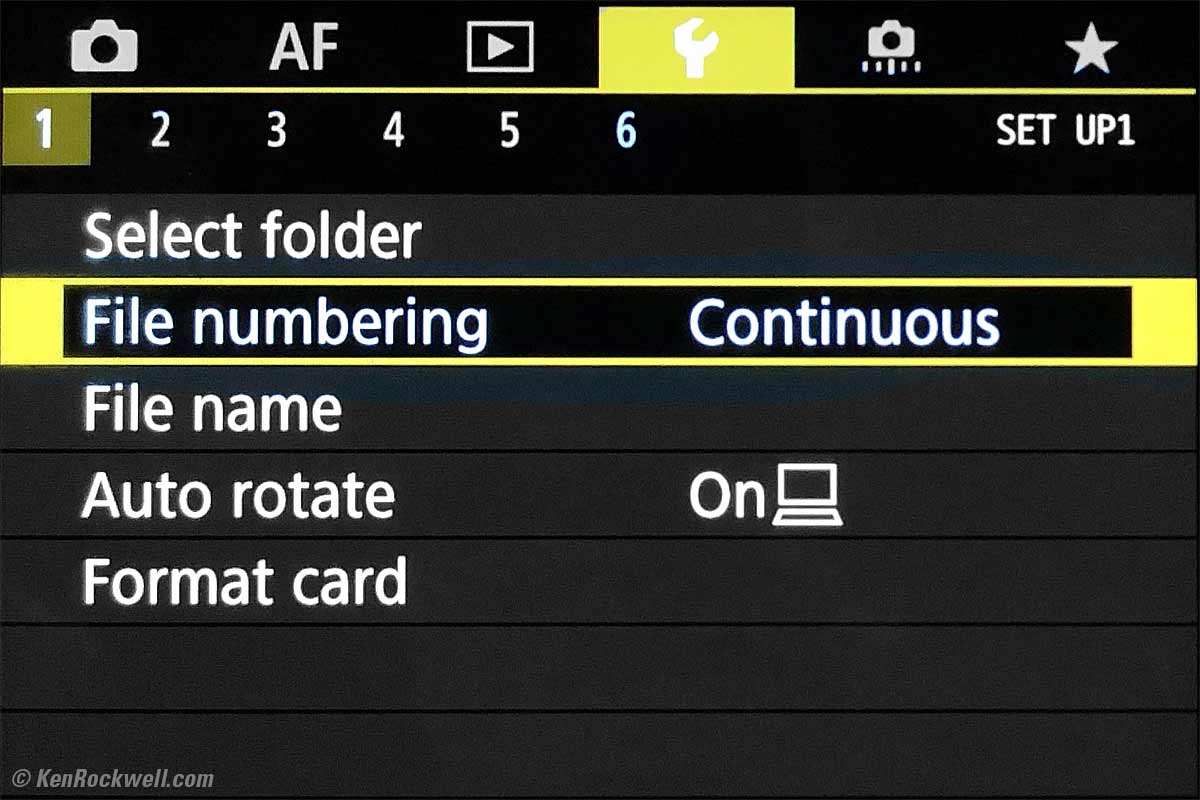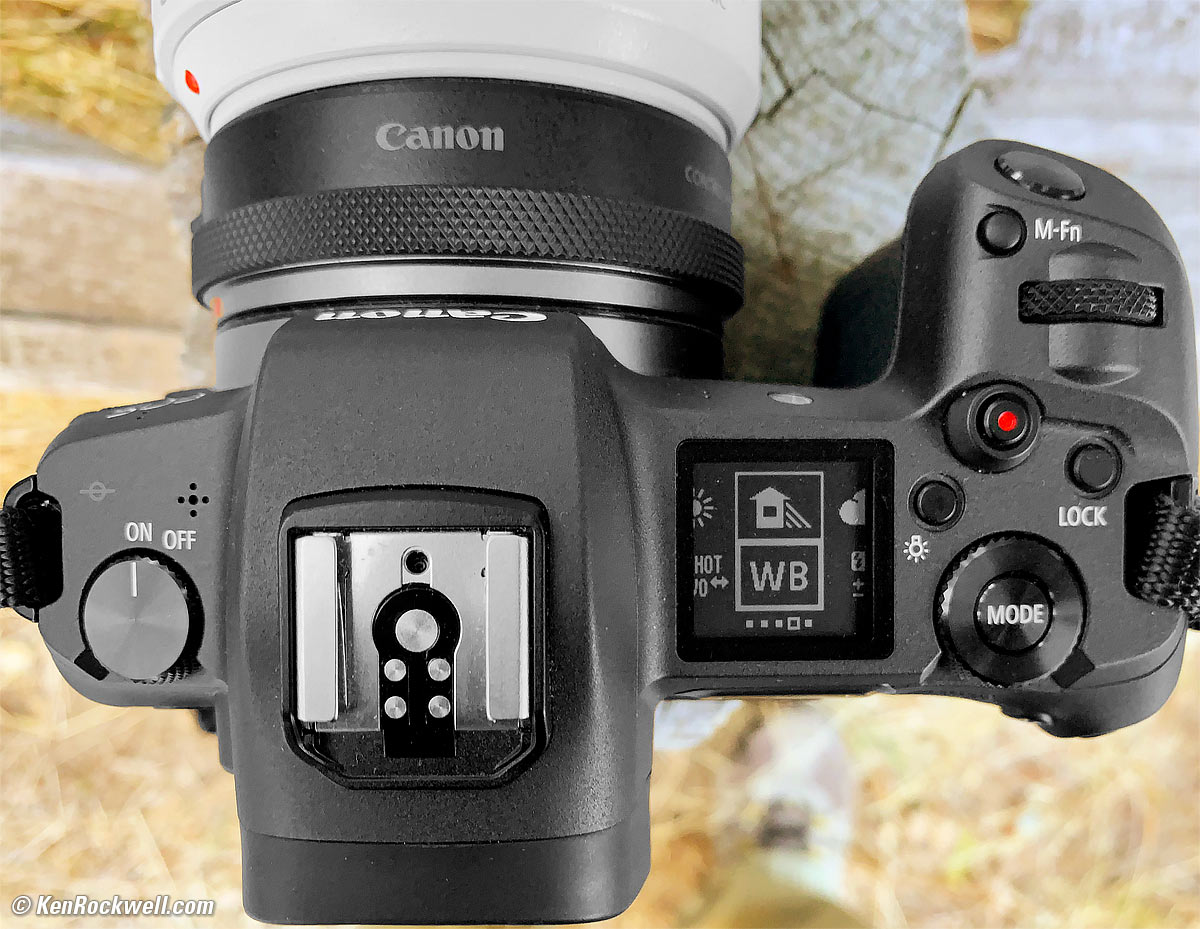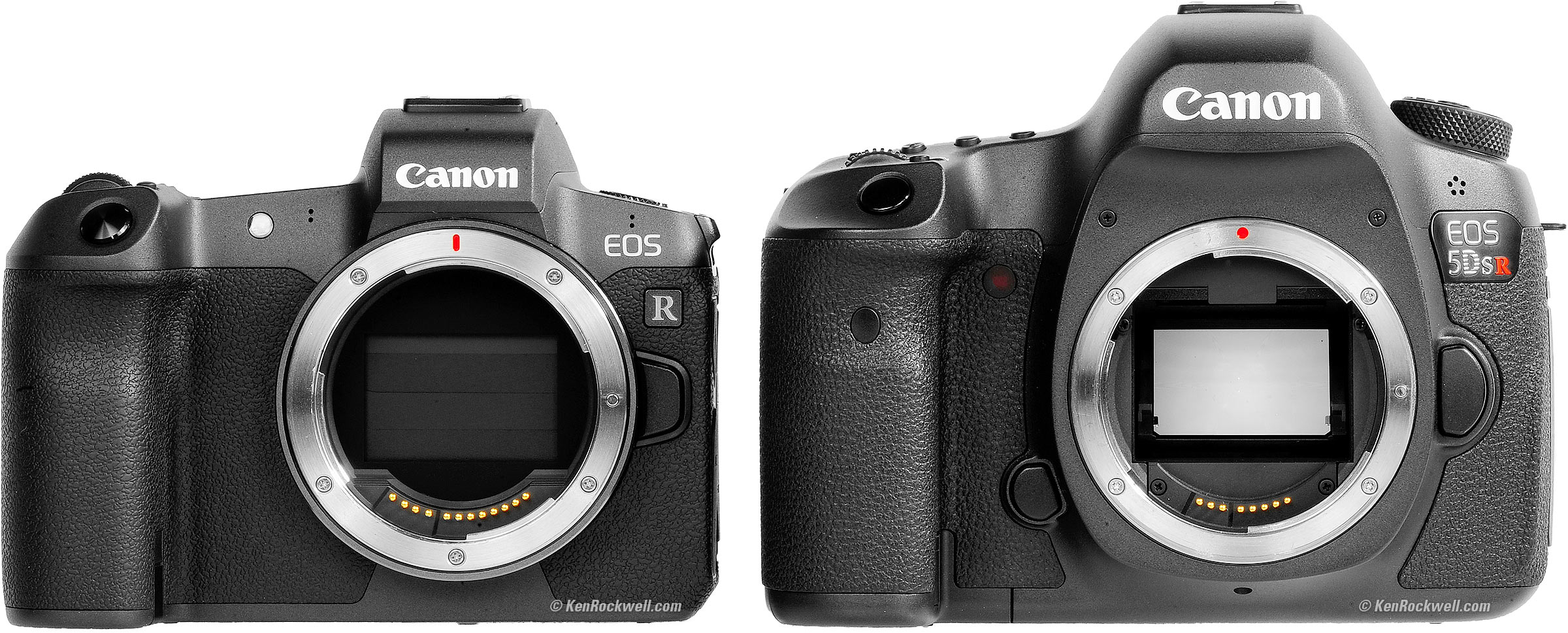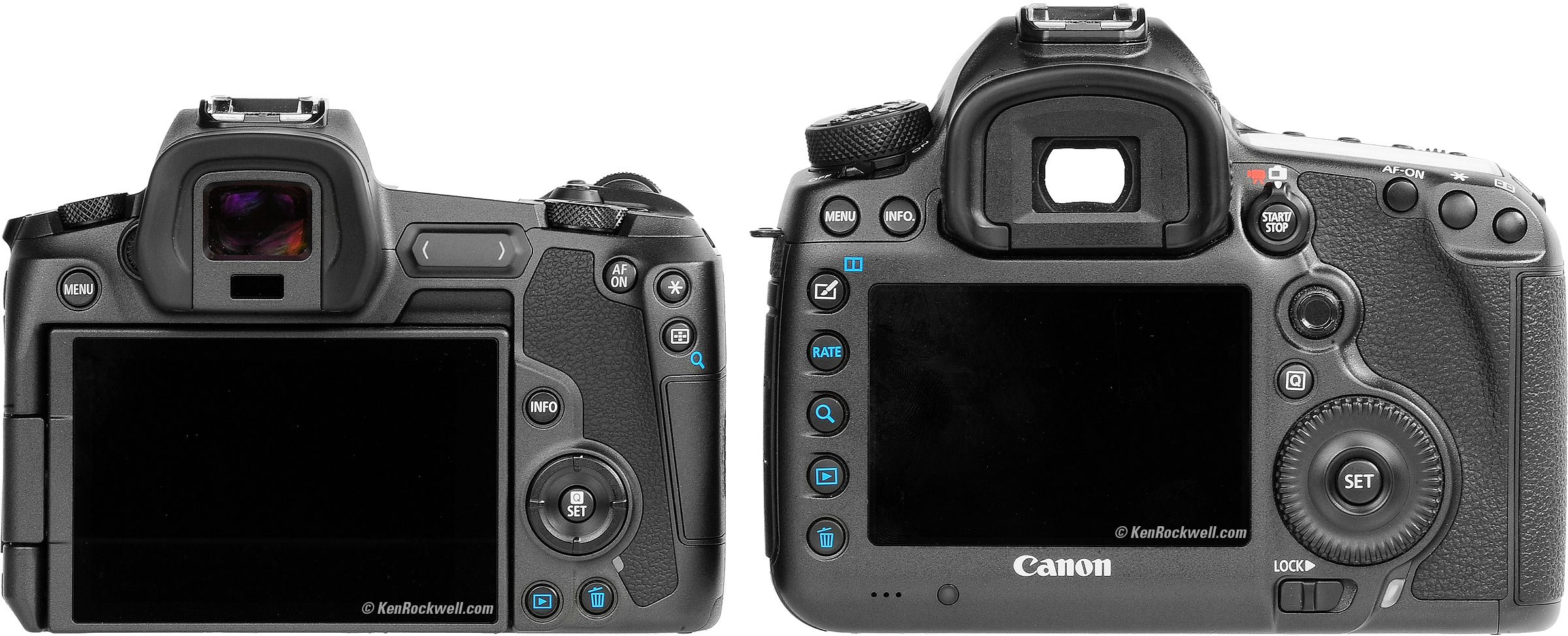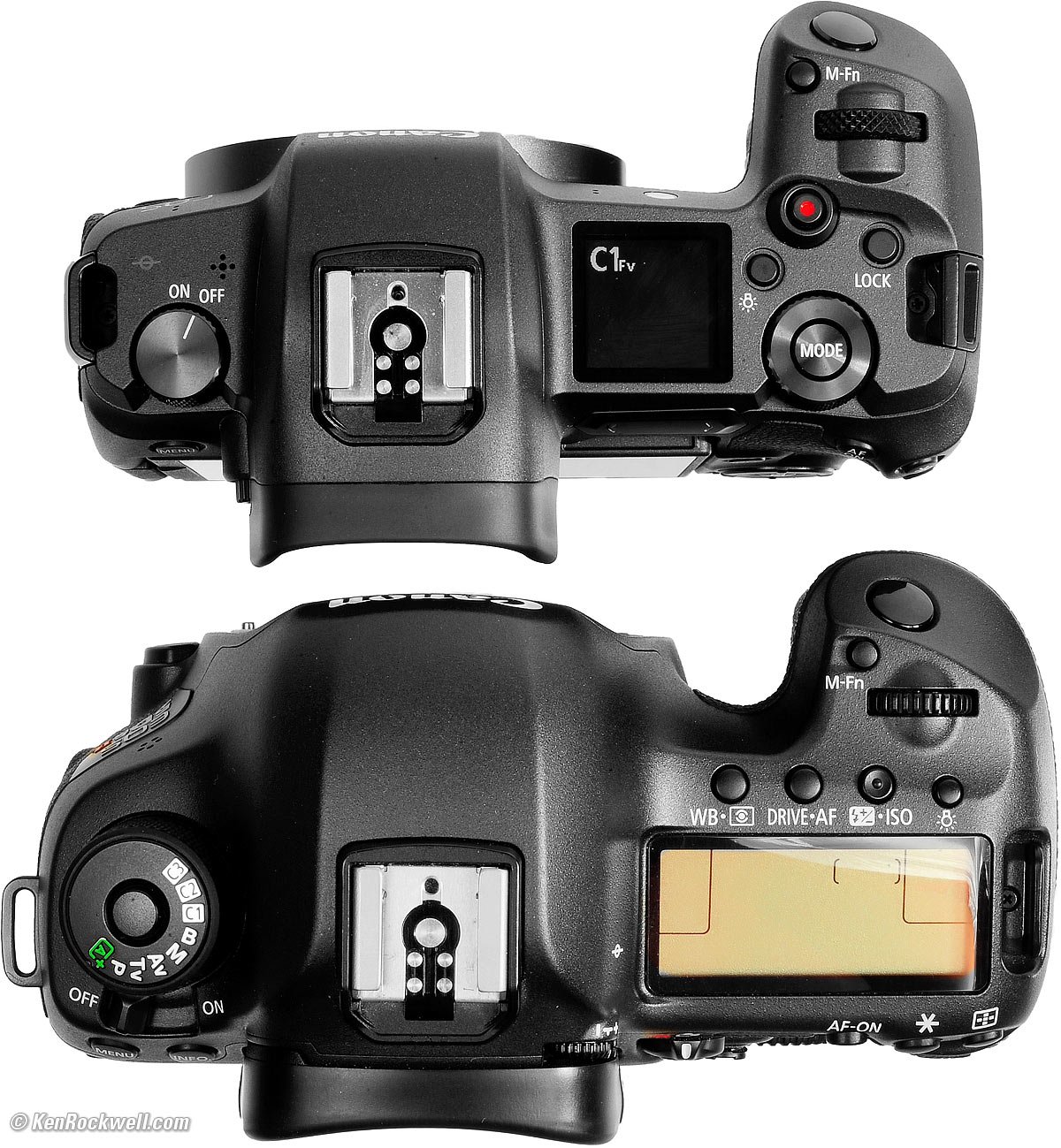Canon EOS R
30 MP Silent 8 FPS Full-Frame Mirrorless
OBSOLETE: The EOS R was discontinued in 2023. Today I'd suggest the newer and far superior EOS R6 Mk II instead, or get the EOS R used if you know How to Win at eBay.
Sample Images Intro Lens Compatibility
Adapters Specs Accessories Performance
Compared User's Guide Recommendations More
R3 R5 R5C R6 II R6 R R8 RP R7 R10 R50 R100
Bodies Compared RF Lenses EF Lenses Flash
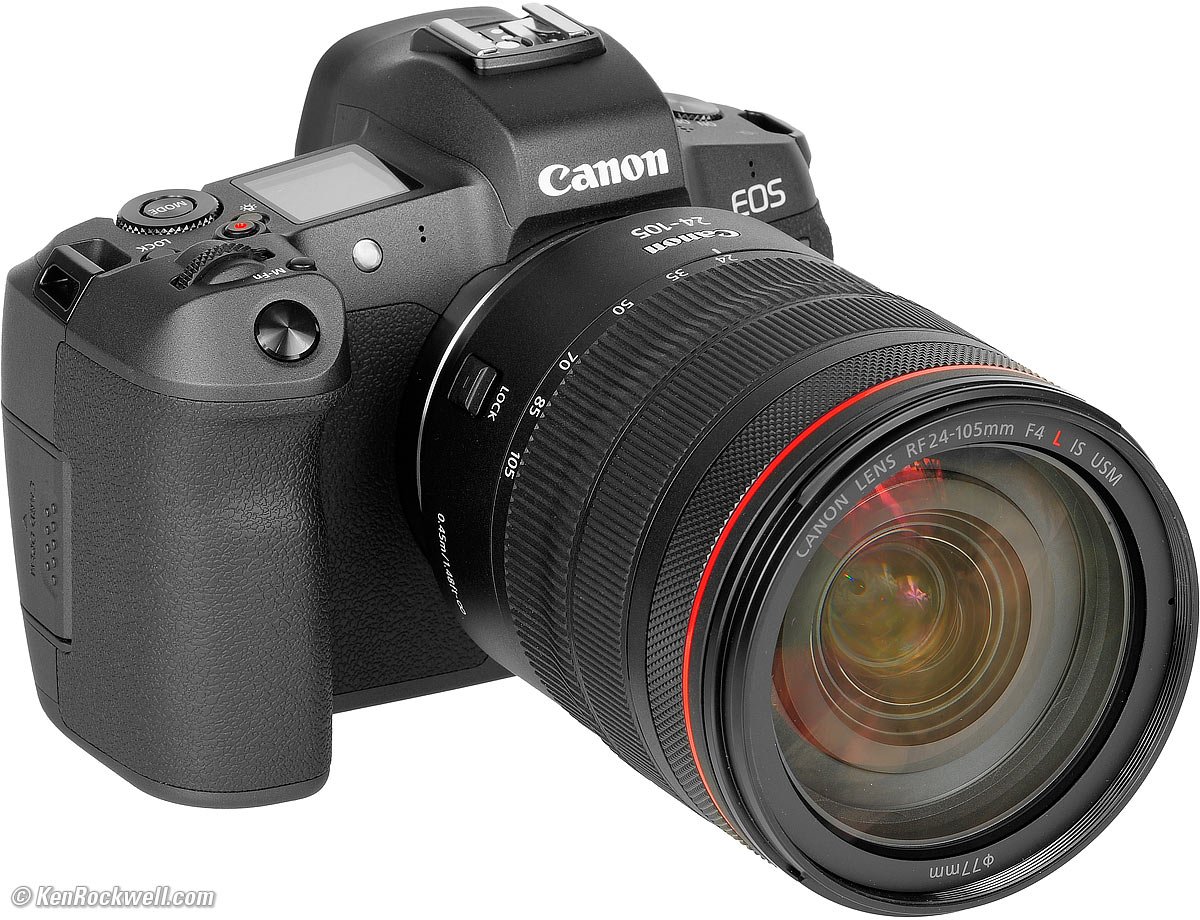
Canon EOS R (one SD card slot, 23.0 oz./652g with battery and SD card, about $900 used if you know if you know How to Win at eBay) and RF 24-105mm f/4L IS. bigger.
EOS R & RF 24-105L kit: $2,845 at Amazon.
About $900 used if you know How to Win at eBay.
This junk-free website's biggest source of support is when you use those or any of these links to my personally-approved sources when you get anything, regardless of the country in which you live. Canon does not seal its boxes in any way, so never buy at retail or any other source not on my personally approved list since you'll have no way of knowing if you're missing accessories, getting a defective, damaged, returned, non-USA, store demo or used camera. Get yours only from the approved sources I use myself for the best prices, service, return policies and selection. Thanks for helping me help you! Ken.
January 2024 Better Pictures Canon Reviews Mirrorless RF Lenses EF Lenses Flash All Reviews
NEW: Canon EOS R vs EOS R8 vs RP.
Nikon vs Canon vs Sony Full Frame Mirrorless Compared
Canon EOS Ra Astro Mirrorless.
The astronomical version of this Canon EOS R, announced 06 November 2019. What's new is that the EOS Ra version offers 30x magnification in Live View for precise focus (I have no idea how well it works in no light, where all systems get so noisy that it's hard to see), and its IR filter passes the 656.28 nanometer H-Alpha line. More about the EOS Ra.
Canon EOS R. bigger.
Canon EOS R. bigger.
Sample Images
Top Sample Images Intro Lens Compatibility
Adapters Specs Accessories Performance
Compared User's Guide Recommendations More
Sophia, Maui. Canon EOS R, Canon RF 24-105mm f/4L IS at 105mm, 1/160 at f/5 at Auto ISO 100, +1 stop exposure compensation, auto WB, Standard Picture Style at +2 saturation. bigger or camera-original © file.
Girl on Rock at Beach, Kapalua, Maui. Canon EOS R, Canon RF 24-105mm f/4L IS at 105mm, 1/640 at f/5.6 at Auto ISO 100, auto WB, Standard Picture Style, -4 contrast, exactly as shot as NORMAL JPG. bigger or camera-original © file.
Girl in Waves at Sunset, Lahaina, Maui. Canon EOS R, Canon RF 24-105mm f/4L IS at 91mm, 1/500 at f/10 at Auto ISO 100, SHADE WB, Standard Picture Style, +4 saturation, exactly as shot as NORMAL JPG. bigger or camera-original © file.
Hawaiian Tiki Torch at Sunset, Lahaina, Maui. Canon EOS R, Canon RF 24-105mm f/4L IS at 77mm, f/8 at 1/320 at Auto ISO 100, SHADE WB, Standard Picture Style, +4 saturation, exactly as shot as NORMAL JPG. bigger or camera-original © file.
Fruit, Kapalua, Maui. Canon EOS R, Canon RF 24-105mm f/4L IS at 67mm, f/7.1 at 1/30 at Auto ISO 250, Standard Picture Style, +4 saturation, Perfectly Clear. bigger, full-resolution or camera-original © file.
Girl in Flowing White Dress, Kapalua, Maui. Canon EOS R, Canon RF 24-105mm f/4L IS at 53mm, f/10 at 1/320 at Auto ISO 100, Standard Picture Style, +4 saturation, Perfectly Clear. bigger, full-resolution or camera-original © file.
Rainbow over Lahaina, Maui. Canon EOS R, Canon RF 24-105mm f/4L IS at 105mm, f/7.1 at 1/400 at Auto ISO 100, Standard Picture Style, +4 saturation, Perfectly Clear. bigger, full-resolution or camera-original © file.
Red Life Preserver, Lahaina, Maui. Canon EOS R, Canon RF 24-105mm f/4L IS at 63mm, f/6.3 at 1/125 at Auto ISO 100, Standard Picture Style, +4 saturation, Perfectly Clear. bigger.
Sunset, Lahaina, Maui. Canon EOS R, Canon RF 24-105mm f/4L IS at 63mm, f/6.3 at 1/125 at Auto ISO 100, Standard Picture Style, +4 saturation, Perfectly Clear. bigger, full-resolution or camera-original © file.
Hawaiian Fire Dancer in Evening Drizzle, Kapalua, Maui. Canon EOS R, Canon RF 24-105mm f/4L IS at 80mm, f/4.5 at 1/125 at Auto ISO 10,000, 2,500K white balanced, Standard Picture Style, +4 saturation, Perfectly Clear. bigger, full-resolution or camera-original © file.
Torrey Pine Tree, 13 September 2018. Canon EOS R, Canon RF 24-105mm f/4L IS at 42mm, 1/100 at f/5 at Auto ISO 100, Standard Picture Style, +4 saturation, Perfectly Clear. bigger or full-resolution.
Sunrise over Mono Lake, October 2018, 7:11 A.M. Canon EOS R, Canon 100-400mm L IS III at 400mm, f/8 hand-held at 1/640 at Auto ISO 100, Perfectly Clear v3.6. bigger or full-resolution.
Tree with Arm, October 2018, 12:07 P.M. Canon EOS R, Canon RF 24-105mm f/4L IS at 56mm, f/8 hand-held at 1/30 at Auto ISO 100, Perfectly Clear v3.6. bigger, full-resolution or camera-original © JPG file.
Yellow Aspen Against Deep Blue Sky, October 2018, 1:26 P.M. Canon EOS R, Canon RF 24-105mm f/4L IS at 39mm, f/10 at 1/400 at Auto ISO 100, Perfectly Clear v3.6. bigger or full-resolution.
The Moon as Seen from the Surface of Mars, October 2018, 5:51 P.M. Canon EOS R, Canon RF 24-105mm f/4L IS at 56mm, f/9 at 1/320 at Auto ISO 100, Perfectly Clear v3.6. bigger or full-resolution.
Virginia Creek Settlement at Dusk, October 2018, 6:35 P.M. Canon EOS R, Canon RF 24-105mm f/4L IS at 24mm, f/4 hand-held at 1/60 at Auto ISO 2,000, Perfectly Clear v3.6. bigger.
Vampire's Lair, Bridgeport, October 2018, 9:01 A.M. Canon EOS R, Canon RF 24-105mm f/4L IS at 50mm, f/4.5 hand-held at 1/15 at Auto ISO 640, Perfectly Clear v3.6. bigger, full-resolution or camera-original © JPG file.
Yellow Aspen Leaf on River Rock, Merced River, Yosemite Valley, October 2018, 7:59 A.M. Canon EOS R, Canon 100-400mm L IS II at 124mm, f/11 at 1/25 hand-held at Auto ISO 400, Perfectly Clear v3.6. bigger.
Rainbow in Bridal Veil Falls, Yosemite Valley, October 2018, 4:36 P.M. Canon EOS R, Canon 100-400mm L IS II at 400mm, f/5.6 hand-held at 1/320 at Auto ISO 100, Perfectly Clear v3.6. bigger.
The Moon as seen from Yosemite Valley, October 2018, 7:17 P.M. Canon EOS R, Canon 100-400mm L IS II with Canon EF Extender 2x II and Canon EF Extender 1.4x II at 1,040mm total, f/16 hand-held at 1/50 at Auto ISO 400, Perfectly Clear v3.6. See this crazy rig that actually works hand-held. bigger.
American Flag in Wood and Light, October 2018, 4:09 P.M. Canon EOS R, Canon RF 24-105mm f/4L IS at 24mm, f/6.3 on a tripod for 30 seconds at ISO 50, Perfectly Clear v3.6. bigger or full-resolution.
Granite, Green and Yellow, Yosemite Valley, October 2018, 5:10 P.M. Canon EOS R, Canon RF 24-105mm f/4L IS at 65mm, f/4 hand-held at 1/80 at Auto ISO 320, Perfectly Clear v3.6. bigger or full-resolution.
Introduction
Top Sample Images Intro Lens Compatibility
Adapters Specs Accessories Performance
Compared User's Guide Recommendations More
|
I buy only from these approved sources. I can't vouch for ads below. |
The EOS R was discontinued in 2023. Today I'd suggest the newer and far superior EOS R6 Mk II instead, or get the EOS R used if you know How to Win at eBay.
The EOS R was revolutionary because it shows how your pictures will come out before you take them.
DSLRs let you view through the lens, but you can't see the actual pictures until you play them back — like film, just faster. The EOS R has an electronic viewfinder that shows exactly how the picture looks, including all Picture Style (color, contrast, etc.) settings, distortion corrections, white balance, highlights and shadows and exposure all LIVE as you look through the finder.
It's a major revolution in photography that will replace DSLRs just as automobiles replaced horses. It will take some years until everyone takes this new kind of camera for granted, but just as digital replaced film, these new mirrorless cameras are replacing DSLRs. We only needed film-era SLR mirrors and ground glass until image sensors became fast enough to read-out in real time.
In-Finder Focus Magnifier, Menus & Zoomed Playback
You can do everything in the finder and never need the rear LCD again.
Especially in direct sunlight, you can always see the big, beautiful finder image so much better than the little rear LCD.
Full-Frame Autofocus
Better than any full-frame DSLR, it can autofocus anywhere in the frame for regular viewfinder shooting.
The EOS R has over 5,000 AF sensors and a big touch pad (the rear LCD) so we can move our selected AF sensor precisely anywhere we want it, all while keeping our eye on the finder.
The EOS R is rated to LV -6 for autofocus, which means that it can focus in almost total darkness. Of course it gets slower, but I kid you not, it sees better in dim light than I do. Its finder, even with my f/4 24-105mm, becomes much brighter and more detailed than the scene itself — while my DSLR finder is always darker than the actual scene.
Extraordinary Performance with Teleconverters
The EOS R works fantastically with teleconverters and the EF Lens Adapters, with fast, full-frame autofocus with my 100‑400L IS II and even when used with both my 1.4x and 2x converters at the same time! That's a 280‑1,120mm f/12.6‑16 equivalent, easily hand-holdable!
This is because the AF sensors are on the image sensor, not buried deep inside a DSLR, so they see what the sensor sees and just work. With a DSLR, only the center AF sensor works at all with the 2x converter, and there is no AF when using both converters at the same time with the 100-400.
The Most Accurate Autofocus of Any Canon Camera.
The EOS R's on-sensor AF detectors are immune to mechanical misalignment that plagues DSLRs. (DSLR AF detectors are in the base of the camera, coupled with a multiple mirror system.)
The EOS R doesn't need AF microadjustments because its direct on-sensor system doesn't have any errors. I get perfect autofocus with my ultraspeed f/1, f/1.2, and f/1.4 lenses, even older lenses on an adapter, every time. (Of course bad technique will still give bad pictures; Canon hasn't fixed that yet.)
Better Lenses for Better Pictures
I've tested the new RF 24-105mm f/4L IS and RF 50mm f/1.2 L, and as promised they outperform the best DSLR lenses. Of course you need to be a virtuoso to be able to see the difference, but if you are, these are the sharpest and least distorting lenses ever.
If I look too closely, my EF 50mm f/1.2 L on my 50MP 5DS/R looks broken by comparison to the sharpness I get from the new RF 50mm f/1.2 L on my merely 30 MP EOS R. At f/1.2, the new lens makes the EOS R sharper than my 5DS/R, especially when you realize that focus is also so much more accurate and consistent on the EOS R.
Lens makers usually blow fluff about new lenses, but with the EOS R's new lens mount that gives lens designers more leeway to design awesome lenses, it really shows.
Works Flawlessly with every EF and every EF-S lens with a $99 lens adapter:
Control Ring Mount Adapter EF-EOS R.
Image Stabilization, autofocus and everything work fast and sure with all the EF lenses we already own.
These adapters have only air inside them; they have no effect on angle-of-view, focal length or optical performance.
My 50mm f/1 works better than ever, with perfect AF accuracy at f/1. Existing EF lenses seem to autofocus at least as fast on the EOS R as on a regular DSLR! Whoopee!
Not only do old lenses work, all of them introduced since about 1990 also have a Digital Lens Optimizer with all sorts of distortion and other corrections that no 35mm SLR and many DSLRs lacked!
EOS R Body: $1,590 at Amazon, or about $900 used if you know How to Win at eBay.
EOS R & RF 24-105L kit: $2,865 at Amazon.
New
 The EOS R is quieter than a DSLR, and it also has a completely silent mode which no DSLR can do in regular shooting.
The EOS R is quieter than a DSLR, and it also has a completely silent mode which no DSLR can do in regular shooting.
 New EOS R lens mount: 54.00mm inner diameter by 20.00mm flange focal distance and 12 electronic contacts.
New EOS R lens mount: 54.00mm inner diameter by 20.00mm flange focal distance and 12 electronic contacts.
 New customizable Multi-Function (M-Fn) bar just to the right of the eyepiece. It can be set to control ISO, WB, etc. It replaces the several buttons that used to be on top of DSLRs; the EOS R isn't big enough to hold them.
New customizable Multi-Function (M-Fn) bar just to the right of the eyepiece. It can be set to control ISO, WB, etc. It replaces the several buttons that used to be on top of DSLRs; the EOS R isn't big enough to hold them.
 Has the first new exposure mode invented since the 1980s: the new Fv exposure mode works like Program, but lets us adjust any or all of Aperture, Shutter Speed, Exposure Compensation and ISO as we like while the other options continue to update automatically.
Has the first new exposure mode invented since the 1980s: the new Fv exposure mode works like Program, but lets us adjust any or all of Aperture, Shutter Speed, Exposure Compensation and ISO as we like while the other options continue to update automatically.
 While traditional Program mode reset to defaults as soon as the meter shut off, anything you shift in Fv mode stays that way until you reset it back to full auto simply by tapping the right side of the four-way rear controller.
While traditional Program mode reset to defaults as soon as the meter shut off, anything you shift in Fv mode stays that way until you reset it back to full auto simply by tapping the right side of the four-way rear controller.
 Up to 8 FPS with locked focus and up to 5 FPS with tracking autofocus and exposure.
Up to 8 FPS with locked focus and up to 5 FPS with tracking autofocus and exposure.
 The top LCD is now a sharp dot-matrix display.
The top LCD is now a sharp dot-matrix display.
 The top LCD can be toggled between basic and detailed displays.
The top LCD can be toggled between basic and detailed displays.
 First Canon with UHS-II card compatibility.
First Canon with UHS-II card compatibility.
 No more CR2 raw files; they are now a new CR3 format.
No more CR2 raw files; they are now a new CR3 format.
 New Battery Grip BG-E22 holds two battery LP-E6N (or LP-E6), $490.
New Battery Grip BG-E22 holds two battery LP-E6N (or LP-E6), $490.
 New RF 24-105mm f/4L IS.
New RF 24-105mm f/4L IS.
 New RF 50mm f/1.2 L.
New RF 50mm f/1.2 L.
 New RF 28-70mm f/2 L.
New RF 28-70mm f/2 L.
 New RF 35mm IS Macro STM.
New RF 35mm IS Macro STM.
Good
Finder & Rear LCD
 Brilliantly sharp finder shows exactly how the pictures will turn out, before you take them.
Brilliantly sharp finder shows exactly how the pictures will turn out, before you take them.
 New finder also plays-back, zooms and shows menus.
New finder also plays-back, zooms and shows menus.
 Finder even shows live automatic distortion correction! What you're seeing is exactly what you'll get in your finished images.
Finder even shows live automatic distortion correction! What you're seeing is exactly what you'll get in your finished images.
 EVF/LCD automatic eye control works perfectly; the display you want is always on when you want it on.
EVF/LCD automatic eye control works perfectly; the display you want is always on when you want it on.
 Data displays can rotate with the camera.
Data displays can rotate with the camera.
 Live RGB histograms in three different sizes let you precisely judge exposure before you press the shutter. This is especially helpful with white areas and boldly saturated colors with the crazy +4 saturation settings I use.
Live RGB histograms in three different sizes let you precisely judge exposure before you press the shutter. This is especially helpful with white areas and boldly saturated colors with the crazy +4 saturation settings I use.
 Focus distance optionally displayed, complete with depth of field scale! (needs a native RF lens; adapted lenses won't do this.)
Focus distance optionally displayed, complete with depth of field scale! (needs a native RF lens; adapted lenses won't do this.)
 Flipping touch screen can show the same or different things as the finder.
Flipping touch screen can show the same or different things as the finder.
Autofocus
 Excellent AF covers and tracks around the entire frame. Now we can autofocus all the way out to the corners!
Excellent AF covers and tracks around the entire frame. Now we can autofocus all the way out to the corners!
 Right side of the touch screen replaces the thumb nubbin for selecting AF areas while looking though the finder. The screen allows far faster and more precise selection than the nubbin ever did.
Right side of the touch screen replaces the thumb nubbin for selecting AF areas while looking though the finder. The screen allows far faster and more precise selection than the nubbin ever did.
 Over 5,000 AF points means we can always get one exactly where we need it.
Over 5,000 AF points means we can always get one exactly where we need it.
 No AF Fine Tune needed because on-sensor AF detectors don't have any of the mechanical alignment problems of DSLRs, whose sensors are coupled with mirrors to detectors in the bottom of a DSLR. EOS R autofocus is always dead-on, even with adapted EF lenses, if you use it properly.
No AF Fine Tune needed because on-sensor AF detectors don't have any of the mechanical alignment problems of DSLRs, whose sensors are coupled with mirrors to detectors in the bottom of a DSLR. EOS R autofocus is always dead-on, even with adapted EF lenses, if you use it properly.
Lenses & Compatibility
 Works brilliantly with 100% of all EF and EF-S lenses on an adapter.
Works brilliantly with 100% of all EF and EF-S lenses on an adapter.
 EF lens autofocus on the adapter seems faster than on my EOS DSLRs, now covers the entire frame and nails accurate focus better than any of my DSLRs. EF lens exposure accuracy is also improved over what it was on DSLRs.
EF lens autofocus on the adapter seems faster than on my EOS DSLRs, now covers the entire frame and nails accurate focus better than any of my DSLRs. EF lens exposure accuracy is also improved over what it was on DSLRs.
 Automatically corrects for falloff & distortion and has a digital lens optimizer to correct diffraction, coma and more.
Automatically corrects for falloff & distortion and has a digital lens optimizer to correct diffraction, coma and more.
 Automatic corrections even work for most old EF lenses introduced since about 1992 when used on an adapter.
Automatic corrections even work for most old EF lenses introduced since about 1992 when used on an adapter.
Power & Batteries
 I get about 1,000 shots per charge in the ECO mode with plenty of playing with the camera and its menus. I can get over 7,000 shots per charge if I just let it motor away in Continuous mode without playing anything back or making settings. Of course when I first got it and played in the menus for hours I only got 300 shots on the first charge. The more you shoot and the less you play, the more shots you get, and the ECO mode works great without reducing performance. Expect about 350 shots when you first get it and do more playing than shooting, and then about 1,000 shots per charge as you shoot normally, or thousands per charge if you're usually motoring away in Continuous mode.
I get about 1,000 shots per charge in the ECO mode with plenty of playing with the camera and its menus. I can get over 7,000 shots per charge if I just let it motor away in Continuous mode without playing anything back or making settings. Of course when I first got it and played in the menus for hours I only got 300 shots on the first charge. The more you shoot and the less you play, the more shots you get, and the ECO mode works great without reducing performance. Expect about 350 shots when you first get it and do more playing than shooting, and then about 1,000 shots per charge as you shoot normally, or thousands per charge if you're usually motoring away in Continuous mode.
 Same superior batteries and chargers as 7D, 5D etc.
Same superior batteries and chargers as 7D, 5D etc.
 Power saving display and ECO modes really do extend battery life and don't seem to have any effect on performance, bravo!
Power saving display and ECO modes really do extend battery life and don't seem to have any effect on performance, bravo!
Shutter
 It's easy to program the EOS R to make precisely timed exposures of any length up to 100 hours, without needing any remote release cord!
It's easy to program the EOS R to make precisely timed exposures of any length up to 100 hours, without needing any remote release cord!
 Silent electronic shutter.
Silent electronic shutter.
 Even the regular mechanical shutter is pretty quiet.
Even the regular mechanical shutter is pretty quiet.
Mechanics
 Shutter closes when off; no dust problems like Sony.
Shutter closes when off; no dust problems like Sony.
 Elegant dull titanium finish on outsides of lens mounts.
Elegant dull titanium finish on outsides of lens mounts.
 New, more effective dirt gaskets designed as an integral part of the lenses and lens mount.
New, more effective dirt gaskets designed as an integral part of the lenses and lens mount.
Ergonomics
 Feels great in hand with a comfortable curved design, not all straight edges like Sony.
Feels great in hand with a comfortable curved design, not all straight edges like Sony.
 Easy-to-locate buttons by feel. Not only are the buttons themselves easy to feel, the curved design puts each button in a unique location so we know where they are without having to grope around as we do on Sony.
Easy-to-locate buttons by feel. Not only are the buttons themselves easy to feel, the curved design puts each button in a unique location so we know where they are without having to grope around as we do on Sony.
 Superior color-coded menu system, best in the industry, makes it easy to remember where to find things. We don't have to look everywhere as we do with Sony.
Superior color-coded menu system, best in the industry, makes it easy to remember where to find things. We don't have to look everywhere as we do with Sony.
Video
 Live 4K HDMI output.
Live 4K HDMI output.
 Built-in stereo mic and 3.5mm stereo mic & headphone jacks.
Built-in stereo mic and 3.5mm stereo mic & headphone jacks.
 Can shoot to card up to 480MB/s.
Can shoot to card up to 480MB/s.
 1/8-stop exposure increments for video shooting.
1/8-stop exposure increments for video shooting.
And more...
 Standard i-TTL II flash system works with all our EX series flash.
Standard i-TTL II flash system works with all our EX series flash.
 Even when turned off, the top LCD continues to show the shooting mode.
Even when turned off, the top LCD continues to show the shooting mode.
 Wi-Fi.
Wi-Fi.
 Bluetooth.
Bluetooth.
 Takes standard SD, SDHC or SDXC cards.
Takes standard SD, SDHC or SDXC cards.
 App remote-control.
App remote-control.
 Electronic in-camera stabilization, but only for video.
Electronic in-camera stabilization, but only for video.
 Made in Japan.
Made in Japan.
 100% U. S. A.-based high-quality technical support at (800) OK-CANON.
100% U. S. A.-based high-quality technical support at (800) OK-CANON.
Bad
 Wakeup isn't always instantaneous like a DSLR, but it's fast enough.
Wakeup isn't always instantaneous like a DSLR, but it's fast enough.
Missing
 No second card slot.
No second card slot.
 No thumb nubbin. While the touch screen is a huge improvement for selecting AF zones (especially during viewfinder shooting), the touch screen doesn't work during viewfinder playback or viewfinder menu selection as I'd like (it always works when the LCD is lit, just not always when you're looking in the finder).
No thumb nubbin. While the touch screen is a huge improvement for selecting AF zones (especially during viewfinder shooting), the touch screen doesn't work during viewfinder playback or viewfinder menu selection as I'd like (it always works when the LCD is lit, just not always when you're looking in the finder).
 Silent shutter is great, but at least as of firmware 1.0.0 you can't use the EOS R in Continuous shutter mode in Silent. Canon will fix this in firmware, but you still can't use flash, HDR or flicker reduction in silent (no silent camera can).
Silent shutter is great, but at least as of firmware 1.0.0 you can't use the EOS R in Continuous shutter mode in Silent. Canon will fix this in firmware, but you still can't use flash, HDR or flicker reduction in silent (no silent camera can).
 No sensor-shift stabilization, same as every Canon DSLR. IBIS was for other brands that haven't mastered optical IS as Canon has. IBIS works poorly with wide lenses; in-lens optical IS works far better.
No sensor-shift stabilization, same as every Canon DSLR. IBIS was for other brands that haven't mastered optical IS as Canon has. IBIS works poorly with wide lenses; in-lens optical IS works far better.
 No auto brightness control for rear LCD, but set it to its maximum manually and it's bright enough to use in direct sunlight.
No auto brightness control for rear LCD, but set it to its maximum manually and it's bright enough to use in direct sunlight.
 No auto brightness control for electronic finder; you have to bump it up manually outdoors and knock it down manually at night for the best results.
No auto brightness control for electronic finder; you have to bump it up manually outdoors and knock it down manually at night for the best results.
 No ability to save and recall camera settings to and from a card.
No ability to save and recall camera settings to and from a card.
 There's a level, but oddly it goes away if Face Detection is on. See my User's Guide for how I set my EOS R to allow fast selection of AF area modes. Alternately, I use C1 for photos of things (level and no face detect) and C2 for people photos (face detect and no level).
There's a level, but oddly it goes away if Face Detection is on. See my User's Guide for how I set my EOS R to allow fast selection of AF area modes. Alternately, I use C1 for photos of things (level and no face detect) and C2 for people photos (face detect and no level).
 We can set the finder to magnify the selected AF point automatically anytime the manual focus ring is turned (even while in autofocus), but oddly no mirrorless camera has any way to make this automatic magnification stop so we can see to compose and shoot after manual focus override. It unmagnifies if we remove our finger from the shutter, but AF takes over again if we press the shutter to shoot. Of course instant manual focus override works perfectly if you don't also ask it to magnify automatically or if you magnify manually (see my User's Guide).
We can set the finder to magnify the selected AF point automatically anytime the manual focus ring is turned (even while in autofocus), but oddly no mirrorless camera has any way to make this automatic magnification stop so we can see to compose and shoot after manual focus override. It unmagnifies if we remove our finger from the shutter, but AF takes over again if we press the shutter to shoot. Of course instant manual focus override works perfectly if you don't also ask it to magnify automatically or if you magnify manually (see my User's Guide).
 You can program and reprogram just about every button, but the one button we can't reprogram is the LOCK button. I wish I could.
You can program and reprogram just about every button, but the one button we can't reprogram is the LOCK button. I wish I could.
 SERVO and ONE-SHOT AF modes, but no AI FOCUS mode as in some other cameras which automatically selects between the other two modes.
SERVO and ONE-SHOT AF modes, but no AI FOCUS mode as in some other cameras which automatically selects between the other two modes.
 No localized histograms; when you zoom playback the histogram goes away.
No localized histograms; when you zoom playback the histogram goes away.
 No GPS; use the Canon GP-E2 or the free app to tag images with GPS data.
No GPS; use the Canon GP-E2 or the free app to tag images with GPS data.
 No built-in flash.
No built-in flash.
 No NFC.
No NFC.
Lens Compatibility
Top Sample Images Intro Lens Compatibility
Adapters Specs Accessories Performance
Compared User's Guide Recommendations More
EOS R & RF 24-105L kit: $2,845 at Amazon.
About $900 used if you know How to Win at eBay.
Canon EOS R. bigger.
This uses a new Canon RF lens mount, also called the EOS R mount.
It has a 20.00mm flange focal distance and 54.00mm inside diameter.
Canon EOS R and native RF 50mm f/1.2 L. bigger.
EF and EF-S Mount Adapters
Top Sample Images Intro Lens Compatibility
Adapters Specs Accessories Performance
Compared User's Guide Recommendations More
EOS R & RF 24-105L kit: $2,845 at Amazon.
About $900 used if you know How to Win at eBay.
See EF mount adapters for all the details on the four different adapters.
Use any of the EF mount adapters and all Canon EF and EF-S lenses made since 1987 work flawlessly, with 100% performance with all features on all lenses.
There is nothing but air inside each adapter; there is no change in optical performance, bokeh, depth-of-field or angle-of-view.
Not only does every feature of every EF lens work great with the adapters; new additional features that work with lenses introduced since about 1990 are a Digital Lens Optimizer, distortion and other lens corrections.
Canon EOS R and EF 14mm f/2.8L on EF Adapter with Control Ring. bigger.
Canon EOS R and EF 14mm f/2.8L on EF Adapter with Control Ring. bigger.
Tokyo, 10 September 2018. Canon EOS R, Canon 14mm f/2.8L on adapter, f/11 hand-held at 1/6 at ISO 500, auto WB, Standard Picture Style with +4 saturation, Perfectly Clear. bigger, full-resolution or camera-original © file.
The EOS R does a brilliant job of correcting distortion and lateral color fringes in my old 14mm lens.
Canon EOS R and EF 50mm f/1.0 L on EF Adapter with Control Ring. bigger.
Canon EOS R and EF 50mm f/1.0 L on EF Adapter with Control Ring. bigger.
My 50mm f/1.0 seems to autofocus faster on my EOS R than on any of my SLRs or DSLRs, and most importantly it always focuses perfectly, especially at f/1.0 where this lens sees as much as the human eye — something which no f/1.2 or f/0.95 lens can do.
EOS-M Lens Compatibility
There can be no adapter to use EOS-M lenses on the EOS R because the EOS-M has a shorter 18.00mm flange focal distance (FFD) than the 20.00mm FFD of the EOS R.
In English, the EOS R's lens mount pokes out too much for EOS-M lenses to be able to adapt. EOS-M lenses are APS-C anyway, so don't worry about it; they can't cover the full-frame EOS R sensor.
Just use an EOS-M camera for EOS-M lenses.
FD Lens Compatibility
The Chinese make dedicated FD to RF adapters that take advantage of the EOS R's short 20mm flange-focal-distance. Alternately you use any of the the new EF adapters with a classic FD - to - EOS adapter for FD lenses, but they had to use internal optics that degraded optical performance.
With any of these set MENU > C.Fn > page 5 > Release shutter w/o lens > ON. This is OFF by default and the camera won't shoot unless you set this:
We all know the classic FD to EOS adapter needed internal optics to correct infinity focus because the EOS flange focal distance is greater than the FD flange focal distance. I asked if Canon would be announcing a new dedicated FD to EOS R adapter that won't need any internal optics, and they said no. No worries, the Chinese will have plenty of third-party ones over eBay eventually that won't need the adapter optics and will have far better performance than using a classic FD - to - EOS adapter with an EF adapters.
I tried this $20 Chinese FD to EOS adapter:
$20 Chinese FD to EOS adapter, with internal optics. bigger.
And as expected performance wasn't great at fast apertures like f/1.2 due to the adapter's dinky optics; at f/1.2 you get a soft-focus effect. Stopped down it worked OK, but if you're serious about image quality, you're not using adapters and using native RF lenses.
As with all non-electronically coupled adapters, exposure was random, often requiring a stop or two of exposure compensation depending on the aperture. It's the same with Sony cameras; with these adapters the camera has no idea of the lens' aperture and has to guess.
Other Brands
The short 20mm flange focal distance of the EOS R means we'll be able to adapt just about anything to it, especially FD lenses, as soon as third parties set up their CNC machines — but we'll have to wait until the Chinese offer these.
More great news is that there is plenty of room with the short flange focal distance for adapters to be made to adapt LEICA M and screw-mount lenses, Nikon F-mount lenses, Nikonos lenses, and yes, Canon FD and all kinds of 1930s-1960s rangefinder lenses to our EOS Rs.
Be sure to set MENU > C.Fn > page 5 > Release shutter w/o lens > ON. This is OFF by default and the camera won't shoot unless you set this.
Specifications
Top Sample Images Intro Lens Compatibility
Adapters Specs Accessories Performance
Compared User's Guide Recommendations More
EOS R & RF 24-105L kit: $2,845 at Amazon.
About $900 used if you know How to Win at eBay.
Lens Mount
New Canon RF mount.
54.00mm inner diameter × 20.00mm flange focal distance.
Image Sensor
30 MP.
24.0 × 36.0 mm CMOS.
5.36 µm pixel pitch.
Anti-alias filter.
3:2 aspect ratio.
1.0× crop factor.
Ultrasonic cleaner.
ISO
ISO 100 ~ 40,000.
ISO 50 ~ 102,400 in expanded modes.
Video: ISO 100 ~ 25,600 in HD, ISO 100 ~ 12,800 in 4K.
Auto ISO
Adjustable for high and low limits from ISO 100 to ISO 40,000 in most exposure modes.
Image Sizes
6,720 × 4,480 pixels native JPG/RAW/C-RAW (30 MP).
Medium: 4,464 x 2,976
Small 1: 3,360 x 2,240
Small 2: 2,400 x 1,600
4:3 crop
Large/RAW/C-RAW: 5,952 x 4,480
Medium: 3,968 x 2,976
Small 1: 2,976 x 2,240
Small 2: 2,112 x 1,600
1:1 Square crop
Large/RAW/C-RAW: 4,480 x 4,480
Medium: 2,976 x 2,976
Small 1: 2,240 x 2,240
Small 2: 1,600 x 1,600
APS-C (1.6x) crop
Large/RAW/C-RAW: 4,176 x 2,784
Small 2: 2,400 x 1,600
16:9 crop
Large/RAW/C-RAW: 6,720 x 3,776
Medium: 4,464 x 2,512
Small 1: 3,360 x 1,888
Small 2: 2,400 x 1,344
Still Formats
JPG and/or 14-bit raw.
sRGB and Adobe RGB.
Frame Rates
To 5 FPS with tracking autofocus and exposure.
To 8 FPS with locked focus and exposure.
3 FPS in Continuous Low.
Buffer (Burst) Sizes
100 to 110 frames in most modes.
34 to 47 in raw, depending on card speed.
Video
More details at the Canon Learning Center.
Recorded File Formats
MP4 files containing MPEG-4 AVC/ H.264 compressed video data.
4:2:0 8-bit, Rec. 709 color space.
When Canon Log is enabled, the video signal range for internal recordings is 32 to 254, and 0 to 255 for all others. The metadata flags either file option (Canon Log/Non Canon Log) for Full range.
4K UHD bit rates average 480 Mbps using ALL-I compression, and 120Mbps with IPB.
Linear PCM (with all-I video) or AAC Audio (with IPB video).
Sensor Areas
HD video uses a 16:9 full-width crop from the 3:2 sensor, and downsampled.
4K (3,840 x 2,160) uses a direct-sampled 3,840 x 2,160 area in the middle of the 6,720 x 4,480 sensor to reduce processing load, improve throughput and avoid resampling artifacts.
Direct 4K HDMI Output
Uncompressed 4K UHD 4:2:2 10- or 8-bit.
Canon Log gamma.
128 to 1016/Full range, 174 to 934/Video range for devices that do not support Full range.
Rec. 709 or Rec. 2020 color spaces.
Neutral (Rec. 709 or Rec. 2020) and Cinema EOS Original (Rec. 709) color matrices.
Maximum Take Length
Half hour (29:59).
Stills While Rolling Video
I couldn't get it to do that; you'd have to pull them out later.
4K (3,840 x 2,160)
29.97 all-I or IPB.
24.00 all-I or IPB.
23.976 all-I or IPB.
1,920 x 1,080
59.94 all-I or IPB.
29.97 all-I or IPB, also IPB light.
24.00 all-I or IPB.
23.976 all-I or IPB.
1,280 x 720
119.9 all-I.
59.94 all-I or IPB.
29.97 IPB.
Audio
Recorded only along with video.
Linear PCM (with all-I video) or AAC Audio (with IPB video).
Stereo microphones built in.
Mic-in jack with plug-in power overrides built-in mic.
You can set the multifunction bar to be the manual level control. This is the Movie Record option.
Headphone jack.
Stabilization
Electronic video stabilization rated five stops improvement.
No sensor-shift.
Still image stabilization only in-lens.
Autofocus
5,655 dual-pixel AF phase-detection points, when selected manually.
Rated LV -6 to +18 with an f/1.2 lens, which is the same as -4 to +20 with an f/2.4 lens.
Face and eye tracking.
Amber LED AF assist beam.
Light Meter
384 segment (16 x 24) evaluative.
6.4% partial.
2.7% spot (oddly no AF-point linking)
Meter range LV -3 to +20.
Electronic Finder
3,690,000 dot OLED.
100% coverage.
0.76× magnification with 50mm lens.
33.3º apparent field.
-4 to +2 diopters.
23 mm eyepoint.
Shutter
Vertical focal plane and electronic shutters.
Fully mechanical, fully silent and first-curtain electronic with mechanical second curtain modes.
1/8,000 ~ 30 seconds and Bulb.
Remote Releases
Remote control via a free app.
It also uses a single-pin remote terminal; use the RS-60E3 remote cord.
Use the RA-E3 adapter to use three-pin remote cords.
Flash
Standard E-TTL II system.
1/200 sync speed.
FE lock.
Built-in Flash?
NONE.
External Flash
Dedicated hot shoe.
No Prontor-Compur (PC) terminal on the camera, but there is one on the Battery Grip BG-E22, or just use a hot-shoe adapter.
LCD Monitor
Canon EOS R flipping LCD. bigger.
3.15" (80 mm) diagonal.
1.75 x 2.63" (44.4 x 66.7mm) image area.
3:2 aspect ratio.
Flip screen.
2,100,000 dots.
Anti-smudge coating.
No anti-reflection coating.
No auto brightness control.
Top Dot-Matrix LCD
Canon EOS R. bigger.
The top LCD is now a sharp dot-matrix display.
Tap the light (☀) button to swap between basic and detailed displays.
It's usually white-on-black as shown, but if you hold the light (☀) button a couple of seconds, it reverts to black-on-white and has a dim, cool-white backlight.
Connectors
Canon EOS R. bigger.
Remote connector.
3.5mm stereo mic jack.
3.5mm headphone jack.
USB 3.1, type C connector.
HDMI type C, NOT CEC compatible.
WiFi
IEEE 802.11b/g/n.
2.412 ~ 2.462 GHz.
Channels 1 to 11.
NFC
No.
Bluetooth
Version 4.1 GFSK.
GPS
No, use the app or the Canon GP-E2.
Storage
Canon EOS R and card door for one SD card. bigger.
One SD, SDHC or SDXC card.
UHS-I and UHS-II compatible.
No second card slot.
Quality
Canon EOS R. bigger.
Made in Japan.
Battery
Either of the LP-E6N (new, included) or the old LP-E6 batteries work. The new one has more capacity than the older LP-E6 battery, and they are interchangeable and both charge in the excellent Canon LC-E6 charger.
The LP-E6N is rated for 350 shots with the EVF, or 2:20 video.
When used with a second battery in the BG-E22 grip, the rated number of shots doubles.
In-menu-system battery percentage meter (MENU > WRENCH page 3 > Battery info).
Tiny internal rechargeable battery for the clock: charges in 8 hours and runs for three months if you take out the LP-E6N.
LP-E6N Battery (looks the same as the older LP-E6).
Charger
LC-E6 folding plug 100-240V 50-60 cps charger, included.
You can charge in-camera via USB, but you have to buy the optional $190 USB Power Adapter PD-E1 to do it.
The $190 PD-E1 only charges the battery; it can't power the camera. Use the optional $145 AC Adapter Kit ACK-E6 for AC operation, or just get any of the Sony cameras which charge and operate with any 99¢ USB cord.
Size
3.87 × 5.35 × 3.32 inches HWD.
98.3 × 135.8 × 84.4 millimeters HWD.
Weight
23.000 oz. (651.95g) actual measured weight with battery and card.
Rated 23.4 oz. (660g) with battery and card, 20.5 oz. (580g) stripped.
Operating Environment
0 ~ 40º C (32 ~ 104º F).
Up to 85% RH.
Included
EOS R camera.
RF-5 body cap.
Strap.
LP-E6N Battery.
LC-E6 charger.
Cable strain relief (for tethered shooting).
IFC-100U Interface cable (USB-C both ends).
Announced
3 AM Wednesday, 05 September 2018, NYC time.
Promised for
October 2018.
Discontinued
Mid 2023.
Price, U. S. A.
15 January 2024
EOS R & RF 24-105L kit: $2,845 at Amazon.
About $900 used if you know How to Win at eBay.
30 December 2023
EOS R & RF 24-105L kit: $2,865 at Amazon.
About $900 used if you know How to Win at eBay.
02 March 2023
EOS R Body: $1,399 at Amazon, at B&H and at Crutchfield (marked discontinued at Adorama), or about $1,000 used if you know How to Win at eBay.
EOS R & RF 24-105L kit: $2,499 at Adorama, at Amazon, at B&H and at Crutchfield.
EOS R & RF 24-240mm kit: $2,298 at Amazon.
August 2022
EOS R Body: $1,799 at Adorama, at Amazon, at B&H and at Crutchfield, or about $1,200 used if you know How to Win at eBay.
EOS R & RF 24-105L kit: $2,899 at Adorama, at Amazon, at B&H and at Crutchfield.
EOS R & RF 24-240mm kit: $2,599 at Amazon.
November 2020
EOS R Body: $1,799 at Adorama, at Amazon, at B&H and at Crutchfield, or about $1,550 used if you know How to Win at eBay, or $1,575 Gray-Market at eBay (What is Gray Market?)
EOS R & RF 24-240mm kit: $2,498 at Adorama, at Amazon, at B&H.
EOS R & RF 24-105L kit: $2,899 at Adorama, at Amazon, at B&H and at Crutchfield.
July 2020
EOS R Body: $1,799 at Adorama, at Amazon, at B&H and at Crutchfield, or about $1,550 used if you know How to Win at eBay, or $1,575 Gray-Market at eBay (What is Gray Market?)
EOS R & RF 24-105L kit: $2,699 at Adorama, at Amazon, at B&H and at Crutchfield.
EOS R & RF 24-240mm kit: $2,698 at Adorama, at Amazon, at B&H.
December 2019
EOS R Body: $1,499 at Adorama, at Amazon, at B&H and at Crutchfield.
EOS R & RF 24-105L kit: $2,399 at Adorama, at Amazon, at B&H and at Crutchfield.
EOS R & RF 24-240mm kit: $2,198 at B&H ($2,398 at Amazon).
July 2019
EOS R Body: $1,999 at Adorama, at Amazon, at B&H and at Crutchfield.
EOS R & RF 24-105L kit: $2,899 at Adorama, at Amazon, at B&H and at Crutchfield.
EOS R & RF 24-240mm kit: $2,898 at Amazon.
September 2018 Introduction ~ February 2019
EOS R Body: $2,299, also at Adorama, at Amazon and at Crutchfield.
EOS R & RF 24-105 kit: $3,399, also at Adorama, at Amazon and at Crutchfield.
Accessories
Top Sample Images Intro Lens Compatibility
Adapters Specs Accessories Performance
Compared User's Guide Recommendations More
EOS R & RF 24-105L kit: $2,845 at Amazon.
About $900 used if you know How to Win at eBay.
Included
EOS R camera.
RF-5 body cap.
Strap.
LP-E6N Battery.
LC-E6 charger.
Cable strain relief (for tethered shooting).
IFC-100U Interface cable (USB-C both ends).
Optional
Performance
Top Sample Images Intro Lens Compatibility
Adapters Specs Accessories Performance
Compared User's Guide Recommendations More
Overall Autofocus Teleconverters Manual Focus Auto ISO
Ergonomics Exposure Accuracy Fv Exposure Mode
Finder Fast Frame Rates High ISOs
Lens Corrections & DLO Mechanics Menu System
Silent Shooting Stabilization Top LCD Rear LCD
Playback Data Power & Battery Clock Accuracy
EOS R & RF 24-105L kit: $2,845 at Amazon.
About $900 used if you know How to Win at eBay.
Overall
The EOS R works great, just like a DSLR but so much better. It's nothing like the pokey EOS-M.
Ground glass was so 1950s. In mirrorless we can magnify Live View and playback and set all our menus right through the viewfinder. Rear LCD loupes are done. AF Fine Tune is gone, too. With mirrorless, focus is read directly from the sensor so there is zero error, especially at large apertures.
Mirrorless isn't just for vacation anymore. It is what professional cameras will be. Yes, the bodies are smaller as there's no need for a mirror or prism when you can see the images electronically live from the sensor, but the lenses will be just as big. Silent cameras are critical in many kinds of photography. LEICAs, even the M10-P, are just too noisy when only real silence is silence.
Canon is taking this system very seriously, with an f/2 (yes, f/2.0) zoom and a 50mm f/1.2.
I've been shooting for over fifty years. I can tell what's a significant game-changer and what's just the usual baloney from marketing departments. Mirrorless is the future and you're looking right at it.
New DSLRs will still come out and still be sold in the coming years, just as new 35mm rangefinder cameras were still bought and sold through the 1960s, but SLRs and DSLRs have ruled the world since the 1970s and now it's mirrorless' decade as of the 2020s.
We'll will still have new DSLRs sold for several years to people who still want to milk what life they can out of their old systems while Canon and Nikon develop complete mirrorless lens lines, but in ten years, DSLRs will have gone the way of film.
Autofocus
Dancer. Canon EOS R, Canon 85mm f/1.4L on adapter, 1/100 at f/1.6 at Auto ISO 160, auto WB with crummy lights, as shot NORMAL JPG. bigger or camera-original © file.
Autofocus is fast and super accurate. Face Detection easily found, tracked and nailed focus on the in-motion acrobat — and this is with an EF lens on an adapter, not even a new RF lens! Wow! All I did was press the button, the EOS R found the face and tracked it up and down and left and right and in and out.
The right side of the touch screen replaces the thumb nubbin for selecting AF areas while looking though the finder. The screen allows far faster and more precise selection than the nubbin ever did. See my User's Guide for how to set this up.
It works as fast as my DSLRs, and unlike any DSLR, it autofocuses anywhere in the frame!!! There is no full-frame DSLR that can autofocus on the top, sides, bottom and corners for regular shooting, while my EOS R does it easily.
It tracks all over the entire frame extremely well, and shows me what's going on better than my DSLRs.
My EF lenses on an adapter seem to focus faster than on my DSLRs, and more accurately. My EF 50mm f/1 is always dead-on at f/1, something no DSLR or SLR has ever been able to do. This is because the EOS R's AF sensors are all part of the sensor, while DSLR AF sensors are actually at the bottom of the camera coupled through several mirrors which tend to fall out of adjustment.
One omission, at least as of firmware 1.0.0 (September 2018) is that Auto AF Area Select and Face Detect only work together, and that the level and Face detect don't work together — so you have to turn off Face Detect to get the level display, and turn on Face Detect to get Auto AF Area Select mode. See my User's Guide for how I set my EOS R to allow fast selection of these.
There is no need for AF Fine Tuning; this was to compensate for AF errors in DSLRs that simply don't exist when the AF sensors are part of the image sensor itself.
AF with Teleconverters
Canon 100‑400L IS II, 1.4x and 2x converters, EF Lens Adapter and EOS R. bigger.
Holy cow! The Canon EOS R works fantastically with teleconverters and the EF Lens Adapters, with fast, full-frame autofocus with my 100‑400L IS II and even when used with both my 1.4x and 2x converters at the same time! That's a 280‑1,120mm f/12.6‑16 equivalent, easily hand-holdable!
This is because the AF sensors are on the image sensor, not buried deep inside a DSLR, so they see what the sensor sees and just work. With a DSLR, only the center AF sensor works at all with the 2x converter, and there is no AF on a DSLR when using both converters at the same time with the 100-400.
The one gotcha has always been that while the EOS R easily records the lens and teleconverter used, and reports the true f/stop and effective focal lengths with teleconverters, when you use the 1.4x and 2x converters at the same time it only calculates the effects of the 2x converter - but the pictures still look great and AF is still fast and sure.
Using the EOS R with teleconverters completely changes the rulebook; they work great with no slowing of AF performance from what I can see; I get better AF performance on the EOS R with converters than I ever do on DSLRs without TCs because DSLRs can never focus out to the edges!
Manual Focus
Compared to DSLR shooting, it's so much better to have in-finder magnification to see what I'm doing when focusing.
This alone may help people get much sharper macro shots. I know it helps me; now I can make one shot and I've got it, while with DSLR viewfinder shooting I'd have to make a focus-bracketed series and select one to get the results I need at very close distances and large apertures.
Bravo!
Auto ISO
Auto ISO offers all the usual advanced selection of minimum and maximum ISO, and allows the selection of either fixed full-stop minimum shutter speeds, or Auto selection of minimum shutter speeds based on focal length. The auto-selected minimum shutter speeds can also be shifted three steps higher or lower than their default.
While the menu adjustments offer state-of-the-art flexibility, oddly I still can't get my EOS R to go to less than about 1/60 in Auto ISO with auto-selection of the slowest shutter speed, regardless of lens focal length. It works normally with longer lenses, but no longer wants to go below 1/60 with wide lenses. To get slower Auto ISO minimum shutter speeds, either set them manually MENU > CAMERA page 3 > ISO speed settings > Min. shutter speed > Manual > 1/8 or etc., or shift them to slower auto-selected speeds (MENU > CAMERA page 3 > ISO speed settings > Min. shutter speed > Auto > click towards minus).
More in my Canon EOS R User's Guide.
Ergonomics
It handles just like every Canon DSLR, whahooo!
The EOS R feels great in hand with a mature, comfortable curved industrial design. The EOS R has everything exactly as it should be to feel best.
It's easy-to-locate buttons by feel on the EOS R. Not only are the buttons themselves easy to feel, the curved design puts each button in a unique location so we know where they are — each one feels different.
The EOS R has a superior color-coded menu system, best in the industry, so it's easy to remember where things are. We don't have to look everywhere as we do with Sony.
The rear controller is only a 4-way, not an 8-way controller.
While the touch screen is much better than the thumb nubbin it replaces for selecting AF areas while you're looking through the finder, it doesn't work for menus or playback, which is too bad.
The LOCK button is one of the only few buttons that can't be reprogrammed.
The MENU button is on the left; I prefer it on the right so I can set everything while shooting with only one hand.
0.9s rated start-up time, little to no shutter lag.
Exposure Accuracy
Exposure is excellent, aided by the fact that instead of having to guess at exposure with a separate metering system as a DSLR does, the EOS R is already seeing the exposure directly through the sensor as you're framing — and you are seeing the actual exposure through the finder before you shoot.
In the shot above of the dancer the EOS R magically found and exposed for the face and wasn't fooled at all by the black background.
New Fv Mode
In addition to the usual P, Tv, Av, M and Bulb modes, Fv is the first new exposure mode invented since the 1980s. It's called the Flexible Priority mode, since you get to select what you're setting and what the camera is setting.
The Fv exposure mode works like Program, but lets us adjust any or all of Aperture, Shutter Speed, Exposure Compensation and ISO as we like while the other options continue to update automatically.
Turn the rear dial and watch the orange dial icon to see what will be set when you turn the front dial. To return everything back to AUTO, press the right button on the four-way rear controller.
While traditional Program mode resets to defaults as soon as the meter shut off, anything you shift in Fv mode stays that way until you reset it back to full auto simply by tapping the right side of the four-way rear controller.
Even if you change Exposure Compensation by some other method like the lens' control ring, a right tap on the rear controller sets everything back to AUTO.
I like the new Fv mode because it's sticky and doesn't reset by itself, and when I'm done with it, it's one simple right click to get back to the default AUTO settings. If you love it, great, and if not, just don't use it. This is a total win-win; it's a new feature added without taking anything away.
More at User's Guide.
Finder
General
The EOS R finder is live, bright, sharp and colorful even under direct sunlight, and you also can set menus and see playback in vivid detail in any light.
The finder's frame (update) rate is fast enough that I can't see any delay. I can't see any delay even in the lower-frame-rate power-saving mode I prefer (MENU > WRENCH page 4 > Disp. Performance > Power Saving).
The eye-controlled LCD/EVF auto selection is excellent; the LCD and finder switch on and off magically so the one you want is always lit (you also can change this in the menus).
It has very little if any optical distortion. The image looks like a rectangle with straight sides, not a slightly bulged-out 1960s TV screen.
Many finders have a lot of barrel or pincushion distortion, but not the EOS R.
What You See is What You Get
It even shows live automatic distortion correction to ensure precise framing!
What you're seeing is what you'll get in your finished images; it shows the effects of exposure, dynamic range, contrast, color rendition, saturation, white balance, picture control and everything so what you're seeing is what you're getting.
If highlights are getting blown out or auto white balance isn't cutting it, we see this before we press the shutter. I often set my white balance creatively, like to SHADE in the sunset shot above, and I can see exactly what I'm going to get as I shoot — no need to play back and miss something live.
If you want to know your exposure more precisely as you're shooting, there's live RGB histograms (selectable in three different sizes) to let you know before you press the shutter. This is especially helpful with white areas and boldly saturated colors with the crazy +4 saturation settings I use, like this:
Girl in Sunset, Lahaina, Maui. Canon EOS R, Canon RF 24-105mm f/4L IS at 91mm, 1/500 at f/10 at Auto ISO 100, SHADE WB, Standard Picture Style, +4 saturation, exactly as shot as NORMAL JPG. bigger or camera-original © file.
I set my colors to insane, and I can see exactly what I'm getting as I'm composing. I never have to stop and play back to second-guess. I can see exactly how colors, highlights, shadows, mid-tones and everything look as I'm setting up my shot.
Hitting the PLAY button to see what you're getting after you've shot is so film era. Finally the EOS R lets us see, correct and optimize what we're doing it while we're doing it. Having to stop and look at your developed film or a digital playback means you're living in the past (pun intended) and missing what's going on around you and missing great shots. With the EOS R I'm always live and getting the shots the old-timers are missing while looking at their LCDs for yesterday's news.
Real Depth-of-Field Previews
DSLRs have crummy depth-of-field previews. To most people, all these buttons do is make the finder get dark, so people never use the depth-of-field preview. Even for people who do, the finders get so dark as the lens stops down to its taking aperture that you can't see much.
The EOS R's finder doesn't darken with depth-of-field preview. It stays just as bright so for the first time in Canon full-frame we can see what we're really going to get. Finally we have a camera we can use to select the best aperture for how we really want our pictures to look before we press the shutter.
The EOS R shows exactly how the picture will look at very large apertures like f/1.4, while DSLR viewfinders have never shown how shallow the depth-of-field actually will be at apertures larger than about f/2.5.
Few people know that modern DSLR "bright" screens can't show the full amount of a lens' defocus at apertures wider than about f/2.5. If you use your preview button on a DSLR, you can't see the actual depth of field at apertures wider than f/2.5 on modern laser-cut matte screens (we haven't used actual ground glass since the 1970s), but today with my EOS R, my f/1.2 and f/1.0 lenses show exactly how little is in focus in my finder.
If you think I'm kidding, take your f/1.8 or faster lens and try your preview button on your DSLR, and you won't see any change until you stop down to f/2.8 or smaller.
Yes, on a DSLR, all lenses faster than f/2.5 don't look any brighter or have any less depth of field in the finder than an f/2.5 lens does, while on the EOS R for the first time we can see exactly how little is in focus with a fast lens.
t shot below to turn what was a gray day into vivid orange, and my EOS R shows me this, complete with what detail I was getting in
Night Vision
You might not know that human vision becomes monochrome in very dim light (we don't see colors outdoors under moonlight), while our film and digital pictures do show full color when exposed well. The EOS R finder shows the colors our pictures will show, while DSLR finders show the gray image our eyes see in very dim light.
Outdoors at night my finder is so bright and the EOS R so sensitive it works like night vision, showing me more detail through my finder than I can see with my unadapted naked eyes!
Vertical Rotation
The finder even rotates the data when held vertically! Set this at MENU > WRENCH page 4 > Shooting info. disp. > VF vertical display > ON and you get:
Actual view through Canon EOS R Electronic viewfinder. (It's much sharper in actual use than in this special photograph.)
I've turned on almost every display option here; just press the INFO button a couple of times to get a clear window with which to compose if you prefer.
Level
It has a 2-axis color level:
Actual view through Canon EOS R Electronic viewfinder. (It's much sharper in actual use than in this special photograph, and not distorted like this either.)
I've turned on almost every option here; press the INFO button a couple of times to get a clear window with which to compose if you prefer.
Zoom Playback and Focus
Another big reason I love my EOS R is that I can see all my menus and playback in the finder, especially without needing glasses or a loupe to see a tiny rear LCD in direct sunlight, and that I can magnify the finder during shooting or playback to see explicit details under any condition.
I even can set my EOS R to magnify my active AF area automatically if I turn the manual focus ring!
Cool Factor
Looking at your LCD while other people can see you means you still aren't ready to shoot, or that you don't know what you're doing, or that you lack the skill and confidence to have gotten the right shot in the first place.
It's OK to get everything set before you arrive on set, but if you lack the talent and experience to get the shot right and have to look at your screen to dial it in, I'm not hiring you to learn while on my job. I'll hire a pro next time.
This is another way the EOS R rules: you can do all this while looking through the finder, looking like you're shooting while in fact you're still trying to set up your camera.
I suggest you tape an ACROS 100 or Velvia box-end over the back of the flippy LCD so people think you're shooting film! The only time I use my LCD is to show someone else what I shot, or if I'm working at a weird angle. Because my EOS R LCD flips 180,º I tape a box end over the back side and just flip it back to the LCD if I need it. Use a 120 or 220 box-end to confuse the hipsters.
Fast Frame Rates
While I'm most likely dumping my 5DS/R as soon as I can since I use it for nature, landscape, portrait and other things that sort of hold still, I'm keeping my A9 and 1DX Mk II for sports and action.
The EOS R still can't run in silent mode with the continuous shutter release (neither can my 1DX II), but the EOS R will as Canon updates firmware.
Here's the biggest gotcha for sports, at least as of firmware 1.0.0 (early September 2018) my EOS R can't update the finder continuously as shot in continuous mode. It looks jerky, running at about the same 3 to 8 FPS frame rate as the camera, and not at its usual live, fluid frame rate. While the finder of my 1DX II is a smeared, blinking blur at 14FPS, at least it's live (the A9 is smooth and live even at 20 FPS).
So while the EOS R is my new go-to for general shooting, at least in its current iteration it's not a pro sports camera. Give it a break; it's a $2,300 mid-level camera like the 6D II. It is by no means is a 1DX II replacement - yet.
High ISO Performance
High ISOs look great because their colors, highlights and shadows all look the same at every ISO. Of course the image from this and every digital camera gets noisier and softer and rattier at higher ISOs, but the key is that you can use any ISO you need and get the same picture.
It uses the 5D Mk IV sensor, so see also 5D Mk IV High ISO Performance.
Standard Complete Images
High ISO performance is typically excellent. For most normal uses at the sizes we actually use as shown below, the images look the same from ISO 50 ~ 102,400 (H2).
These were shot with the RF 50/1.2L at f/8 at Auto White Balance, STANDARD Picture Style with +4 Saturation and 7/5/5 Sharpening with exposure times from 1 second (ISO 50 L1) to 1/1,250 (ISO 102,400 H2).
Click any for the camera-original © LARGE NORMAL JPG files to explore on your computer (mobile devices rarely show the full resolution files properly):
600 × 450 pixel crops from the above images
If these 600 × 450 pixel crops are about 6" (15cm) wide on your screen, then the complete image printed at this same extreme magnification would be about 45 × 67" (4 × 6 feet or 1.15 × 1.7 meters).
If these 600 × 450 pixel crops are about 12" (30cm) wide on your screen, then the complete image printed at this same extreme magnification would be about 90 × 135" (7.5 × 11 feet or 2.3 × 3.5 meters).
At these insanely high magnifications you'll see that detail is best at ISO 50, and the image gets progressively softer at every ISO from ISO 100 and up. At ISO 50 all the details of the clock face decorations are shown clearly, half gone by ISO 3,200 and gone by ISO 25,600. As ISO climbs even higher, even more details are simply erased by the noise reduction. This is normal, every camera does this.
Click any for the camera-original © files to explore on your computer (mobile devices rarely show the full resolution files properly):
Completely Different Complete Images
These are shot hand-held. The ISO 400 shot is made at 1/13 of a second, so while the IS system gives ultrasharp shots of what holds still, the model was moving and therefore blurred.
Click any for camera-original © files to explore on your computer (mobile devices rarely show the full resolution files properly):
1,200 × 900 Pixel Crops from above
If these 1,200 × 900 pixel crops are about 6" (15cm) wide on your screen, then the complete image printed at this same extreme magnification would be about 22 × 34" (57 × 85cm).
If these 1,200 × 900 pixel crops are about 12" (30cm) wide on your screen, then the complete image printed at this same extreme magnification would be about 45 × 67" (1.15 × 1.7 meters).
Click any for the camera-original © files to explore on your computer (mobile devices rarely show the full resolution files properly).
Lens Corrections & Digital Lens Optimizer
The EOS R also has a Digital Lens Optimizer (DLO) that greatly improves the sharpness and performance of most lenses, especially older lenses from the 1990s and brings them up to modern standards.
The EOS R does a fantastic job of improving the performance of older lenses that were never that sharp and had lots of distortion and lateral color fringes. For instance, my EF 14mm f/2.8 L has all these problems, and my EOS R makes a night and day difference, breathing new life into my ability to use this lens for critical work (sample above at adapters).
The EOS R has the usual peripheral illumination (falloff) and advanced distortion corrections.
These corrections also work with all EF lenses introduced since about 1990 on any of the adapters.
Better than older model DSLRs, all my lenses seem to be recognized with no need to load profiles into the EOS R.
Here's a sample from my old 1990s Canon EF 28-135mm IS on an adapter, and it's ultrasharp, sharper than it ever could have been on film:
Tree. Canon EOS R, Canon EF 28-135mm IS on adapter at 100mm, 1/200 at f/8 at Auto ISO 100, Perfectly Clear. bigger, full-resolution or camera-original © file.
The DLO helps remove lenses' optical design limitations like lateral chromatic aberration and complex and asymmetric aberrations like coma, as well as counteract the detrimental effects of the laws of physics. Since it operates in the mathematical domain it can counteract some of the well-known physical effects of diffraction, the anti-alias filter and the Bayer array.
The DLO is programmed with each lens' precise optical and modulation transfer function, and subtracts the lens' aberrations from the image mathematically to return the image to closer to optical perfection, even subtracting the limitations of optical physics.
You need a Ph.D. in optics and mathematics to understand it since it's based on very advanced mathematics, just rest assured that you should leave it ON.
If you turn off the DLO option, you are then offered à la carte options of diffraction and/or lateral color fringe correction by themselves without the entire suite of DLO corrections running.
Way better than any DSLR, the electronic finder shows the distortion-corrected images, live as you shoot!
Mechanical Quality
Lens Mount
Chromed Metal.
New, more effective dirt gaskets designed as an integral part of the lenses and lens mount also mean that you have to twist a little harder when mounting and unmounting lenses.
Internal Frame
Alloy.
Top cover (not including Finder Hump)
Metal.
Power Switch
Metal.
Top Finder Hump
Plastic.
Top LCD Cover
Clear, uncoated plastic.
Mode Button & Rear Control Dial
Metal.
Shutter Button
Plastic
Front Dial
Plastic.
M-Fn Controller (next to eyepiece)
Plastic.
Buttons
Plastic.
Lens Release Button
Plastic.
Left-side connector covers
Semi-rubbery plastic.
Rear LCD Frame
Plastic.
Rear LCD Cover
Clear and uncoated plastic.
Rear Buttons
Plastic.
Card Door
Plastic, with metal hinge.
Bottom Cover
Plastic.
Battery Door
Plastic, with metal hinge.
Tripod Socket
Metal.
Menu System
Canon's menu system is the best in the business.
There are six main color-coded menus as shown below. Every item under each of these shows in the same color, so you always remember what color was each item, making it easy to find again.
Every page in each of the six main categories is distinct; you get to each next page with a single left or right click, and each item always is in the same place on the page.
To get to the next main category, just tap INFO, then go left or right for each page. Easy!
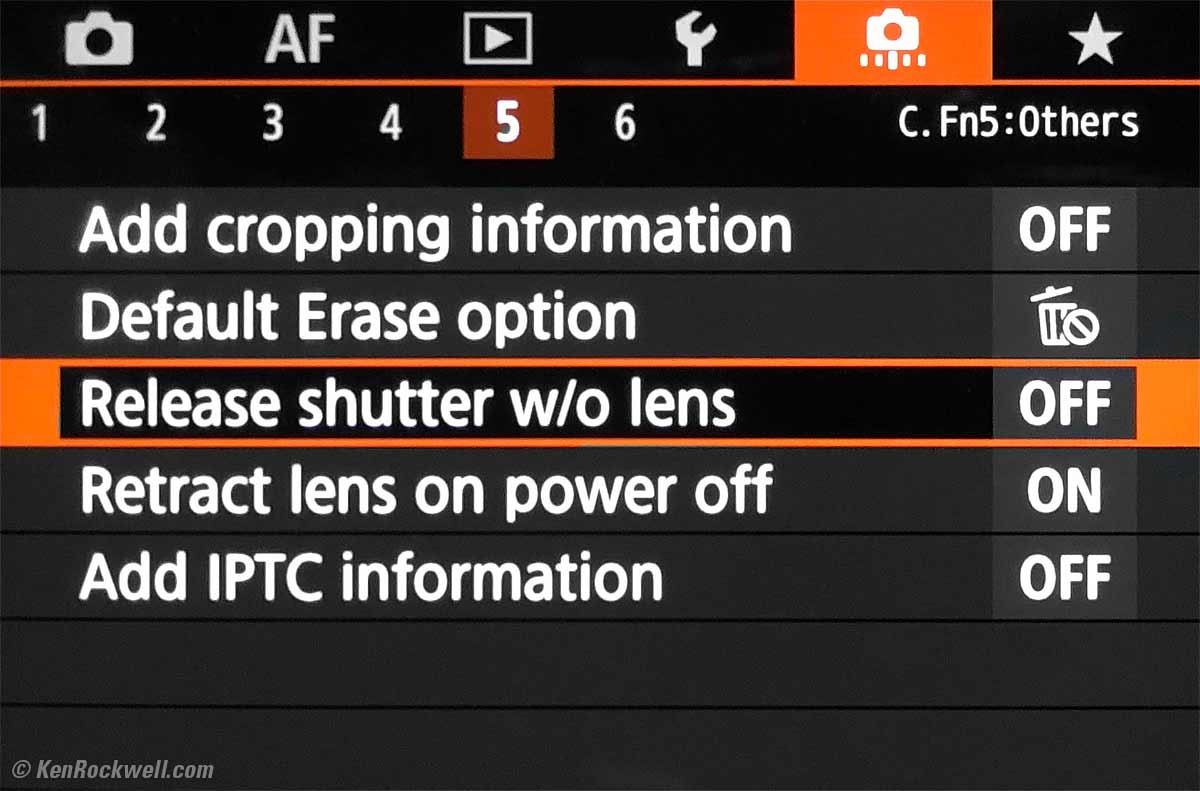 |
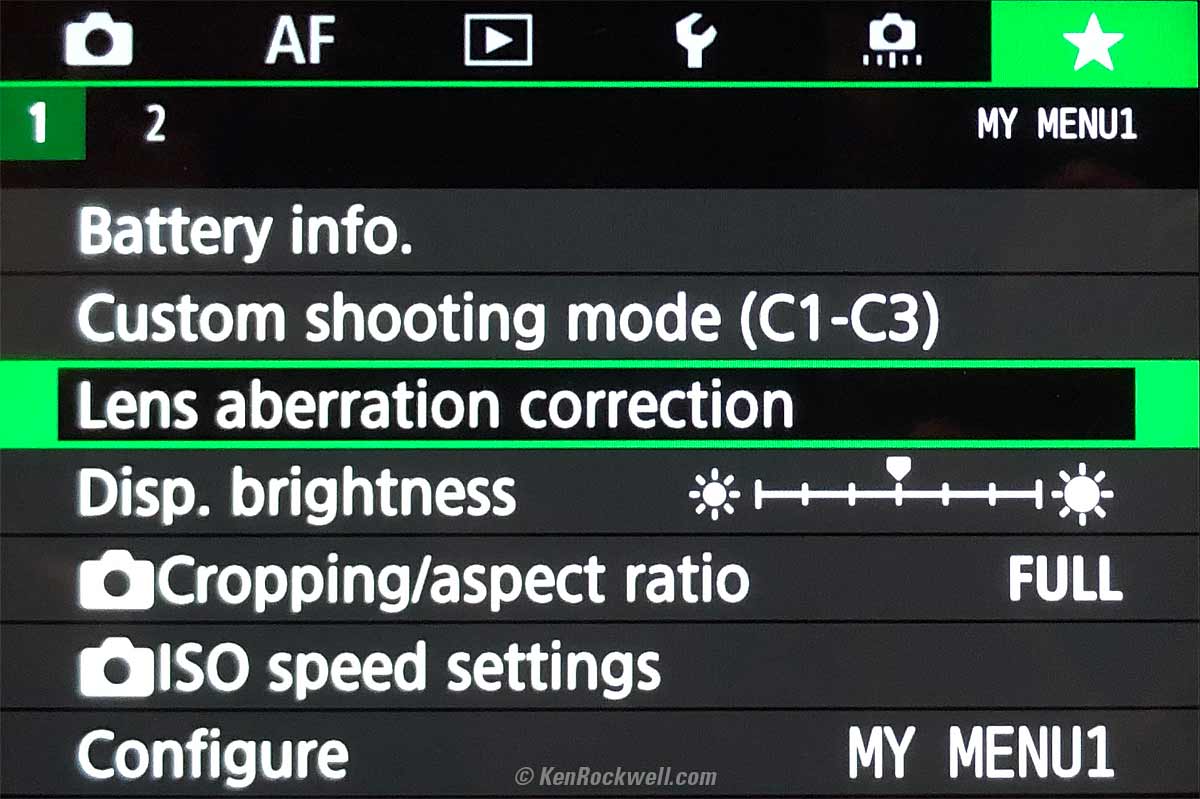 |
Nikon's menu system is not color coded, but it is well organized. Nikon has very long pages requiring you to click up or down through each individual line to get around inside each of Nikon's menu categories; there is no one-click navigation as there is on Canon.
Sony's menu system is awful. Everything is both disorganized and all the same color. We never can find anything in Sony's menu system.
Silent Shooting
It can be set to be completely silent, although the silent mode is more limited than in Sony's newest cameras, at least as of firmware v 1.0.0 in September 2018.
Mirrorless cameras have no mirrors, so there is little to no sound or vibration even with the regular mechanical shutter.
In silent mode you only can shoot in single frame mode (not continuous), and you can't use flash, can't shoot in HDR and can't use flicker avoidance (reduction).
Canon will have new firmware to allow continuous shooting, but no mirrorless camera works with flash in silent mode.
Even in regular shutter mode it's pretty quiet, and the shutter only makes a sound at the end of long exposures; the first curtain is always electronic.
Image Stabilization
Image Stabilization (IS or Vibration Reduction (VR)) only works in the lens, and also in the camera electronically for movies. There is no sensor shifting as that never works well with wide lenses; in-lens IS is superior.
Top LCD
The top LCD is now a sharp dot-matrix display. It is usually very visible, more visible than DSLR displays were. Even with the camera turned off, the top LCD continues to show the shooting mode:
Canon EOS R. bigger.
Tap the light (☀) button to swap between basic and detailed displays.
It's usually white-on-black as shown, but if you hold the light (☀) button a couple of seconds, it reverts to black-on-white and has a dim cool-white backlight.
It's very legible in most light, and its graphics are big and bold as you make settings:
Canon EOS R top LCD as seen in dull light. bigger.
Rear LCD Monitor
It flips and is a touch screen.
It flips 180º so you can do self-portraits.
It has only manual brightness control, but if you set it to high brightness, it looks great even in direct sunlight.
Playback
Same as always for Canon.
You can swipe the touch screen to scroll around zoomed images, but you have to keep swiping to get from side to side of a magnified image. You can't do it with one flick.
Unlike iPhones, scrolling around a zoomed image doesn't keep moving as you lift your finger; there is no inertia. You have to use multiple swipes to get across a zoomed image.
Data
Cards are formatted as "EOS_DIGITAL."
JPG file sizes vary with subject complexity.
Most LARGE NORMAL JPGs are about 5 MB, while simple images with mostly flat areas (like the sky) may be as small as 2 MB and very sharp, complex images loaded with strong, fine textures everywhere may be as big as 13 MB. Of course smaller resolutions will be smaller and FINE JPGs or raw files will be bigger.
They are tagged as 72 DPI.
Power & Battery
I get about 700~1,000 shots per charge, and up to 7,000 or more if I'm making long continuous sequences:
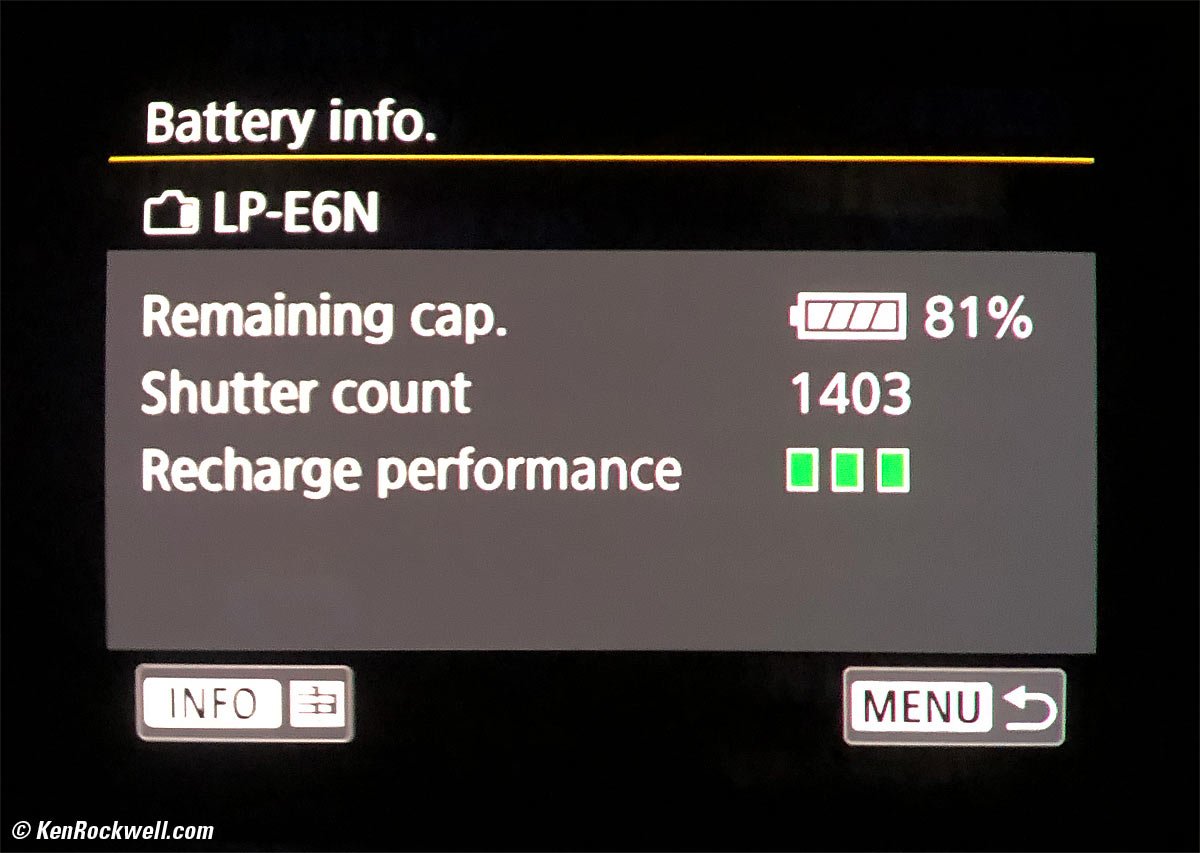
Canon EOS R battery life in constant continuous shooting.
It only gives a few hundred shots per charge if you fiddle with menus and settings a lot when you first get your EOS R.
With mirrorless that the sensor and processors all need to be running full speed all the time you're simply looking through and framing your shots, while a DSLR only really turns on to take the picture. The more time you spend looking rather than shooting, the fewer shots per charge you get.
A DSLR usually gets between about 800 ~ 3,000 shots per charge depending on how much fiddling versus shooting you do, I'm seeing between about 300 ~ 7,500 shots per charge with the EOS R.
See the display above? I still have 81% left after over 1,400 shots made on this charge. Algebra tells us that 1,402/(1-0.81) = 1,402/0.18 = 1,402 x 5.26 = 7,379 shots at 0%. I did this shooting action where I was letting the EOS R motor away in continuous drive for stretches of a hundred shots or so at a time trying to photograph Hawaiian fire dancers.
Clock Accuracy
Every sample is different, and my sample gains about 12 seconds per month.
Compared
Top Sample Images Intro Lens Compatibility
Adapters Specs Accessories Performance
Compared User's Guide Recommendations More
EOS R & RF 24-105L kit: $2,845 at Amazon.
About $900 used if you know How to Win at eBay.
NEW: Canon EOS R vs EOS R8 vs RP
Canon EOS R, RP, R5 & R6 Compared.
Nikon vs Canon vs Sony Full Frame Mirrorless Compared.
Versus Sony
Sony is a generation ahead with core technology for silent shooting. With the A7 III we can shoot in total silence at a good 10 frames per second with full tracking AF and exposure. The A7 III also seems to look about a stop better at completely insane ISOs around ISO 102,400; but I never shoot at those ISOs.
However, I prefer the EOS R because the pictures look better and it's so much more pleasant to use.
The Canon closes its shutter when off or with no lens, while the Sonys have dirt problems because they inexplicably leave their shutters open when off. After a few weeks with each Sony I'm getting dirt on my sensor which shows up in my Sony pictures, and the EOS R has no dirt problems. The Sonys are the only cameras I've used in the past ten years that have problems with sensor dirt; my Nikons and Canons have self-cleaned their sensors and I've not had a problem since 2007.
Color is a personal preference, but if you're an artist like me whose work is all about color, I prefer the colors I get out of my EOS R and other Canons to the more blah color I get from my Sonys. I get great results from Sony, but when I shoot Canon I'm even happier with my results. I shoot with the colors cranked way up in saturation on all my cameras; your tastes will differ. Color interpretation is everything in photography, and I prefer Canon and Nikon over Sony.
The EOS R feels great in hand with a mature, comfortable curved industrial design. Sony on the other hand has no serious industrial design; it's all flat surfaces and 90º angles like a VCR. The Sony quickly becomes uncomfortable to shoot since buttons and dials aren't really where we want them to be, while the EOS R has everything exactly as it should be to feel best.
It's easy-to-locate buttons by feel on the EOS R. Not only are the buttons themselves easy to feel, the curved design puts each button in a unique location so we know where they are — each one feels different. Sony buttons are too often flush and not easy to find by feel, and the all-flat design means all locations (and buttons) feel the same so it's much more difficult to find them quickly by feel.
The EOS R has a superior color-coded menu system, best in the industry, so it's easy to remember where things are. We don't have to look everywhere as we do with Sony.
Versus Nikon Z6 & Z7
Canon takes much better care of us while Nikon seems to look at its customers as annoyances.
The EOS R works great with all EF lenses while the FTZ adapter only autofocuses with about half of Nikon's lenses. Canon's support at (800) OK-CANON is in the USA and superb, while I never can seem to get answers at Nikon's support line.
Versus the Canon 5DS/R and other DSLRs
Canon EOS R and Canon 5DS/R. bigger.
Canon EOS R and Canon 5DS/R. bigger.
Canon EOS R and Canon 5DS/R. bigger.
Ground glass is so 1950s. You can't magnify ground glass with a push button, it gets dark at night and with slow zooms, it can't show playback so you have to squint at a little rear LCD in daylight, and you can't set menus through a DSLR finder either.
DSLRs have no silent mode for regular shooting.
DSLRs can't autofocus anywhere but near the center.
Direct on-sensor AF detectors in the EOS R give far more precise and accurate autofocus, especially with fast f/1.2 and f/1 lenses. These lenses don't give perfect focus every time on DSLRs, but they do (if you use then correctly) on the EOS R.
The EOS R corrects distortion and falloff and has a digital lens optimizer to counteract coma, lateral color fringes, diffraction and more, while the 5DS/R only corrects falloff and lateral color fringes. The 5DS/R can't correct distortion or other effects, and the EOS R does this even with EF lenses on adapters.
The EOS R has a slightly bigger finder than my 5DS/R, and the EOS R finder is brighter under most conditions, especially indoors and at night.
Heck, now that I have a Canon EOS R, even indoors, my 5DSR finder looks dim and dingy by comparison. At night where my 5DSR finder is black I can still see what's going on in my EOS R finder. Bravo!
Recommendations
Top Sample Images Intro Lens Compatibility
Adapters Specs Accessories Performance
Compared User's Guide Recommendations More
As of 2024 the EOS R has been discontinued. I'd suggest the newer and far superior EOS R6 Mk II instead.
Can you tell I love it? Be sure also to get the EF lens adapter of your choice. I don't know that you'll need a spare LP-E6N battery; the battery life is so good it will be hard to run it all the way down in just a day.
EOS R & RF 24-105L kit: $2,845 at Amazon.
About $900 used if you know How to Win at eBay.
Lenses
Do-Everything
The new Canon RF 24~240mm does everything extremely well. It covers every reasonable focal length, has great image stabilization and focuses super close.
Pro Quality
I love the superb Canon RF 24-105mm f/4L IS, but it costs more than the 24~240mm.
I used it for all the regular shots in this review, and it does everything I need a lens to do. The 24-105L is a pro-grade lens, and if you're wiling to get it, you will never be disappointed. It will serve you for years and you won't be tempted to buy something new in a few years to replace it — even if you buy a pro mirrorless body. The 24-105L is reasonably light and has ultra-high performance — but it costs almost as much as the EOS RP body! That's OK, since the smart money is always spent on lenses. Lenses don't go obsolete, unless you buy Nikon lenses.
Low Price, High Quality
The EF 24-105 STM is a smaller, lighter, slower, much less expensive and lighter-duty version of the professional RF 24-105mm f/4L IS.
The EF 24-105 STM is optically superb.
Not only is the EF 24-105 STM an inexpensive optical marvel, it also works on every 35mm and digital camera made by Canon since 1987, and the kit often includes an EF Adapter so that you can use every Canon EF lens ever made since 1987 on your EOS RP.
If you want to go even cheaper, a pro secret is that you can get superb used Canon EF lenses and use them on an EF lens adapter for next to nothing! Better than when these older EF lenses lenses were new and used on film, today's Canon digital cameras electronically optimize their performance and make these lenses work better today than they ever did on film.
Don't tell anyone, but one of my very favorite Canon lenses is the EF 28-135mm IS which covers more range than a 24-105mm, has stabilization and more than good enough optics, weighs only 3/4 as much as the RF 24-105mm f/4L and sells for only about $100 used if you know How to Win at eBay!
How good is this old 1990s lens? Here's a sample from my old Canon EF 28-135mm IS on an adapter on my EOS R:
Tree. Canon EOS R, Canon EF 28-135mm IS on adapter at 100mm, 1/200 at f/8 at Auto ISO 100, Perfectly Clear. bigger, full-resolution or camera-original © file.
Another favorite for small size, low weight and versatility is my Canon EF 28-105mm USM II. It sells for about $70 used if you know How to Win at eBay, and weighs only about half of the RF 24-105mm. It has no stabilization and otherwise is a great little lens with plenty of performance in a tiny package, helped out by the EOS RP's electronic lens corrections. Just look at this sample file shot on a 5D Mark III. Looks great!
These low-cost lenses take super sharp pictures if you know what you're doing, just that they won't take as much physical and environmental abuse as the L lenses. I take care of my gear so these inexpensive lenses bought used have served me well for many years.
Flash
The EOS R works perfectly with all EX-series flash. It has the same flash system as Canon's SLRs and DSLRs.
You can save money with old used flash that work as well as the newest flash; I use my 580EX II (about $125 used if you know How to Win at eBay) when I want a lot of power, or my 320EX (about $80 used if you know How to Win at eBay and also available used at Amazon) when I'm traveling light.
This junk-free website's biggest source of support is when you use those or any of these links to approved sources when you get anything, regardless of the country in which you live. Canon does not seal its boxes in any way, so never buy at retail or any other source not on my personally approved list since you'll have no way of knowing if you're missing accessories, getting a defective, damaged, returned, non-USA, store demo or used camera. I use the stores I do because they ship from secure remote warehouses where no one gets to touch your new camera before you do. Buy only from the approved sources I use myself for the best prices, service, return policies and selection.
Thanks for helping me help you!
Ken Rockwell
More Information
Top Sample Images Intro Lens Compatibility
Adapters Specs Accessories Performance
Compared User's Guide Recommendations More
EOS R & RF 24-105L kit: $2,845 at Amazon.
About $900 used if you know How to Win at eBay.
Canon's EOS R System White Paper.
Nikon vs Canon vs Sony Full Frame Mirrorless Compared.
Canon's EOS R System brochure.
© Ken Rockwell. All rights reserved. Tous droits réservés. Alle Rechte vorbehalten.
Help Me Help You
I support my growing family through this website, as crazy as it might seem.
The biggest help is when you use any of these links when you get anything. It costs you nothing, and is this site's, and thus my family's, biggest source of support. These places always have the best prices and service, which is why I've used them since before this website existed. I recommend them all personally.
If you find this page as helpful as a book you might have had to buy or a workshop you may have had to take, feel free to help me continue helping everyone.
If you've gotten your gear through one of my links or helped otherwise, you're family. It's great people like you who allow me to keep adding to this site full-time. Thanks!
If you haven't helped yet, please do, and consider helping me with a gift of $5.00.
As this page is copyrighted and formally registered, it is unlawful to make copies, especially in the form of printouts for personal use. If you wish to make a printout for personal use, you are granted one-time permission only if you PayPal me $5.00 per printout or part thereof. Thank you!
Thanks for reading!
Ken Rockwell.
